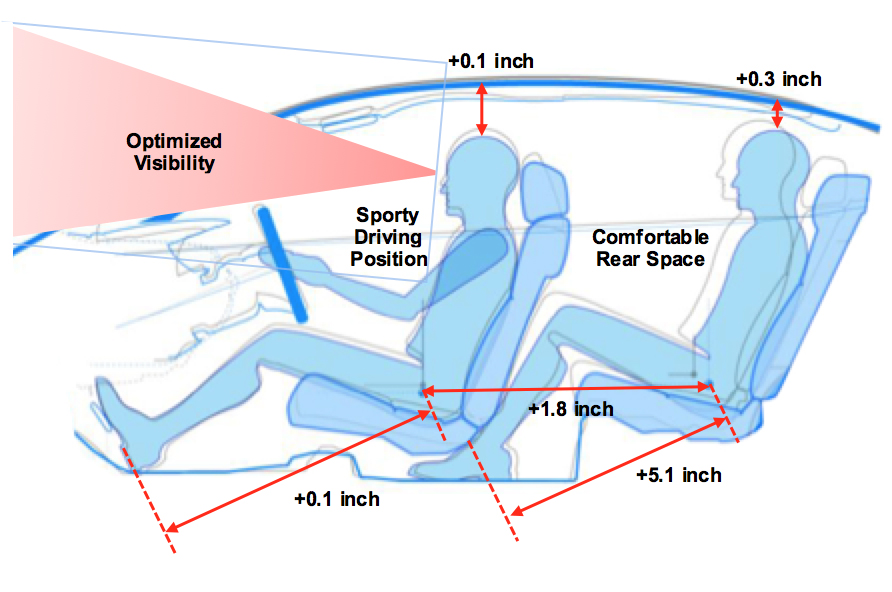2016 Honda Coupe Overview Plus Complete Specs, Accessories, Safety Features, Interior Details, Body Details, Audio and Connectivity
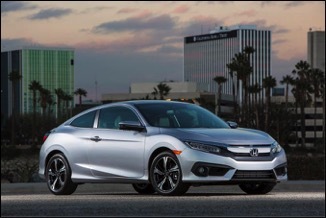 2016 Honda Civic Coupe |
Auto Central, February 22, 2016; The creation of the new 10th-generation Honda Civic represents one of the most comprehensive and ambitious new-model developments ever undertaken by Honda, requiring an unprecedented commitment of R&D resources and Honda engineering prowess. While the development of the Honda Civic Coupe, together with the Civic Sedan, was led by a North American team – a first for Honda and Civic – the overall Civic series involves design and engineering teams from Honda R&D, as well as sales and manufacturing operations from around the world, especially in North America and Japan, but also in Europe, South America and Asia.
In seeking to realize a "dynamic rejuvenation" of Civic and create a new interpretation "in a league of its own," as the development team defined its mission, Honda engineers set out early during platform development to benchmark the world's best C-segment vehicles—not only products in Civic's traditional competitive set, but luxury compact class vehicles as well.
Their evaluation of the world's best products involved extensive real-world testing, ultimately targeting European luxury vehicles for the new Civic's ride, handling, steering and NVH (noise, vibration and harshness), and also its interior quality and refinement.
Achieving these lofty aims while meeting requirements for an affordable compact car, in terms of cost, fuel efficiency and manufacturability, stretched the limits of the global Civic team's engineering capability and demanded new thinking and new approaches to body construction, vehicle aerodynamics, powertrain and chassis design. The result of these efforts is a completely reimagined and reinvented new Civic, the sportiest Civic ever, and a new benchmark in the compact class in terms of spaciousness, fuel efficiency, safety features, interior quality and dynamic performance.
With many design features introduced on the Civic Sedan, the Civic Coupe takes the sporty styling and dynamic capabilities of the sedan even further for a unique performance coupe experience that is both stylish and fun to drive, but also surprisingly spacious for its compact exterior and feature packed. The new Civic Coupe is athletic, charismatic and connected.
What's New?
Virtually everything about the 2016
Civic Coupe is new – an all-new vehicle architecture, sporty and
sophisticated new interior and exterior styling, a more spacious and
high-quality cabin, two advanced new engines, and a host of new premium
features and technologies.
Further, with the addition of Honda Sensing™ safety and driver-assistive technologies on the Touring trim and the first application of Honda turbo engine technology to Civic on the EX-T and above trims, the 2016 Civic Coupe offers buyers a wider range of options than ever before. Civic models powered by the new 2.0-liter i-VTEC™ engine are designated as the Civic LX and LX-P trims. Civic models powered by the new turbocharged 1.5-liter engine are designated as the EX-T, EX-L (with leather-trimmed interior) and new line-topping Civic Touring, which reaches higher into the upper end of the compact car market than ever before.
Major new technologies, features and capabilities of the 2016 Civic Coupe, depending on trim, are as follows:
Powertrains
- Turbocharged 1.5-liter DOHC direct-injected engine
- 2.0-liter DOHC port-injected i-VTEC engine
- Class-leading anticipated EPA fuel economy ratings of 31/41/35 mpg (city/highway/combined)1 for models with 1.5-liter turbo and CVT, 30/41/34 mpg1 for models with the 2.0-liter engine and CVT and 26/38/31mpg1 for the LX with the 2.0-liter engine and manual transmission.
Body
- Ultra-rigid body with 63 percent application of high-strength steel and 12 percent application of ultra-high-strength steel (up from 55 percent and 1 percent, respectively, in the previous model) – the most extensive use of high-tensile steel ever in a Civic
- 76 pound reduction in unibody weight versus the previous Civic Coupe, despite its larger size and greater stiffness
- ACE™ body structure with new crash stroke design (Honda and Civic first) for improved collision performance in a sportier, more compact front frame design
- Ultra-rigid 590-MPa high-strength-steel floor for enhanced collision performance and improved ride quality (Civic first)
- Most tightly sealed Honda body ever, with a 75 percent improvement in air leak performance over the previous model
- Premium noise isolation materials and design features that combine with the tightly sealed body for cabin quietness that challenges luxury-class compact-segment products
Chassis
- New multi-link independent rear suspension
- Hydraulic compliance bushings for premium levels of ride quality and road vibration isolation (Civic first)
- Larger stabilizer bars with bonded bushings for more refined body control (Civic first)
- Rigid aluminum rear damper brackets for improved ride quality (Civic first)
- Agile Handling Assist brake torque vectoring for cornering precision and stability (Civic first)
- Dual-pinion electric power steering with variable gear ratio for improved steering feel and maneuverability (Civic first)
Exterior
- Available LED exterior lighting
- Complete underbody covering for fuel efficiency and cabin quietness
- Flush mounted, acoustic glass windshield
- Capless refueling
Interior
- 91.0 (LX) and 88.6 (EX-T and above) cubic-feet of passenger volume (+7.8 cubic feet vs. previous Civic Coupe) – amongst the most spacious cabins in the compact class
- New ultra-thin A-pillars for enhanced forward visibility
- Premium, soft touch cabin materials exceeding current class standards
- Available Display Audio touchscreen with Android Auto™2 and Apple CarPlay™3
- Available Premium comfort and convenience features including Remote Engine start, Smart Entry with Push Button Start, electronic parking brake, dual-zone automatic climate control and rain-sensing wipers
Safety and Driver Assistance
- Honda Sensing™ safety and driver-assistive technologies
- Next-generation ACE™ body structure
- New crash stroke front frame design
- Ultra-rigid 590-MPa high-strength steel floor for enhanced collision performance
- Targeted highest-available collision performance safety ratings – a 5 star Overall Vehicle Score in the NHTSA's NCAP, a TOP SAFETY PICK from the IIHS for the LX through EX-L trims and a TOP SAFETY PICK+ from the IIHAS for the Touring trim.
Design and Packaging
In designing the new Civic,
Honda designers and engineers sought to deliver a sportier and more
premium-quality Civic that recaptures the sporty proportions and athletic
stance of earlier Civics while thoroughly advancing Civic design into the
future. The 2016 Civic Coupe is lower and wider with short front and rear
overhangs and larger wheels and tires that create a more sporting
wheel-to-body relationship.
Key Exterior Specifications – 9TH to 10th Generation Difference
Specification |
2016 Civic EX-T Coupe |
2015 Civic EX Coupe |
Change |
|
Length (in) |
176.9 |
177.9 |
-1.0 |
|
Width (in) |
70.8 |
69.0 |
+1.8 |
|
Height (in) |
54.9 |
55.0 |
-0.1 |
|
Wheelbase (in) |
106.3 |
103.2 |
+3.1 |
|
Track (in) |
60.9/61.5 |
59.0/59.9 |
+1.9/+1.6 |
|
Front overhang (in) |
35.2 |
36.6 |
-1.4 |
|
Rear overhang (in) |
35.2 |
38.2 |
-3.0 |
|
Wheel/tire size |
215/50R17 |
205/55R16 |
+10/-5/+1 |
Key Exterior Specifications – Civic Coupe to Civic Sedan Difference
Specification |
2016 Civic EX-T Coupe |
2016 Civic EX-T Sedan |
Change |
|
Length (in) |
176.9 |
182.3 |
-5.4 |
|
Width (in) |
70.8 |
70.9 |
-0.1 |
|
Height (in) |
54.9 |
55.7 |
-0.8 |
|
Wheelbase (in) |
106.3 |
106.3 |
0 |
|
Track - Front/Rear (in) |
60.9/61.5 |
60.9/61.5 |
0 |
|
Front overhang (in) |
35.2 |
35.2 |
0 |
|
Rear overhang (in) |
35.2 |
40.6 |
-5.4 |
|
Wheel/tire size |
215/50R17 |
215/50R17 |
0/0/0 |
(See the Specifications and Features section for all data.)
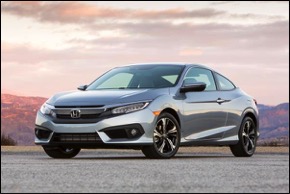
Exterior Design
Engineering and design merged to
develop the Civic Coupe body, embracing both fundamental physics such as
inertia and a sporty character like a hot three-door hatchback. The taut,
tidy and sporty overall proportions of the new Civic Coupe are complemented
and accentuated by its performance inspired design details, including its
sleek, swept-back bodylines, its sharp and aggressive face, and its bulging
wheel arches. The hood features sharply defined character lines that draw
the eye forward and down to the Civic's aggressive new face, highlighted by
a chrome-plated Honda "wing" that runs the full width of the front fascia
and is flanked by available new LED headlights in an in-line
configuration.
The new Civic's ultra-thin A-pillars lend the cabin an open, airy feeling with excellent forward visibility, while the aggressively sloped roof line connects seamlessly with gracefully arching C-pillars that carry the curvature of the roof rearward to the outside rear corners of the long deck, where they intersect with distinctive C-shaped "light-pipe" LED taillights forming a continuous line across the rear.
The sharply creased and curving upper-body side line swells over the rear wheel arches and curves aggressively inward to join the upper bend of the distinctive LED taillights, while the upswept lower-body side line is bisected by the bulging rear wheel arches before bending inward to meet up with the rear bumper's upper surface. The overall effect is one of dynamism and premium quality with an unmistakable and yet thoroughly modern Civic design aesthetic.
Interior Package
Honda's vehicle packaging
expertise, along with the Civic's longer wheelbase and wider body, results
in the most spacious interior in the competitive class. With 91.0 cubic
feet of available passenger space (LX) and 88.6 cubic feet (LX-P and above
trims), the 2016 Civic Coupe delivers top-of-class comfort by giving its
occupants a sense of spaciousness and premium comfort beyond the compact
class with ample headroom, legroom, shoulder clearance and side head
clearance.
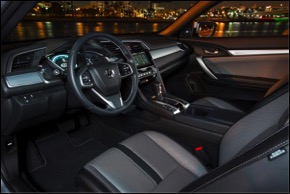
A class leading 84.3 degrees of forward visibility is aided by a new, ultra-thin A-pillar design, 18.2 mm (0.72 inch) narrower than the A-pillar in the outgoing 2015 Civic. Even the forward visibility of rear-seat occupants is taken into account, as the new Civic features newly shaped front seatbacks and a smaller head restraint.
More legroom for the driver is made possible by the reduced intrusion of the instrument panel into the driver's knee space, while rear-seat foot room is improved by a 27 mm (1.1 inches) wider space between the front seat rails. Trunk room has also been significantly increased, by 0.2 cubic-feet to 12.1 cubic-feet (LX), among the largest in the compact class, with a lower lift over height, larger rear opening, and wider and taller cargo area than the outgoing model. An all-new reconfigurable center console, with up to 7.2 liters of storage space, can hold multiple full-size tablets or an oversized water bottle with the console lid closed.
Key Interior Dimensions
|
Dimension |
2016 Civic EX-T Coupe |
2015 Civic EX Coupe |
Change |
|
EPA Passenger Volume (cu-ft.) |
88.6 |
82.6 |
+6.0 |
|
Cargo room (cu-ft.) |
11.9 |
11.7 |
+0.2 |
|
Headroom (front/rear) |
36.5 / 34.5 |
37.7 / 34.3 |
-1.2 / +0.2 |
|
Leg Room (in.) front/rear |
42.3 / 35.9 |
42.2 / 30.8 |
+0.1 / +5.1 |
|
Shoulder room (in.) front/rear |
56.9 / 52.6 |
55.1 / 52.2 |
+1.8 / +0.4 |
|
Hip room (front/rear) |
54.1 / 48.1 |
53.2 / 49.0 |
+0.9 / -0.9 |
(See the Specifications and Features section for all data.)
Interior Design
The completely new interior of the
2016 Civic Coupe is designed to have the same exciting, modern and
sophisticated exterior styling while providing enhanced comfort,
leading-edge technology and class-leading quality. The 2016 Civic Coupe
takes Civic interior quality to a new level. High quality,
soft-to-the-touch materials are applied liberally—to the instrument
panel, front door sash and door inserts and the larger, more thickly padded
center armrest. Fit, finish and materials quality throughout the cabin have
been thoroughly modernized and upgraded in keeping with the more premium
and sporty compact coupe character of this all new Civic.
Interior Comfort, Convenience and Connectivity
The
new Civic is designed to be the most comfortable, convenient and connected
Civic ever. In addition to its more spacious interior, the 2016 Civic Coupe
incorporates new, available premium comfort and convenience features
– all Civic firsts – as follows:
- Remote engine start
- Electronic parking brake
- Walk away door locking
- Dual-zone automatic climate control
- Heated front seats
- Rain-sensing wipers
Display Audio with Apple CarPlay™ and Android Auto
Raising intuitive operation and digital connectivity to the next
level, the 2016 Civic Coupe in EX-T and above trims incorporates a new
7-inch Display Audio touchscreen that serves as the nerve center for
control of audio, HVAC and other functions. The new Display Audio is
integrated with new Apple CarPlay™3 and Android Auto™2
platforms, providing seamless integration of smartphone features and
functions, including app-based navigation, streaming audio,
voice-controlled search capabilities, and access to a host of Apple- or
Google-approved smartphone apps.
Dynamic Performance
Civic is designed to set a new
bar for dynamic performance in the mainstream compact class, surpassing
current offerings and even challenging luxury-class C-segment vehicles in
critical areas of dynamic performance such as steering feel, handling
precision, ride quality and NVH. With respect to its mainstream,
compact-class competitors, Civic is designed to deliver superior dynamic
performance in virtually every way, including acceleration and braking
performance, refined and linear power delivery, fuel efficiency, steering
precision, body control, aerodynamics and NVH. Every element of its design
and technology has been optimized to this task.
Powertrain
Powering the 2016 Civic Coupe are two
all-new engines, first introduced in the Civic Sedan, that were both
designed to provide highly refined, responsive and fuel-efficient
performance. Civic Coupes in LX and LX-P trim are powered by a 2.0-liter
DOHC, 16-valve, port-injected, inline 4-cylinder engine with
i-VTEC™ valvetrain producing a peak 158 hp at 6,500 rpm and
138 lb-ft. of torque at 4,200 rpm, making it the most powerful base engine
ever offered in Civic. The new 2.0-liter engine is mated to a sporty
continuously variable transmission (CVT) with Honda G-Design shift control,
or on the LX trim, a quick-shifting 6-speed manual transmission.
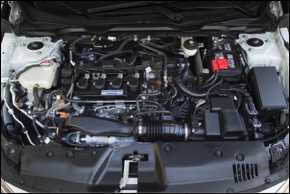
Civic Coupes in EX-T, EX-L and Touring trim are powered by an all-new turbocharged 1.5-liter DOHC, direct-injected 4-cylinder engine with variable cam timing (VTC) and electronic wastegate, turning out 174 hp at 6,000 rpm and peak torque of 162 lb-ft. from 1,700 to 5,500 rpm. The 1.5-liter turbo engine is mated to a new CVT that combines with the low-inertia turbo, VTC and electronic wastegate to optimize power delivery across the engine's full operating range.
Both engines feature a wide array of friction-reduction design and engineering features that support both high performance and high fuel efficiency. These two ultra-efficient engines, married to the 2016 Civic's light, rigid and highly aerodynamic body, help the Civic garner anticipated class-leading EPA-estimated fuel economy ratings of 30/41/34 mpg (city/highway/combined)1 for the 2.0-liter engine with CVT, 26/38/31mpg1 for the LX with the 2.0-liter engine and manual transmission, and 31/41/35 mpg1 for the 1.5-liter turbo with CVT.
Body
The 2016 Civic Coupe's new powertrains and
sophisticated chassis design are underpinned by its entirely new body
construction, where engineers went deeper in the study of dynamic body
rigidity to realize an ultra-rigid platform architecture that serves as the
foundation for its more sophisticated chassis design, its class-leading
collision performance, and its powerful and fuel-efficient powertrains.
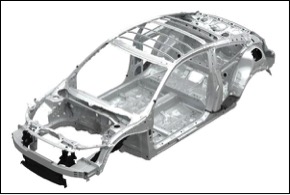
Global bending and torsional rigidity are increased with specifically localized body rigidity tuning in key areas, especially at suspension and subframe mounting points which are dramatically improved.
Key Elements of Civic Body Design:
- 63% application of high-strength steel, the highest in Civic history
- 12% application of ultra-high-strength steel (780 MPa or higher), the highest in Civic history
- New 590-MPa high-strength steel floor for dynamic and collision safety performance
- 20mm "short pitch" door seam welds for enhanced collision performance
- Next-generation ACE body structure with new crash stroke front frame rails (Honda first) for enhanced collision performance in a more compact front frame
Key Body Specifications
Specification |
2016 Civic EX-T Coupe |
2015 Civic EX Coupe |
Change |
|
Curb weight (lbs.) |
2899 |
2863 |
+1.3% |
|
CdA |
N/A |
N/A |
-12.5% |
|
High-strength steel |
63% |
55% |
+12% |
|
Ultra-high strength steel |
12% |
1% |
+11% |
(See the Specifications and Features section for all data.)
Class-Leading Aerodynamics
The new Civic's sleeker body
design combines with aerodynamic features, including nearly full underbody
covering, front and rear wheel strakes, optimized rear exhaust silencers
and a highly aero-efficient engine compartment, to create the most
aerodynamically efficient body in the compact class. The 2016 Civic Coupe's
Cd*A – the combination of coefficient of drag (Cd) and frontal area
(A) – is improved by 12.5 percent over the outgoing Civic to
best-in-class levels, based on Honda internal test data. The Civic aero
design was optimized using a combination of advanced CFD (computation fluid
dynamics), and wind tunnel testing of highly detailed 25- and 40-percent
scale models and a full-scale model.
Chassis
Building on the foundation of its
ultra-rigid and lightweight body structure, the 2016 Civic Coupe utilizes
the most sophisticated chassis design in the history of Civic. Its fully
independent suspension includes an all-new multi-link rear design mated to
a rigidly-mounted rear subframe for a high degree of lateral stability.
Front and rear hydraulic compliance bushings, a feature typically reserved for larger or more expense vehicles, are also utilized on Civic, improving ride compliance and reducing road vibrations without compromising sporty handling feel. The new Civic Coupe also applies bonded front and rear stabilizer bushings for smoother and more progressive anti-roll behavior. And Civic's new dual-pinion electric power steering with variable gear ratio provides for more precise steering control and feel—with only 2.2 turns lock-to-lock (vs. 2.87 turns on the previous model) for greatly improved low-speed maneuverability.
The new Civic Coupe's wider track, by 1.9 inches at the front and 2.5 inches at the rear, and 0.39 inch wider tire tread, compared to previous Civic Coupe, aid flat handling and lateral grip, while its 3.1 inch longer wheelbase improved ride quality on undulating or rough road surfaces. The Civic also applies Agile Handling Assist for the first time, using the VSA4 system to apply the brake of the front inside wheel at the entry to a corner, improving cornering attitude, stability and precision.
Key Elements of Civic Chassis Design:
- Dual pinion electric power steering
- Variable gear ratio steering
- Multi-link independent rear suspension
- Electronic parking brake
- Agile Handling Assist
- Wider track (+1.9 inch front, +2.5 inch rear)
- Wider tire tread (+0.39 inch)
Noise, Vibration and Harshness (NVH)
Engineers for the new
Civic adopted premium noise-isolating materials and design features to
achieve a new level of cabin quietness in the compact class. This includes
the adoption of new methods to measure and reduce air leaks in the Civic
body that, based on Honda's internal test data, is the most tightly sealed
body in the competitive class. Full body air leaks have been reduced 75
percent compared to the previous Civic Coupe.
Premium noise reduction features include:
- Acoustic glass front windshield
- Triple door sealing
- New hood seals
- Sound-absorbing heat baffles and body undercovers
- A and B pillar separators
- New rear wheel house liners
- Formed fiber carpeting
Safety and Driver Assistance
The 2016 Civic Coupe
is designed to provide a high level of collision safety performance in a
wide variety of collision scenarios, including offset and oblique-angle
frontal collisions as well as side and rear impacts. The Civic's safety
performance starts with its class-leading forward visibility and precise,
stable and predictable steering, handling and braking performance. Standard
four-channel anti-lock brakes (ABS) with Electronic Brake Distribution
(EBD), Vehicle Stability Assist (VSA)4 with traction control and
Agile Handling Assist further enhance dynamic stability and emergency
maneuvering and braking performance.
Honda Sensing™
Standard on the Civic Touring
Coupe, Honda Sensing safety and driver-assistive technology can further
reduce the potential for a collision and mitigate the consequences,
alerting the driver and taking emergency action when a collision is
determined to be imminent. Honda Sensing™ uses both millimeter wave
radar and a monocular camera to sense and respond to detected road hazards.
The Civic Honda Sensing technology suite includes Adaptive Cruise Control
with Low Speed Follow. Honda Sensing features include the following:
- Collision Mitigation Braking System (CMBS)5
- Lane Departure Warning (LDW)6 integrated with RDM
- Forward Collision Warning (FCW)7 integrated with CMBS
- Adaptive Cruise Control (ACC) with Low Speed Follow8
- Lane Keeping Assist System (LKAS)9
- Road Departure Mitigation (RDM)10
All Civics come equipped with a Multi-Angle Rearview Camera11 and Expanded View Driver's Mirror.
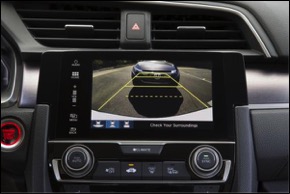
Advanced Safety Body
The 2016 Civic utilizes its
advanced body structure – including its next-generation Advanced
Compatibility Body Structure (ACE), new crash stroke technology and a
590MPa high-strength steel floor – to provide a high degree of
occupant protection while minimizing weight and aiding fuel efficiency.
Engineers were challenged not only to create a body that supported their goals for dynamic performance, but also for top-in-class collision performance. The adoption of a more compact front end and shorter front overhang proved to be an exceptional challenge to achieving their goals, effectively shortening the front frame's crash stroke (the area available to absorb and redirect frontal collision energy). To overcome this challenge and maintain the sporty proportions of the new Civic, engineers developed a new crash stroke design for frontal collisions. A new subframe linked attachment creates a mechanical hinge effect that directs the engine downward in a frontal impact, effectively increasing the front "crash stroke" by 80 mm (3.0 inches).
Advanced Airbag Technology
The Civic utilizes
advanced front, side and side curtain airbag technology, including a
driver's front airbag with new spiral stitching for an improved deployment
profile; SmartVent® technology for the driver and front passenger side
airbags; and a new front passenger airbag with safety vent technology that
can mitigate the possibility of injury from airbag deployment when the
passenger is "out of position." These systems work in conjunction with the
advanced body structure and optimally tuned interior components to help
mitigate injuries in a collision.
Utilizing these design features and safety technologies, the 2016 Civic Coupe targets the highest available crash protection ratings – a 5-Star Overall Vehicle Score in the NHTSA's New Car Assessment Program (NCAP), with top ratings in all test modes; and a TOP SAFETY PICK rating from the Insurance Institute for Highway Safety for LX through EX-L trims with a TOP SAFETY PICK+ rating for the Touring trim, with a score of GOOD in all test modes
Manufacturing
The 2016 Civic Coupe for the U.S.
market will be produced at Honda's plant in Ontario, Canada, using domestic
and globally sourced parts. Its two new engines are produced in Anna, Ohio,
at the largest automobile engine plant in Honda's global production
network, and its highly precise CVT transmissions are assembled in Russells
Point, Ohio, where two on-site wind turbines provide for upwards of 10
percent of the plant's power needs.
The new Civic also benefits from numerous advancements in manufacturing technology and process that enhance efficiency, quality and performance, as well as associate ergonomics.
Inner Frame Weld System
The 2016 Civic body is
welded using Honda's new inner-frame weld process, first utilized in
construction of the 2015 Fit. This new process produced a more rigid,
lightweight and higher quality body.
Modular Front Sub-Assembly
A new modular front
sub-assembly, a first for Honda, improves ergonomics for assembly-line
associates, giving them unfettered access to critical interior and front
end components before the front sub-assembly is joined to the body. This
process also helps to ensure a higher level of quality in the assembly
process.
Key New Features and Technologies by Trim
|
Features |
LX | LX-P | EX-T | EX-L | Touring | |
| Powertrain | 2.0L DOHC i-VTEC inline 4-cylinder engine | • | • | |||
| Turbocharged 1.5L DOHC DI inline 4-cylinder | • | • | • | |||
| Lighting | Halogen projector headlights with auto on/off | • | • | • | • | |
| LED headlights with auto on/off | • | |||||
| LED daytime running lights | • | • | • | • | • | |
| LED turn signals | • | |||||
|
Tail lights with integrated LED light bars |
• |
• |
• |
• |
• |
|
|
LED high mount stop light |
• |
• |
• |
• |
• |
|
|
Halogen fog lights |
|
|
• |
• |
• |
|
|
Exterior |
Smart Entry |
|
• |
• |
• |
• |
|
Walk Away Door Lock |
|
• |
• |
• |
• |
|
|
Smart wipers |
• |
• |
• |
• |
• |
|
|
Rain-sensing wipers |
|
|
|
|
• |
|
|
Capless refueling |
• |
• |
• |
• |
• |
|
|
Chassis |
Multi-link rear suspension |
• |
• |
• |
• |
• |
|
Dual-pinion EPS with variable steering gear ratio |
• |
• |
• |
• |
• |
|
|
Front and rear stabilizer bars with bonded bushings |
• |
• |
• |
• |
• |
|
|
Agile Handling Assist |
• |
• |
• |
• |
• |
|
|
Straight Driving Assist |
• |
• |
• |
• |
• |
|
|
Front lower suspension hydraulic compliance bushing |
• |
• |
• |
• |
• |
|
|
Rear trailing arm hydraulic compliance bushing |
|
|
• |
• |
• |
|
|
Premium sound insulation |
• |
• |
• |
• |
• |
|
|
P215/55R16 tires |
• |
• |
|
|
|
|
|
P215/50R17 tires |
|
|
• |
• |
• |
|
|
Interior |
Push button start |
|
• |
• |
• |
• |
|
Automatic climate control |
• |
• |
|
|
|
|
|
Dual-zone auto climate control |
|
|
• |
• |
• |
|
|
Electronic parking brake |
• |
• |
• |
• |
• |
|
|
Heated front seats |
|
|
• |
• |
• |
|
|
Display Audio touchscreen |
|
|
• |
• |
• |
|
|
Android Auto™2 / Apple CarPlay™3 |
|
|
• |
• |
• |
|
|
Safety & Driver Assistance |
ACE body structure with new crash stroke design |
• |
• |
• |
• |
• |
|
Front passenger airbag with safety vent |
• |
• |
• |
• |
• |
|
|
Driver front airbag with spiral stitch |
• |
• |
• |
• |
• |
|
|
Collision Mitigation Braking System |
|
|
|
|
• |
|
|
Lane Departure Warning |
|
|
|
|
• |
|
|
Forward Collision Warning |
|
|
|
|
• |
|
|
Lane Keeping Assist System |
|
|
|
|
• |
|
|
Adaptive Cruise Control with Low-Speed Follow |
|
|
|
|
• |
|
|
Road Departure Mitigation |
|
|
|
|
• |
|
(See the Specifications and Features section for all data.)
1 Preliminary mileage ratings determined by Honda. Final 2016 EPA fuel-economy ratings not available at the time of printing. Use for comparison purposes only. Your mileage will vary depending on how you drive and maintain your vehicle, driving conditions and other factors.
2 Android and Android Auto are trademarks of Google Inc.
3 Apple CarPlay is a registered trademark of Apple Inc.
Depending on use, Android Auto or Apple CarPlay™ can share certain user and vehicle information (e.g., vehicle location, speed and other operating conditions) with Google and its service providers or the connected iPhone, respectively. See Google's and Apple's privacy policies for details regarding the use and handling of data uploaded by Android Auto or Apple CarPlay™. Use of Android Auto or Apple CarPlay™ is at user's own risk, and is subject to agreement to the Android Auto or Apple CarPlay™ terms of use, which are, respectively, presented to the user when the Android Auto application is downloaded to the user's Android phone or included as part of the Apple iOS terms of use. Android Auto and Apple CarPlay™ vehicle integration is provided "as is," and Honda cannot guarantee operability or functionality now or in the future due to, among other conditions, changes in the applicable software or operating system, service interruptions, or incompatibility or obsolesce of vehicle-integrated hardware or software. See dealer for details. Only use Android Auto or Apple CarPlay™ when conditions allow you to do so safely.
4 VSA is not a substitute for safe driving. It cannot correct the vehicle's course in every situation or compensate for reckless driving. Control of the vehicle always remains with the driver.
5 CMBS cannot detect all objects ahead and may not detect a given object; accuracy will vary based on weather, speed and other factors. System operation affected by extreme interior heat. System designed to mitigate crash forces. Driver remains responsible for safely operating vehicle and avoiding collisions.
6 LDW only alerts drivers when lane drift is detected without a turn signal in use. LDW may not detect all lane markings or lane departures; accuracy will vary based on weather, speed and road condition. System operation affected by extreme interior heat. Driver remains responsible for safely operating vehicle and avoiding collisions.
7 FCW cannot detect all objects ahead and may not detect a given object; accuracy will vary based on weather, speed and other factors. System operation affected by extreme interior heat. FCW does not include a braking function. Driver remains responsible for safely operating vehicle and avoiding collisions.
8 ACC cannot detect all objects ahead and may not detect a given object; accuracy will vary based on weather, speed and other factors. ACC should not be used in heavy traffic, poor weather or on winding roads. The driver remains responsible to slow or stop the vehicle to avoid a collision.
9 LKAS only alerts drivers when lane drift is detected without a turn signal in use and can apply mild steering torque to assist driver in maintaining proper lane position. LKAS may not detect all lane markings or lane departures; accuracy will vary based on weather, speed and road condition. System operation affected by extreme interior heat. Driver remains responsible for safely operating vehicle and avoiding collisions.
10 Road Departure Mitigation only alerts drivers when lane drift is detected without a turn signal in use and can apply mild steering torque to assist driver in maintaining proper lane position and/or brake pressure to slow the vehicle's departure from a detected lane. Road Departure Mitigation may not detect all lane markings or lane departures; accuracy will vary based on weather, speed and road condition. System operation affected by extreme interior heat. Driver remains responsible for safely operating vehicle and avoiding collisions.
11 Always visually confirm that it is safe to drive before backing up; the rearview camera display does not provide complete information about all conditions and objects at the rear of your vehicle.
2016 Honda Civic Coupe Press Kit - Accessories
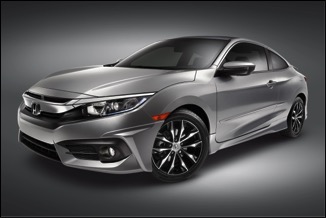
Overview
Honda developed a range of Honda Genuine Accessories simultaneously with the model to further enhance convenience and protection, to customize feature content and provide personalization opportunities for the 2016 Civic Coupe. Like all Genuine Honda Accessories, they are covered by the Civic's 3-year, 36,000-mile limited warranty when obtained and installed at the time of original vehicle purchase. Not all accessories listed are available for all trims.
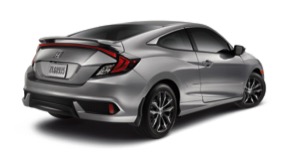
Available Accessories
All season floor mats
All season floor mats, high wall
Ambient lighting
Ashtray
Auto day/night mirror
Body side molding
Car cover
Cargo hook
Cargo net
Door edge guard
Door sill trim, illuminated
Door visors
Engine block heater
First aid kit
Fog lights
Illuminated console lighting
Lower door garnish, chrome
Moon roof visor
Nose mask
Rear bumper protector
Rear decklid spoiler
Rear seat cover
Rear wing spoiler
Remote engine starter, LX
Splash guards
Trunk tray
Underbody spoilers, Fr, Rr, Side
Wheel locks
Wireless charger
17-inch alloy wheels
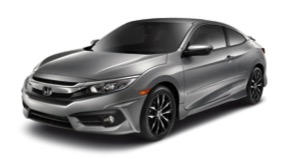
2016 Honda Civic Coupe Press Kit - Audio and Connectivity
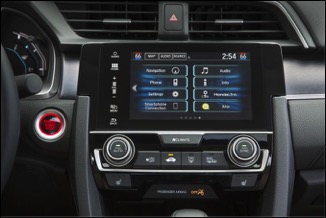
Overview
The new Civic significantly advances in-vehicle connectivity and audio performance with a new generation of advanced technologies. New available features include a 7-inch capacitive touchscreen Display Audio1 interface with Android operating system, and an all-new Honda Satellite-Linked Navigation System™2 developed in cooperation with the experts at Garmin®3. The Civic Coupe’s Display Audio system also enables simplified smartphone connectivity with a single cable connection. The available system is now compatible with the Apple CarPlay™4 and Android Auto™ platforms5, giving customers seamless integration of key smartphone features and functions, including smartphone-powered GPS navigation and voice-controlled search capabilities. Featuring standard Pandora®6 compatibility, streaming Bluetooth®7 audio and many other content choices, including available SiriusXM®8, Civic offers a rich selection of audio and connectivity options.
Key Available Audio and Connectivity Features
- 7-inch Display Audio touchscreen with integrated HVAC controls*^
- Android Auto™3 and Apple CarPlay™*4
- HondaLink™ connected-car system*9
- HondaLink Assist10 (when paired with compatible phone) *
- HD Radio™11
- Honda Satellite-Linked Navigation System™ with Voice Recognition and Honda HD Digital Traffic2
- New-generation “2.0” SiriusXM®8 Radio*
- Pandora®6 interface
- SMS12 Text Message function
- USB Audio Interface13
- 160-Watt 4 Speaker Audio System
- 450-Watt 10 Speaker (Including Sub-Woofer) Audio System*
* First for Civic
^ First for Honda
5-Inch Display Audio System (LX, LX-P)
The Civic LX and LX-P have a standard 160-watt audio system with two door-mounted and two rear tray-mounted speakers and a USB port to allow the connection of other compatible devices. The system can play Pandora®6 content from a compatible device via the USB port, or wirelessly, via Bluetooth®7 HandsFreeLink®. The audio system has a 5-inch (diagonal) display screen and conventional “hard” buttons and knobs to control the various functions. Illuminated steering wheel mounted controls are positioned within fingertip reach. This system includes four 6.7-inch diameter speakers, two in each front door and two in the rear deck.
7-Inch Display Audio Touchscreen (Civic EX-T and above)
Civic EX-T Coupe and above trims feature a 7-inch Display Audio touchscreen that uses the Android operating system to offer a wide range of useful features and capabilities. The intuitive and easy-to-use touchscreen lets users swipe, tap and pinch – just like on a tablet or smartphone – to control the vehicle’s audio system, display settings and other advanced features. The 7-inch touchscreen is a special high-contrast, high definition IPS display with a high viewing angle for better legibility. The 450-watt premium audio system has ten speakers. Premium 6.7-inch full-range speakers are positioned in the front doors and two in the rear deck plus one 3.1-inch speaker in the information panel. Two 1.5-inch tweeters are positioned near the A-pillars and two more are located on the rear deck, and a 7.9-inch subwoofer is placed in the center of the rear deck.

The system offers most popular audio formats, including AM/FM, HondaLink content, Pandora®6, Bluetooth®7 streaming audio, and compatibility with the Apple CarPlay™4 and Android Auto™5 platforms. SiriusXM®8 and HD Radio®11 are included in EX-T and above trims.
Icons resembling smartphone apps are displayed on the high-definition, capacitive touchscreen, making the interface intuitive and easy to use. Interfaces for standard internet-sourced music and media options, such as Pandora® can be displayed and controlled on the Display Audio interface, with the ability to create personalized stations, tap to “like” songs, and view album artwork directly from the touchscreen. Display Audio also integrates touch operation of the menu and return functions for a modern and sleek look.
The system can also be controlled with illuminated steering-wheel mounted controls, including a new touchpad control that enables an alphabetic search of a range of features using a vertical swiping motion. Search items appear on the color Driver Information Interface (DII) display located in the lower portion of the instrument display, just below the digital speedometer display. The system can also be controlled via voice commands, after pressing and releasing the steering-wheel-mounted talk button.
Driver Information Interface (DII)
All Civic models with the exception of the LX and LX-P feature the Driver Information Interface (DII) integrated into the operation of the 7-Inch Display Audio Touchscreen. The DII is positioned in the instrument display, just below the digital speedometer. The color TFT DII display puts a wide range of information in front of the driver where it’s easy to see. The steering wheel mounted buttons and touchpad control make it easy to search among choices on the DII, and then make the desired selection.
DII displays the following items:
- Driving Computer
- Smart Maintenance
- Audio System
- Navigation
- Phone
- SMS text12/Email
- Apple CarPlay™4 (when equipped)
- Android Auto™5 (when equipped)
(See the Interior section for more information.)
Apple CarPlay™
Civic EX-T models and above offer standard Apple CarPlay™4 compatibility. By connecting the iPhone to the car using the phone’s USB cable (supplied with the phone) and the Civic’s 1.5-amp USB port, CarPlay features can be accessed. (Note that the CarPlay system will not work using the USB port located inside the Civic’s center console.)
CarPlay takes the most popular functions and features of the user’s compatible iPhone and puts them on the Civic’s Display Audio touchscreen and DII display, positioned in the instrument cluster. You can get directions, send and receive messages, listen to audio books and music, all in a way that allows you to stay more focused on the road.
CarPlay features Siri voice control and is specially designed for typical driving scenarios. It also works with the Civic’s controls – both on the audio touchscreen and the steering-wheel mounted controls, so you don’t need to pick up your phone. A curated selection of available CarPlay Apps are designed for use in the Civic, and are specially designed to help minimize the potential for driver distraction.
CarPlay includes access to Apple Maps, which can provide turn-by-turn directions, traffic conditions, and estimated travel time. CarPlay can also predict where you most likely want to go using addresses from your email, text messages, contacts, and calendars.
CarPlay is compatible with iPhones that feature the small Lighting connector, not older iPhones with the larger 30-pin connector.
Android Auto™
Civic EX-T models and above offer Android Auto™5. By connecting a compatible Android phone to the car using the phone’s USB cable (supplied with the phone) and the Civic’s 1.5 amp USB port, the Android Auto platform is enabled.
Android Auto puts some of your phone’s most useful Apps on the Civic’s audio display and DII, positioned in the instrument cluster. You can get directions, send and receive messages, listen to audio books and music, all without the need to pick up your phone. Android Auto works with the Civic’s controls – both on the audio touchscreen and the steering-wheel mounted controls – so it’s simple and intuitive to use.
Android Auto’s voice control is specially designed for typical driving scenarios. A curated selection of available Android Auto Apps are designed for use in the Civic, and are specially designed to help minimize the potential for driver distraction.
Android includes access to Google Maps, which can provide turn-by-turn directions, live traffic conditions, lane guidance and more. Android Auto can also predict where you most likely want to go using addresses from your email, text messages, contacts, and calendars.
Android Auto is designed to work with Android phones running 5.0 (Lollipop) or higher.
SiriusXM® Radio
A new generation 3.0 version of SiriusXM®8 Radio is a standard feature in the EX-T and above trims, and it provides more than 165 channels of digital programming with near CD-quality sound. The SiriusXM® signal is beamed from two broadcast satellites positioned in geostationary orbit above Earth. The beams from these two broadcast satellites combine to span the entire continental United States and some of Canada.
SiriusXM® Radio programming includes channels devoted to music, sports, talk, traffic, weather, children’s programming and entertainment. When the audio system plays SiriusXM® Radio, the audio system displays the current category, station, song title or artist’s name.
This latest generation of SiriusXM includes many all new features, including pause, fast forward and rewind. There is also an instant replay feature and the ability to hear all songs from the beginning on preset channels. The new Sports Flash feature lets you listen to your favorite (non-sports) programming, and if your favorite team makes a big play in a live game that is being broadcast on SiriusXM, you will receive an on-screen alert. With a touch of a soft-key you can hear up to 30 seconds of audio before and including the big play.
Pandora® Compatibility
Civic EX-T Coupe and above models are designed to provide a convenient interface for Pandora®6, a free music service that allows users to open an account online and create up to 100 personalized internet “radio stations” that are based on favorite songs or artists. Users can choose among their stations and listen via computer, and can also download a free smartphone Pandora® app, which allows users listen to the same list of personalized stations via their compatible phone. Although Pandora® is free, phone data charges apply.
An iPhone or compatible Android phone can be connected wirelessly to the Civic, using Bluetooth®7 HandsFreeLink®. To use Pandora®, the Pandora app is launched on a compatible connected smartphone and the vehicle’s audio source is set to Pandora®. The audio screen shows Pandora® information and album art, and the audio controls allow listeners to choose from among existing stations, pause, resume, skip forward, and mark a track with “Like” or “Dislike” ratings. To mitigate the potential for driver distraction, some functionality of the Pandora® app is locked out when using the Civic’s Pandora® interface.
HondaLink®
The Display Audio system with HondaLink9 that is standard in EX-T models and above allows the owner’s digital lifestyle to seamlessly integrate with the car and provides access to a world of cloud-based information. The all-new application-based platform connects customers to online content both inside and outside the car. The connection between the system and the user’s smartphone is made through the Bluetooth®6 HandsFreeLink® wireless interface. A HondaLink phone app provides convenient access for many services including location searches, local weather, messaging, Maintenance Minder alerts, service scheduling by phone, and access to the vehicle Owners Guide.
HondaLink Assist
An additional new feature on Civic EX-T and above is HondaLink Assist10, which can help request emergency assistance for drivers. If a compatible phone is paired through Bluetooth®7 HandsFreeLink®, there is a cellular connection and an airbag deployment sensor is triggered, the system is designed to automatically attempt to notify an operator, report the car’s current location, and allow occupants to talk directly to the operator. The operator can then contact emergency services if needed.
Aha™ by Harman
HondaLink includes Aha™ that can be accessed using a compatible smartphone. Aha organizes the Civic owner’s favorite content from the web into personalized on-demand radio stations in the vehicle. Aha is a comprehensive, cloud-based platform optimized for the automotive environment that provides a simple integration point to bring in a wide range of current and future applications into the audio system head unit. This capability allows users to access their favorite podcasts, internet radio, on-demand music, restaurant recommendations, and even audio updates from Facebook and Twitter.
Aha™ key features:
- Free service with wide content choice
- Enables flexible personalization and station management
- Content updated automatically throughout vehicle life
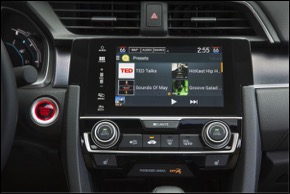
Aha™ content categories:
- On-demand news and weather
- Personalized music including Slacker
- Internet Radio
- On-demand podcasts
- Audio Books
- Local Search: Restaurants, fuel, ATM, parking, etc.
- Social Media: Facebook, Twitter, etc. via audio
- Custom Interactive OEM Channels: Direct communication to and from vehicle
Siri Eyes Free
The Civic EX-T and above trims integrate Apple's Siri Eyes Free mode imbedding in Apple CarPlay™. Compatible iPhone® users will be able to operate Siri through familiar voice commands by pressing and holding the TALK button on the steering wheel for two seconds when their iPhone is paired via Bluetooth®7. Using Eyes Free mode, Siri takes hands-free functionality even further and helps to minimize the potential for distractions by keeping the iOS device's screen from lighting up.
Owners can direct Siri to perform a number of specific tasks while they keep their eyes on the road and their hands on the wheel. Capabilities include:
- Send text messages and e-mails
- Read incoming text messages and emails
- Set up calendar entries, reminders, and alarms
- Check the weather
- Turn-by-turn voice navigation (when the audio system is set to Bluetooth®7 Audio or iPod mode)
- Sports scores and stock quotes
SMS Text Messaging
All EX-T Coupe and above trims have a standard SMS12 text message function that can read incoming texts aloud over the audio system, and allow the driver to reply with any of six factory preset messages. The system works with SMS-capable cell phones that have an active data plan and the Message Access Profile (MAP), such as the Blackberry, Droid X and others. Apple iPhone models do not support this feature, but Siri Eyes Free CarPlay™ mode (iPhone 5 and 6 at time of launch) offers the ability to initiate, hear and respond to text messages via voice commands.
Once a compatible phone is paired with the Civic’s Bluetooth®7 HandsFreeLink® system, the text messaging function is enabled. When the phone receives a text message, an alert appears on the audio display screen. The driver can choose to have the message read aloud, can select among the preset reply choices, or can call the sender – all without touching the phone.
To help avoid the potential for driver distraction, the text of the incoming message is not displayed on screen unless the vehicle is stopped.
Available factory preset text replies:
- Talk to you later, I'm driving.
- I'm on my way.
- I'm running late.
- OK
- Yes
- No
Bluetooth® HandsFreeLink®
The Bluetooth®7 HandsFreeLink® interface is designed to offer hands-free operation for many Bluetooth®-enabled mobile telephones. Standard on all Civic models, the system wirelessly connects the driver's cell phone to the vehicle's audio system. This allows the driver to make or answer cell phone calls without removing hands from the steering wheel. The system is compatible with Bluetooth®-enabled cell phones that have the Hands Free Profile (HFP). A list of compatible phones can be found at handsfreelink.com or honda.com.
Bluetooth® HandsFreeLink® enables audio files to be played through the vehicle's audio system wirelessly with a feature called Bluetooth® Audio. If an audio compatible device is paired it will be added as an auxiliary source on the audio screen. This allows the Bluetooth® device's media to be played wirelessly by the audio system. Cell phone devices that support the Advanced Audio Distribution Profile (A2DP) and Audio Video Remote Control Profile (AVRCP) 1.3 allow the display of metadata for artist, album and track name on the audio screen. The vehicle's audio controls for "skip forward" and "skip backward" allow for navigation from track to track.
Bluetooth® HandsFreeLink® is designed for easy use. After the driver completes a simple one-time "pairing" process to link the cell phone with the vehicle, Bluetooth® HandsFreeLink® can communicate wirelessly and securely with the driver's cell phone when the phone is within about 33 feet of the vehicle. Once the driver enters the vehicle, the phone can be stored in a pocket, briefcase, purse or a storage bin inside the vehicle's cabin as the call transfers information through the wireless telephone interface. Certain compatible cell phones can also transfer the cellular phonebook into the vehicle through the Bluetooth® HandsFreeLink® system. After the cellular phonebook is transferred, calls can be made by making selections from the registered phonebook on the Civic’s display screen.
- Pressing the steering wheel-mounted "Pick up" button answers the call and mutes the audio system
- The caller is heard through the audio-system speakers
- An overhead microphone picks up the driver's voice while minimizing background noise and echoing
- Numbers with voice tags may be stored in the system's memory
- To make a hands-free call, the driver first activates the system using the steering wheel-mounted fingertip controls, then speaks a preset voice tag
- Numbers can also be dialed by speaking the telephone number
- Automatic import of phone book and call history with compatible phones
- Up to six different compatible mobile phones can be paired with the Bluetooth®6 HandsFreeLink® system
Honda Satellite-Linked Navigation System with Voice Recognition and Honda HD Digital Traffic
Civic Touring Coupe offers the integrated Honda Satellite-Linked Navigation System2 with GPS technology to provide drivers with turn-by-turn guidance to their chosen destination. This all-new navigation system, developed in cooperation with Garmin, offers many improvements, including enhanced graphics, live search, speed limit display, customized vehicle icons, 3D buildings and terrain, and more. The system includes free map database updates for up to 5 years (initial purchase plus one yearly update each year for 4 years). The system includes the HD Digital Traffic feature, which alerts the driver to current traffic conditions and can display alternate routes around gridlock. It features expanded coverage including many surface streets within the U.S., allowing the driver to choose faster, less congested routes. HD Digital Traffic is subscription-free.
The navigation system can be controlled by voice or through the 7-inch electrostatic touch-screen audio display utilizing its tap, pinch and swipe functionality. The voice-activation system can respond to more casual command phrases that require less user familiarization, in addition to the previous capability of being able to understand spoken city and street names. For example, a voice request for "Radio 98.3 FM" can now be spoken in approximately a dozen different ways ranging from "change the radio station to 98.3" to "98.3 FM." This logic applies to audio functionality of the audio/information screen. The navigation system can also be controlled by voice with conventional navigation commands like, "Find nearest Chinese restaurant" or "find nearest ATM."
The audio system is automatically muted when the "Talk" button is pressed. The voice-recognition technology allows the driver to simply speak city and street names aloud, and the system responds by displaying the matches available in the database. Points of interest on the map – such as restaurants or grocery stores – can be displayed with brand logo icons or you can have the system provide turn-by-turn navigation, all by voice command. The massive point-of-interest (POI) database includes telephone numbers that can be dialed by using the Bluetooth®7 HandsFreeLink® system when the driver's cellular telephone is connected to the system.
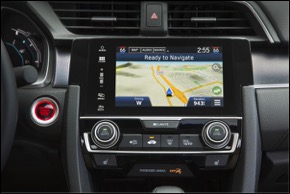
The Honda Satellite-Linked Navigation System2 uses GPS in combination with detailed information from the vehicle's mapping system to pinpoint the vehicle's location and to provide a host of useful mapping and route guidance features. The system’s antenna receives positioning information from a network of 24 global positioning satellites. If the antenna is obstructed by a tunnel, a parking garage or a tall building, an internal gyroscopic system and a speed sensor track the location of the vehicle so that the map information remains current and reliable. The vehicle clock is independently controlled by GPS data, so when time zones are crossed while driving, the clock will automatically set itself to the current time.
USB Ports and Power Outlets
In LX and LX-P trims, a 12-volt power outlet is positioned at the base of the center stack on the right of the lower storage tray, with a 1.0-amp USB port positioned on the left. EX-T and above trims retain the 12-volt power outlet, while the USB port on the left is upgraded to 1.5 amps, and a 1.0-amp USB port is added inside the center console.
Audio and Connectivity Features
Features |
LX |
LX-P |
EX-T |
EX-L |
Touring |
|
160-Watt Audio System with 4 Speakers |
• |
• |
|
|
|
|
450-Watt Premium Audio System with 10 Speakers (Including Sub-Woofer) |
|
|
• |
• |
• |
|
5-inch LCD Screen |
• |
• |
|
|
|
|
7-inch Display Audio with High-Resolution WVGA (800x480) Electrostatic Color Touch-Screen and Customizable Feature Settings |
|
|
• |
• |
• |
|
Honda Satellite-Linked Navigation System™ with Voice Recognition and Honda HD Digital Traffic2 |
|
|
|
|
• |
|
Smartphone-Based Navigation App Compatibility |
|
|
• |
• |
• |
|
Steering Wheel Touchpad Control |
|
|
• |
• |
• |
|
HondaLink®9 |
|
|
• |
• |
• |
|
HondaLink Assist10 (when paired with compatible phone) |
|
|
• |
• |
• |
|
Apple CarPlay™4/Android Auto™5 Support |
|
|
• |
• |
• |
|
HD Radio™11 |
|
|
• |
• |
• |
|
SiriusXM®8 Radio |
|
|
• |
• |
• |
|
Pandora®6 Compatibility |
|
|
• |
• |
• |
|
Bluetooth®7 Streaming Audio |
• |
• |
• |
• |
• |
|
Display Audio Interface |
|
|
• |
• |
• |
|
USB Audio Interface13 |
1 |
1 |
2 |
2 |
2 |
|
12-Volt Power Outlet (Front) |
1 |
1 |
1 |
1 |
1 |
|
MP3/Windows Media®14 Audio (WMA) Playback Capability |
• |
• |
• |
• |
• |
|
Radio Data System (RDS) |
• |
• |
• |
• |
• |
|
Speed-Sensitive Volume Control (SVC) |
• |
• |
• |
• |
• |
|
Bluetooth®7 HandsFreeLink® |
• |
• |
• |
• |
• |
|
SMS12 Text Message Function |
|
|
• |
• |
• |
(See the Specifications and Features section for all data.)
1 The Display Audio Interface is used for direct connection to and streaming from some current [Apple/Android] smartphones. For safety reasons, always launch HondaLink applications or perform any other operation on your phone only when the vehicle is safely parked. State or local laws may limit use of texting feature, and Assist functions may be terminated without notice. Your wireless carrier's rate plans apply. Please see HondaLink terms and conditions for details.
2 The Honda Satellite-Linked Navigation System™ is standard on the Touring model in the United States, Canada and Puerto Rico. (Honda HD Digital Traffic service only available in the United States, except Alaska). Please see your Honda dealer for details.
3 Garmin is the registered trademark of Garmin International, Inc.
4 Apple CarPlay is a registered trademark of Apple Inc.
5 Android and Android Auto are trademarks of Google Inc.
6 Pandora, the Pandora logo, and the Pandora trade dress are trademarks or registered trademarks of Pandora Media, Inc. Used with permission. Compatible with select smartphones. See: www.pandora.com/everywhere/mobile. Not all devices compatible with USB connection. Your wireless carrier's rate plans apply.
7 The Bluetooth® word mark and logos are owned by the Bluetooth SIG, Inc., and any use of such marks by Honda Motor Co., Ltd., is under license.
8 SiriusXM services require a subscription after any trial period. If you decide to continue your SiriusXM service at the end of your trial subscription, the plan you choose will automatically renew and bill at then-current rates until you call SiriusXM at 1-866-635-2349 to cancel. See our Customer Agreement for complete terms at www.siriusxm.com. Fees and programming subject to change. SiriusXM satellite service is available only to those at least 18 years and older in the 48 contiguous United States and D.C. ©2015 SiriusXM Radio Inc. Sirius, XM and all related marks and logos are trademarks of SiriusXM Radio Inc.
9 Check the HondaLink® website for smartphone compatibility.
10 Honda reserves the right to terminate HondaLink Assist services at any time or for any reason, and in the future may not be able to provide services due to changes in or obsolescence of technology integral to the service or changes in government regulation.
11 HD Radio is a proprietary trademark of iBiquity Digital Corporation.
12 Compatible with select phones with Bluetooth®. Your wireless carrier's rate plans apply. State or local laws may limit use of texting feature. Only use texting feature when conditions allow you to do so safely.
13 The USB Audio Interface is used for direct connection to and control of some current digital audio players and other USB devices that contain MP3, WMA or AAC music files. Some USB devices with security software and digital rights-protected files may not work.
14 Windows Media® is a trademark or registered trademark of Microsoft Corporation in the United States and/or other countries.
Honda Civic Coupe Press Kit - Body
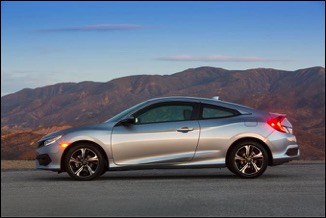
Overview
Together with the 2016 Civic Sedan, the new Civic Coupe features the most rigid, tightly sealed body and aerodynamic body design in Civic history, with the greatest use of high-strength steel for any Civic model ever made, offering significant advancements to overall noise, vibration and harshness (NVH), ride and handling, fuel efficiency and collision performance.
Longer, lower and wider, the new Civic body is also more spacious, with 8.2 additional cubic feet of passenger and cargo space. Despite its larger size, the new Civic Coupe's unibody is 76 pounds lighter than before with a 25 percent increase in torsional rigidity, while its lower height, wider stance and shortened front overhang serve as the basis for the new Civic's sportier, more premium look and feel.
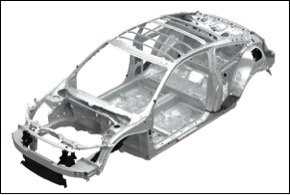
Advanced unibody construction techniques, including the use of Honda's next-generation ACE™ body structure and new crash stroke front frame, enable superior front, side and rear crash-worthiness. Comprehensive body sealing measures, the use of acoustic windshield glass combine with new chassis technologies, such as hydraulic suspension and engine mounts, to make the 2016 Civic the quietest and most refined Civic yet.
Key Body Features
- Advanced Compatibility Engineering™ (ACE™) body structure with new crash stroke front frame design
- 63 percent high strength steels (12 percent ultra-high strength steel)
- 590 MPa high-strength steel floor pan
- Narrow A-pillars for 84.3 degrees of forward visibility
- Acoustic-glass, flush mounted windshield
- Acoustic fiber side under-panels
- Acoustically sealed unibody
- Full underbody covering
Exterior Dimensions
Compared to the previous model, the 2016 Civic Coupe's wheelbase is 1.2 inches longer for improved ride comfort, better second-row seating roominess, and improved ingress and egress. The overall length is shorter by 1.0 inches, for a more compact, sporty profile. Front and rear overhangs are 1.4-inch shorter and improve both appearance and aerodynamic efficiency. Fuel efficiency is improved in part due to comprehensive aerodynamic gains throughout the exterior, and even underneath the vehicle.
Key Exterior Specifications – 9TH to 10th Generation Difference
Specification |
2016 Civic EX-T Coupe |
2015 Civic EX Coupe |
Change |
|
Length (in) |
176.9 |
177.9 |
-1.0 |
|
Width (in) |
70.8 |
69.0 |
+1.8 |
|
Height (in) |
54.9 |
55.0 |
-0.1 |
|
Wheelbase (in) |
106.3 |
103.2 |
+3.1 |
|
Track (in) |
60.9 / 61.5 |
59.0 / 59.9 |
+1.9 / +2.5 |
|
Front overhang (in) |
35.2 |
36.6 |
-1.4 |
|
Rear overhang (in) |
35.2 |
38.2 |
-3.0 |
|
Wheel/tire size |
215/50R17 |
205/55R16 |
+10/-5/+1 |
Key Exterior Specifications – Civic Coupe to Civic Sedan Difference
Specification |
2016 Civic EX-T Coupe |
2016 Civic EX-T Sedan |
Change |
|
Length (in) |
176.9 |
182.3 |
-5.4 |
|
Width (in) |
70.8 |
70.9 |
-0.1 |
|
Height (in) |
54.9 |
55.7 |
-0.8 |
|
Wheelbase (in) |
106.3 |
106.3 |
0 |
|
Track (in) |
60.9 / 61.5 |
60.9 / 61.5 |
0 |
|
Front overhang (in) |
35.2 |
35.2 |
0 |
|
Rear overhang (in) |
35.2 |
40.6 |
-5.4 |
|
Wheel/tire size |
215/50R17 |
215/50R17 |
0/0/0 |
(See the Specifications and Features section for all data.)
Key Exterior Specifications – 9TH to 10th Generation Difference
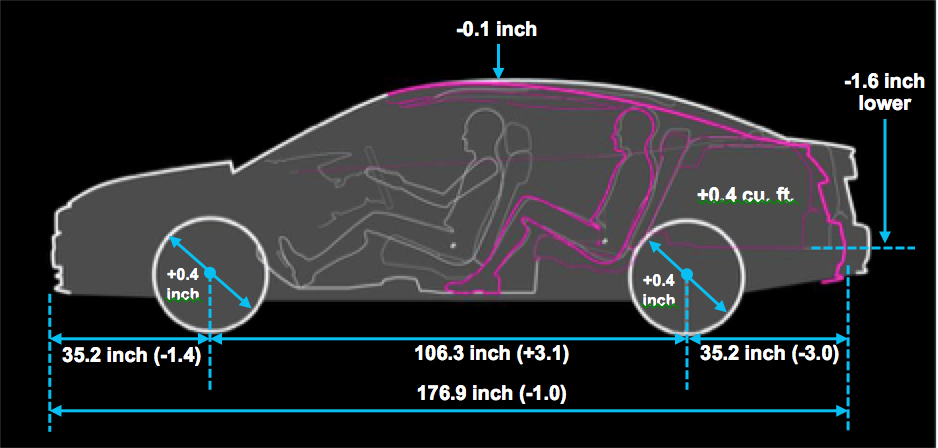
Key Exterior Specifications – 9TH to 10th Generation Difference
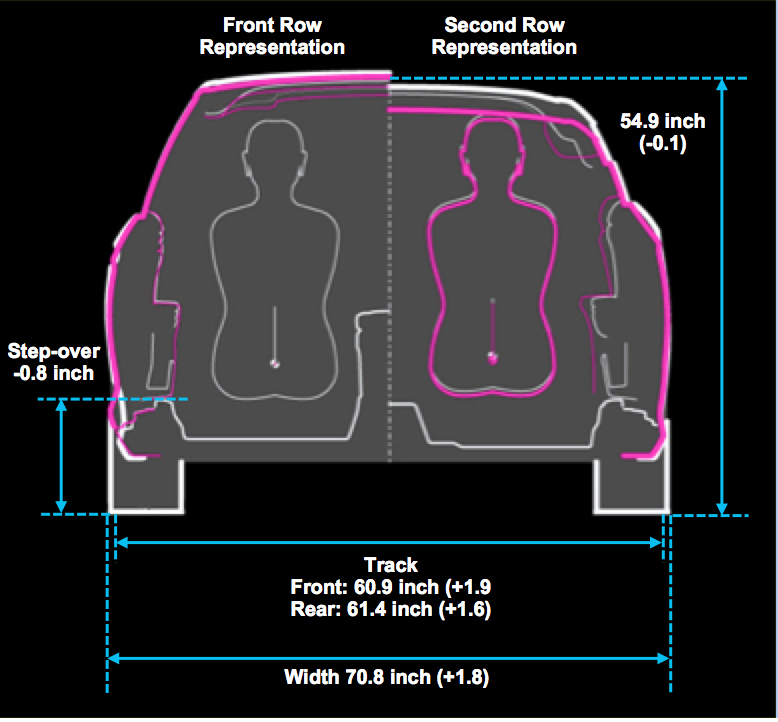
Increased Trunk Capacity
The 2016 Civic Coupe has a wider and deeper trunk with 12.1 cu. ft. of storage volume (LX, LX-P), 0.4 cu. ft. larger than that of the previous Civic Coupe. Together with the enlarged passenger volume, this makes the new Civic Coupe best in class in total interior volume. (See the Interior section for more information.)
A low lift-over height of 27.3 inches and a maximum trunk opening width of 35.5 inches improves the ease of loading or unloading bulky items, as does a flat trunk floor, which measures 53.8 inches wide and 35.7 inches deep – all significant improvements over the previous model. The floor and trunk sides are carpeted to help protect cargo during transit, and also to help reduce road noise entering the passenger cabin.
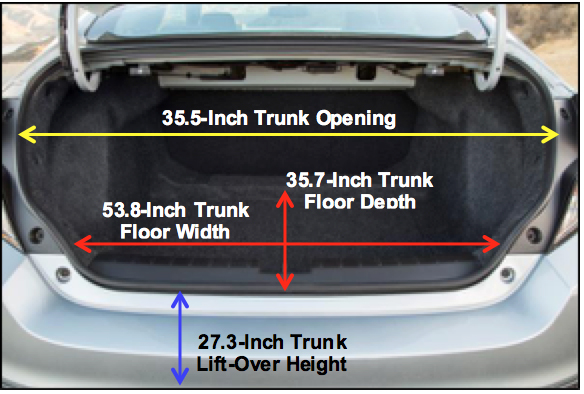
The Civic Coupe's trunk will accommodate three soft suitcases or three golf bags. For long, narrow items such as skis, the 3.5 sq-ft. trunk pass-through is 20.6-percent larger than before. A removable floor panel hides the temporary spare tire, jack and wrench. A single LED cargo-area light provides illumination when the trunk lid is open.
Key Body Specifications
Specification |
LX |
LX-P |
EX-T |
EX-L |
Touring |
|
Wheelbase (in) |
106.3 |
106.3 |
106.3 |
106.3 |
106.3 |
|
Length (in) |
176.9 |
176.9 |
176.9 |
176.9 |
176.9 |
|
Height (in) |
54.9 |
54.9 |
54.9 |
54.9 |
54.9 |
|
Width (in) |
70.8 |
70.8 |
70.8 |
70.8 |
70.8 |
|
Track (in, front / rear) |
60.9 / 61.5 |
60.9 / 61.5 |
60.9 / 61.5 |
60.9 / 61.5 |
60.9 / 61.5 |
|
Curb Weight (lb) |
2735 (MT) |
2771 |
2885 |
2896 |
2884 |
|
Weight Dist. |
61.7 / 38.3 (MT) |
61.8 / 38.2 |
62.0 / 38.0 |
62.0 / 38.0 |
62.0 / 38.0 |
|
Trunk capacity (cu ft) |
12.1 |
12.1 |
11.9 |
11.9 |
11.9 |
(See the Specifications and Features section for all data.)
Advanced Compatibility Engineering™ (ACE™)
As an integral part of the 2016 Civic structure, Honda's proprietary Advanced Compatibility Engineering™ (ACE™) body-structure enhances occupant protection and crash compatibility in frontal collisions. ACE utilizes a network of connected structural elements to distribute crash energy more evenly throughout the front of the vehicle, thus reducing the forces transferred to the passenger compartment. ACE channels frontal crash energy to both upper and lower structural elements, including the floor frame rails, side sills and A-pillars.
Crash Stroke
A Honda first, the ACE™ structure used on the new Civic features a new crash stroke technology, developed by Honda engineers in the company's advanced safety research laboratory in Raymond. Ohio. With the new crash stroke structure, in a frontal collision the lower section of the front vehicle frame hinges to direct the engine down and rearward, helping direct crash energy into the vehicle's floor while also minimizing cabin intrusion. This crucial piece of safety engineering effectively adds 80mm (3.2 in) of additional energy-absorbing "crash stroke" to the front of the vehicle.
Besides helping the Civic aim for the highest ratings in the rigorous federal crash tests, the new crash stroke structure enabled designers to develop the Civic's body design to feature a short front overhang and short hood-line for a unique and exciting appearance, excellent outward visibility and improved handling. (See the Safety and Driver Assistive section for more information.)
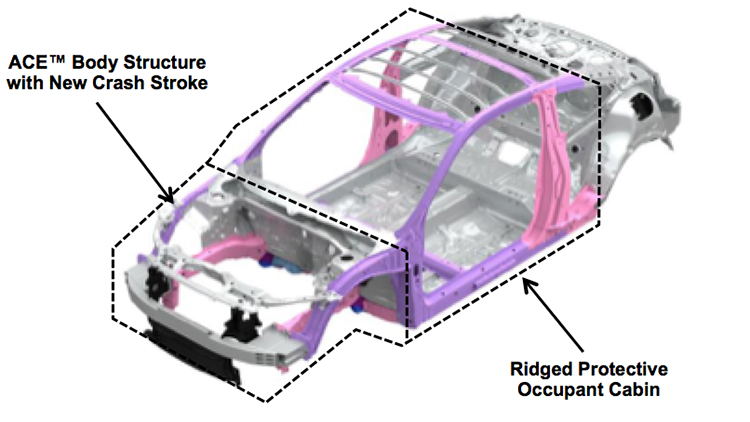
Improved Body Rigidity
Compared to the previous Civic generation, the new 2016 Civic Coupe body's global bending rigidity increases 19 percent and its torsional rigidity increases 23 percent. The benefits of this increased stiffness are numerous, including the ability to tune the suspension for superior ride and handling performance. This tuning includes localized increases in rigidity at the suspension mounting points, with a 28 percent increase at the front and 35 percent increase at the rear over the previous generation Civic Coupe. This allows the chassis to work more effectively and reduces the suspension action needed to control body motion. The localized lateral stiffness of the Coupe's exclusive rear body is 4.6 percent stiffer than the Sedan, which is primarily due to the body construction, and that has significant dynamic benefits. The more rigid body structure also directly results in a quieter and more comfortable ride experience for the passengers, with less NVH felt over a wide range of driving conditions. Some key advancements in body structure include:
Under the Hood
- A lower stiffener, located behind the engine on the front bulkhead, improves handling
In the Unibody
- Certain connection areas where the A-pillars meet the floor sills, and the B-pillars meet both the floor sills and roof rails, reduce idle vibration and booming
- Large body panels are shaped using computer aided engineering (CAE) to reduce booming
- Gussets positioned inside the rear quarter areas of the unibody reduce road noise
- An internal rear structural ring stiffens the unibody for improved handling
- Short-pitch welding places spot welds 20mm (0.8 in) apart in critical areas of the unibody, compared to 40mm to 45mm (1.6 in to 1.8 in) traditional spacing, increasing stiffness and durability
Underneath the Vehicle
- The Civic's floor pan is made of 590-MPa high-strength steel to provide a lighter yet stronger overall structure
- Floor cross-members positioned under the driver and front passenger's seating area improve ride comfort
- A lateral cross-member and damper structure, located between the rear wheels, improves handling
- A cross-car brace, located at the front of the vehicle, improves handling
Aerodynamics
The Civic was designed to have class-leading aerodynamic performance – including 12.5-percent overall less drag than the previous Civic generation – which helps improve both fuel efficiency and interior quietness. Computational fluid dynamics (CFD) was used to measure the car's efficiency during the design phase, followed by scale-model wind tunnel testing and finally by full-scale wind-tunnel testing. Two critical gains from this process include a 12.5-percent reduction in underbody and engine-room airflow drag (CdA), and another 4-percent CdA reduction in wheel drag.
Specially shaped components at the front of the vehicle guide airflow through the radiator and into the engine's cold-air intake, while channeling the remaining airflow over, around and under the vehicle. Along with narrower the A-pillars and flush-mounted glass, these contribute to the Civic's efficient passage through the air. The relaxed slope of the rear roofline and rear window further improves aerodynamic efficiency.
The new Civic features the flattest underbody of any gasoline-powered Honda production vehicle. A molded under-panel is positioned directly beneath the front fascia, starting the rearward flow of air underneath the vehicle in a smooth manner. An aluminum under-tray is positioned underneath the engine and transmission and features a cooling duct that allows ambient airflow to the hydraulic engine mount. Dual side under-panels (molded plastic on LX and LX-P, acoustic fiber on EX-T and above trims) extend from behind the front wheels to just ahead of the rear wheels, further smoothing the airflow as it travels rearward, while also reducing wind noise in the passenger cabin.
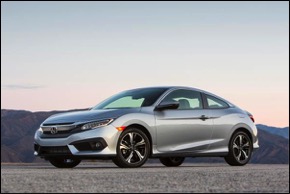
Lateral strakes located ahead of each wheel and tire (8.5 inches wide in front, and 3.5 inches wide in the rear) help deflect airflow around the tires for additional aerodynamic efficiency gains. Even the stamped steel exhaust silencers are aerodynamically shaped, eliminating the need for an under-cover at the rear of the vehicle. This reduces parts count, complexity and weight while helping to ensure optimal aerodynamic efficiency.
T-Direction Welding
Applied to the forward edge of the front door hinge pillars, just behind the front wheel openings, a new "T-direction welding" technique is anticipated to help the 2016 Civic earn top ratings in the rigorous IIHS narrow offset frontal collision test, based on Honda internal testing. Instead of using lateral overlapping welded joints on the hinge pillars, which would be negatively affected by the wheel moving rearward and striking the pillar in an offset frontal collision, the hinge pillars instead use a longitudinal welded seam designed to withstand sheer forces generated in such a collision.
Class-leading Forward Visibility
The A-pillar section on the 2016 Civic is 18mm (0.7 in) narrower than on the previous-generation Civic, reducing the obstructed area by 11.6-percent, and resulting in a 7.9-degree improvement in forward visibility. As a result, the new Civic offers a class-leading 84.3 degrees of forward visibility (the angle made by drawing lines from the driver's eye point to the outboard edges of the A pillars). Safety is maintained through the pillars' shape, the precise design of load pathways during a frontal collision or rollover, and the use of 1500 MPa hot-stamped ultra-high-strength steel for the A-pillars.
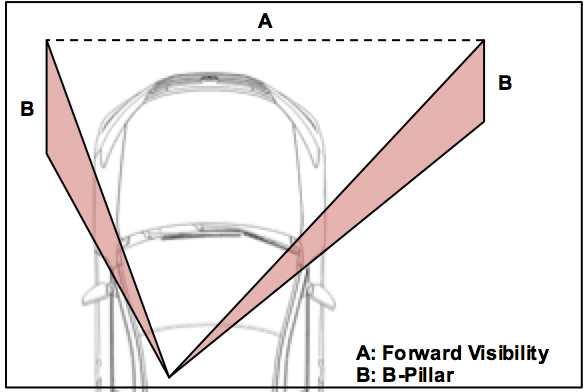
High-Strength Steel
Multiple steel grades are used in the Civic's body construction to help achieve excellent overall vehicle dynamics, optimize safety performance, and lower NVH. Materials range from five different grades of steel, including premium hot-stamp steel and ultra-high-strength steel used in the unibody, to aluminum for the front bumper beam. All were chosen to achieve the best combination of strength, rigidity, dynamic performance and light weight. Fully 63 percent of the body structure is composed of high-strength steel, up 8 percent compared to 55 percent for the previous Civic Coupe. In addition, the use of hot-stamp ultra-high strength steel increases to 7 percent from 1 percent in the previous-generation Civic.
Lighter Weight
The increased use of high-strength steel contributes to a 76-pound reduction in weight for the 2016 Civic Coupe's unibody compared to the previous Civic generation.
Body Materials
Material |
Grade |
Use Percentage |
|
Hot-stamp steel |
1500 MPa |
7% |
|
Ultra high-strength steel |
980-1180 MPa |
12% |
|
Advanced high-strength steel |
590-780 MPa |
35% |
|
High-strength steel |
340-440 MPa |
9% |
|
Mild Steel |
270 MPa |
37% |
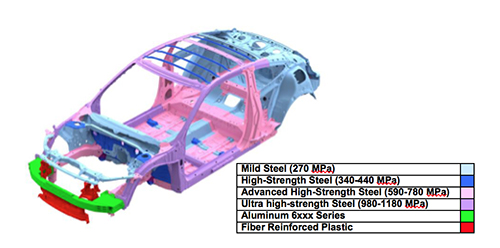
Noise, Vibration and Harshness (NVH) Countermeasures
The new Civic takes noise, vibration and harshness (NVH) countermeasures to the next level, positioning it at the top of its competitive set. All Civic trims feature strategically placed body sealants (see below). Additional NVH enhancements on all models include acoustic separators inside the A- and B-pillars, while a sound-insulating acoustic windshield (see below) further aids overall cabin quietness.
Engine Compartment Isolation
Measures to isolate sound and heat emanating from within the engine compartment include dedicated front, side and rear hood seals, strategically placed heat baffles, a hood insulator panel, an engine under-cover, and dedicated insulation within the instrument panel. Inside the vehicle, a one-piece molded insulated carpet liner adds further to exceptional heat isolation and noise reduction for the 2016 Civic.
Acoustic Windshield
Special laminated acoustic glass is used for the Civic windshield to help reduce noise entering the cabin. Tuned specifically to attenuate wind-noise frequencies, the windshield glass uses an outer layer of 2.0mm safety glass, a 0.7mm thick middle layer of acoustic polyvinyl butyral (PVB), and a 1.8mm safety-glass inner layer for a total thickness of 4.5mm. This helps the Civic place at the top of its class in wind-noise performance. The windshield also incorporates UV light-absorbing technology. In addition, the Civic Coupe has 4.0mm tempered front door glass and 3.5mm tempered rear door glass. The available one-touch power moonroof with tilt feature uses 3.5mm tinted and tempered glass.
Sound-absorbing Undercovers
Underneath the Civic, along both sides of the passenger cabin, are absorptive undercovers (molded plastic on the LX and LX-P, and fiber on the EX-T and above trims) that mitigate road and wind noise. A special baffle plate located beneath the center of the floor pan and felt fender inner liners further attenuate wind and road noise.
Body Sealing
The 2016 Civic Coupe has an unprecedented level of body sealing to dramatically reduce the levels of noise inside the vehicle – a 75 percent overall leak reduction compared to the previous-generation Civic. Throughout the unibody are 9.2 sq. in. of weld seals and other sealers to reduce vibration and the transmission of noise.
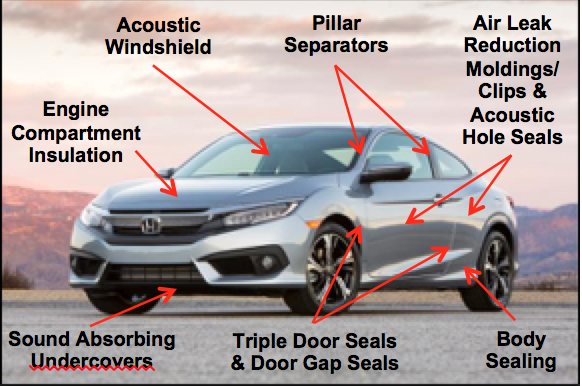
Additional measures include:
- Pillar separators seal the hollow A- and B-pillars to reduce the transmission of noise from the floor area into the passenger cabin.
- Triple door sealing utilizes 360-degree molded door seals to reduce wind noise and improve isolation.
- New door gap seals at the rear edges of the doors are a first for Civic. They join the triple sealed door openings and lower door-edge seals in keeping wind noise from entering the cabin.
- Multiple air leak reduction moldings and clips are used at key locations where the side windows slide into the Coupe's two doors, reducing the possibility of audible air leaks occurring in these locations.
- Along with internal bracing, acoustic hole seals fill open areas inside the door structures, significantly reducing the amount of wind and road noise and vibration that can reach the cabin. The same Thinsulate™ material that is used in the doors is also used to reduce sound transmission through the roof, the body A- and B-pillars, and the rear tray.
Body Features
Features |
LX |
LX-P |
EX-T |
EX-L |
Touring |
|
Advanced Compatibility Engineering™ (ACE™) body structure with new crash stroke design |
• |
• |
• |
• |
• |
|
One-touch power moonroof with tilt feature |
|
• |
• |
• |
• |
|
Acoustic windshield |
• |
• |
• |
• |
• |
|
Acoustically sealed unibody |
• |
• |
• |
• |
• |
|
Triple door sealing |
• |
• |
• |
• |
• |
|
Hydraulic front engine mount |
• |
• |
• |
• |
• |
|
Hydraulic lower suspension mounts |
• |
• |
• |
• |
• |
|
Underbody aerodynamic tailoring |
• |
• |
• |
• |
• |
(See the Specifications and Features section for all data.)
2016 Honda Civic Coupe Press Kit - Chassis
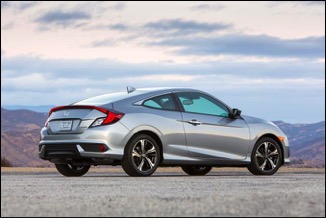
Overview
The 2016 Civic Coupe utilizes the most sophisticated chassis design in model history, delivering quicker and more accurate steering, more responsive handling, and exceptional ride quality that exceeds the mainstream, compact-car class to challenge even luxury C-segment products.
Key suspension upgrades include a sophisticated new multi-link rear suspension and rigid rear subframe; fluid-filled suspension bushings that greatly enhance ride quality while providing robust isolation from road vibration; stabilizer bars with bonded bushing mounts for improved body control; dual-pinion, variable ratio Electric Power Steering (EPS) that enhances steering feel, performance and comfort; and a Straight Driving Assist feature that reduces steering effort when driving on a sloped or crowned road. Additional new Civic chassis features include Agile Handling Assist and an Electric Parking Brake (EPB) with Automatic Brake Hold.
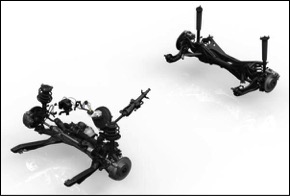
Key Chassis Features
- MacPherson strut front suspension
- Multi-link rear suspension
- Dual-Pinion, Variable Ratio Electric Power Steering (EPS)*^
- Vehicle Stability Assist™ (VSA®)1 with Traction Control
- 4-channel Anti-lock Braking System (ABS)2 with Brake Assist
- Electronic Brake Distribution (EBD)
- Front and rear stabilizer bars
- Fluid-filled suspension compliance bushings*
- Straight Driving Assist
- Agile Handling Assist*
- Electric Parking Brake (EPB) with Automatic Brake Hold*
* First for Civic
^ First for Honda
Chassis Summary
All Models
- MacPherson strut front suspension
- Multi-link rear suspension
- Front and rear stabilizer bars
- Front fluid-filled suspension bushings
- Power-assisted 4-wheel disc brakes
- 4-channel Anti-lock Braking System (ABS) with Brake Assist
- Electronic Brake Distribution (EBD)
- Vehicle Stability Assist™ (VSA®)1 with Traction Control
- Agile Handling Assist
- Dual-Pinion Variable Ratio Electric Power-Assisted Rack-and-Pinion Steering (EPS)
- Straight Driving Assist
- Electric Parking Brake (EPB) with Automatic Brake Hold
- Hill Start Assist
- Tire Pressure Monitoring System (TPMS)3
Civic LX and LX-P
- 16-inch machine-finished aluminum wheels
- P215/55R16 all-season tires
Civic EX-T and EX-L
- 17-inch aluminum wheels with aerodynamic shape and cut flanges
- P215/50R17 all-season tires
- Rear fluid-filled suspension bushings
Civic Touring
- 17-inch aluminum wheels with cut flanges
- P215/50R17 all-season tires
- Rear fluid-filled suspension bushings
Front and Rear Suspension
The 2016 Civic suspension system provides agile and direct handling that puts the Civic at the top of its class, and in the league of benchmarked European luxury-class competitors. The system uses a combination of front MacPherson struts and an all-new rear multi-link with new rigid subframe. Using a strut-style front suspension improves the room available for crash reinforcement, and the multi-link rear suspension helps maximize second-row seating and cargo space – all while also providing outstanding handling characteristics and ride quality. Front and rear stabilizer bars on all trims improve turn-in response while reducing body roll during cornering. The stabilizer bars are bonded to their mounting bushings and use low-friction connecting links for smoother operation. The 2016 Civic Coupe has a 20mm (0.8 in) lower center of gravity, significantly helping to improve handling agility.
MacPherson Strut Front Suspension
The MacPherson strut front suspension is engineered to provide engaging performance and a responsive feel for the driver. Performance-calibrated geometry ensures a high degree of quickness and precision, smoothness and stability. The lower suspension arms are connected to the subframe and to the body via fluid-filled bushings, which provide the ideal combination of handling responsiveness and precision, along with maximum isolation from road noise, vibration and harshness (NVH). All front suspension arms and the front hub carriers are steel, and all Civic Coupe trims use a tubular front stabilizer bar. The LX-P trim and above have increased front roll stiffness to balance the additional weight of the sunroof and resultant increased inertia. Furthermore, a small increase in damping force controls that inertia and maintains ride quality. The Civic EX-T Coupe and above trims have front springs with a rate 15 percent stiffer than the LX and LX-P trims and the damping force is increased by 20 percent for more direct, agile handling response and body control. Due to the lighter alloy wheels on the Touring trim, the damping rates are specifically tuned for the reduced unsprung weight, increasing road isolation and providing a premium, direct feel.
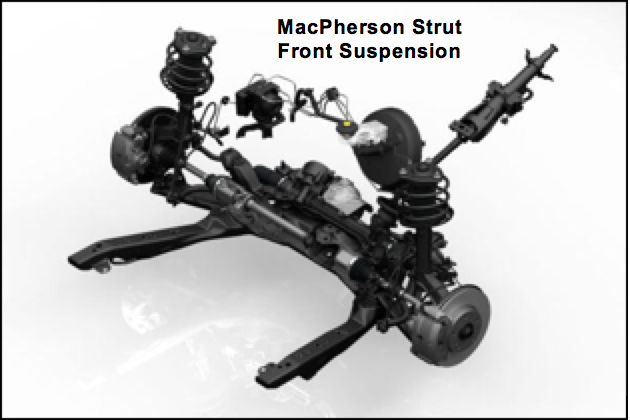
Multi-Link Rear Suspension
The multi-link rear suspension includes stamped-steel arms, cast aluminum hub carriers and a stabilizer bar. Mounted on a rigid subframe, a first for Civic, the new rear suspension provides agile handling, both during normal driving and in emergency maneuvers, together with a flat ride. On the Civic EX-T and above trims the trailing arms are connected to the unibody by fluid-filled bushings for exceptional control of noise, vibration and harshness (NVH) while maintaining precise handling. The EX-T and above trims also have 20 percent stiffer rear springs and the damping force is increased by 90 percent to deliver high levels of body control and direct agile handling response. All Civic Coupe trims use a solid rear stabilizer bar for improved crisp turn-in and body roll control. As with the front suspension, the rear damping rates are specifically tuned for the reduced unsprung weight of the lighter Touring trim wheels.
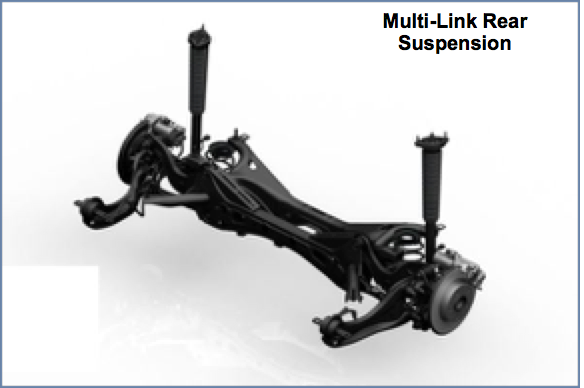
Hydraulic Suspension Bushings
In a first for Honda, the 2016 Civic suspension uses fluid-filled bushings to provide superior ride isolation as well as chassis vibration control. All Civic models utilize front fluid-filled bushings and the EX-T and above trims additionally use rear fluid-filled bushings. These bushings are specifically tuned to provide minimum vibration transfer to the occupants, raising the new Civic to the top of its class in noise, vibration and harshness (NVH) reduction.
In front, the lower control arms pivot in the fluid-filled bushing, which is designed to absorb road harshness and vibration while still retaining the exacting precision required for sharp, nimble handling. For the front suspension only, a specially ventilated under-cover allows airflow to cool the bushings, ensuring more consistent performance in all ambient temperature conditions, as well as enhanced long-term durability.
An additional duct, located near the middle of the aluminum front under-panel, cools the engine's torque rod bushing, likewise reducing operating temperatures and ensuring longer performance.
Dual-Pinion, Variable Ratio Electric Power-Assisted Rack-and-Pinion Steering (EPS)
Another Civic first, the Electric Power Steering (EPS) incorporates dual pinion gears and a variable gear ratio for improved steering feel, performance and comfort that surpasses the class.
The dual pinion steering provides substantially improved feel compared to the previous-generation Civic. Compared to a traditional single-pinion steering system, the dual pinion EPS utilizes the physical steering input from the driver as well as from a supplemental electric motor. A non-contact torque sensor measures the driver's steering effort and an ECU determines how much electric motor assist to add, with the result being a seamless, natural feeling steering in all situations.
The steering ratio is variable over a 17-percent range with a final full off-center rotation ratio of 10.93:1. This provides a quick 2.2 turns lock-to-lock compared to 3.1 turns lock-to-lock for the previous Civic, significantly reducing hand movement and the steering effort required when parking or maneuvering. Also contributing to the enhanced steering performance and feel of the 2016 Civic Coupe, the steering mount stiffness is higher, and the 30mm steering column diameter (up from 22mm on the previous generation Civic) also provides greater stiffness.
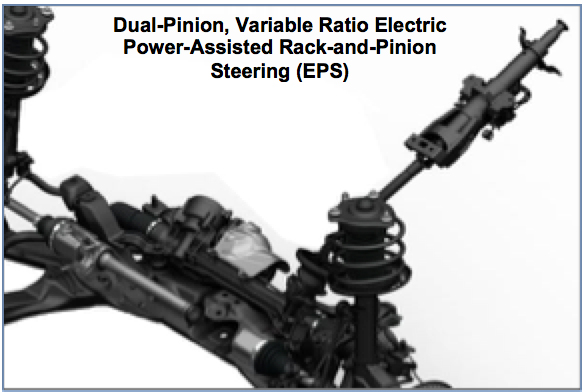
Straight Driving Assist
A new Honda technology, Straight Driving Assist reduces the steering effort required when driving on a sloped or crowned road. When the Straight Driving Assist system detects that steering effort is being applied to keep the car driving along a slope, the Electric Power Steering system applies motor assist. This reduces the muscle effort required to maintain the desired direction on the sloped road to the same level as is required on a flat road.
4-wheel Disc Brakes with ABS, EBD and Brake Assist
In a first for Civic, all trims are equipped with 4-wheel disc brakes. All systems incorporate 4-channel ABS, Electronic Brake Distribution (EBD) and Brake Assist as standard equipment. The system provides a comfortable and refined feel at low speeds, predictable and easy operation on the highway, a sporty, fun-to-drive feel on winding roads, and a reassuring high-performance stopping in emergency situations. Compared to the previous-generation, the 2016 Civic's brakes require less pedal travel, provide a firmer pedal feel under normal conditions, and deliver greater efficiency.
The 4-channel Anti-lock Braking System (ABS) independently modulates braking power at each wheel to help the driver retain steering control during heavy braking. The Brake Assist system recognizes emergency braking situations and almost instantly applies full braking force when appropriate to help shorten braking distance. (See the Safety and Driver Assistance section for more information.)
All 2016 Civic trims are equipped with 11.1-inch diameter ventilated front brake rotors (0.9-inch rotor thickness) clamped by single-piston brake calipers. The rear disc brakes incorporate 10.2-inch diameter solid rotors (0.4-inch rotor thickness) paired with single-piston brake calipers. The low-friction design of the brake calipers reduces energy losses when the
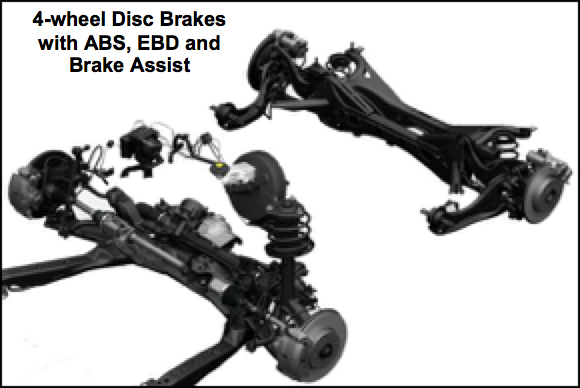
In another first for Civic, a 5-percent-larger master cylinder piston diameter (22.2mm vs. 20.6mm on the previous Civic) contributes to the short, firm pedal stroke and excellent feel, while also maintaining the power of the braking system.
Vehicle Stability Assist™ (VSA®) with Traction Control
Vehicle Stability Assist™ (VSA®)1 is an Electronic Stability Control system that works in conjunction with the Civic Coupe's Drive-by-Wire™ throttle and its 4-channel ABS systems to enhance control capability while the vehicle is accelerating, braking, cornering or when the driver makes a sudden maneuver.
VSA also provides a limited-slip differential effect for the driving wheels by applying braking force to a slipping wheel, thereby redirecting driving force to the wheel with more traction. While the driver can reduce the traction control effectiveness allowing more wheel slip during stuck condition by pressing the VSA button, ABS remains fully operational at all times. (See the Safety and Driver Assistance section for more information.)
Agile Handling Assist
A Civic first and standard on all trims, Agile Handling Assist selectively uses the vehicle's brakes to improve initial turning response and overall cornering ability. Agile Handling Assist utilizes brake vectoring to improve corner traceability and confident handling feel. By applying braking force to the inside wheels during cornering at high lateral G, the system creates a yaw moment, thus generating more turning force and reducing understeer.
Hill Start Assist
The Hill Start Assist function helps to prevent the vehicle from rolling backwards when the driver switches from the brake pedal to the accelerator pedal while the vehicle is stopped on a hill. Hill Start Assist automatically activates when the vehicle senses a certain incline and is fully stopped in any forward gear when facing up hill or reverse gear when facing downhill. The system uses a longitudinal G-sensor along with a wheel speed sensor to control the hydraulic brake modulator. Hill Start Assist, when activated, will release the brakes when the driver depresses the throttle or if the driver doesn't press the accelerator after a few seconds.
Electric Parking Brake (EPB)
In a first for both the Honda Civic and its market segment, the standard Electric Parking Brake (EPB) is simpler, more convenient and comfortable to use than a traditional parking brake. The EPB also frees up center console space, allowing a higher console and an extended armrest length.
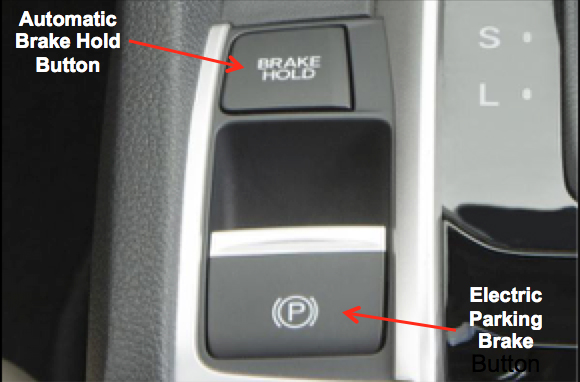
Engaging the parking brake now requires only a pull on a switch on the center console. To release the parking brake, the driver simply presses on the accelerator pedal (while the seatbelt is buckled) when the transmission is in Drive or Reverse, or else pushes on the parking brake switch while operating the brake pedal.
Besides promoting the use of the parking brake, EPB makes hill starts easier when the Civic is parked on a grade. As with a traditional manually activated parking brake, EPB functions on the rear wheels only. Electric servo actuators are integrated into the rear brake calipers. See the Comfort and Convenience section for more information.
Automatic Brake Hold
When activated, Automatic Brake Hold retains brake pressure when the vehicle comes to a stop such as at a traffic light or in heavy traffic. This frees the driver from continually pressing the brake pedal to maintain the vehicle in a stopped position, a significant improvement in driving enjoyment in difficult conditions. Operating the system requires two simple actions from the driver:
- Activating/deactivating the system via a switch on the center console
- Pressing on the brake pedal until the vehicle comes to a stop
Once these steps are taken, Automatic Brake Hold will indicate engagement and then maintain brake pressure when the vehicle has come to a stop, even if the driver later releases the brake pedal. A green "Brake Hold" icon on the instrument panel illuminates to show that the system is functioning. The Civic then remains stopped – even on a hill – until the driver presses the accelerator pedal. At this point Automatic Brake Hold releases the brakes and the vehicle resumes normal braking function.
Wheels and Tires
Civic LX Coupe and LX-P ride on 215/55R16 tires mounted to 16x7.0-inch alloy wheels. The tires are 20mm wider, and the wheels are one inch larger in diameter and 1.0-inch wider, than the previous Civic LX and EX models. Civic Coupe EX-T, EX-L and Touring trims use 215/50R17 tires and 17x7.0-inch aluminum wheels. All tires carry an all-season M+S rating, making them suitable for year-round use in all weather and conditions.
The Civic Coupe LX and LX-P come with Firestone FT140 tires while the EX-T and above trims come with Continental ProContact TX tires. Developed cooperatively with Honda engineers and the tire companies, despite being wider, the tires help reduce rolling resistance by 10-percent while also helping to reduce noise and vibration, improving both fuel efficiency and ride quality in the process. The tires contribute to the Civic's greatly improved rolling resistance performance. They also help reduce unsprung weight by 6.6 pounds, allowing the engineers greater control of suspension tuning, which further improves ride and handling characteristics. See the following page for wheel designs. The 2016 Civic Coupe's wheel and tire sizes include:
|
Civic LX and LX-P
|
Civic Touring
|
|
Civic EX-T and EX-L
|
|
Wheel Designs
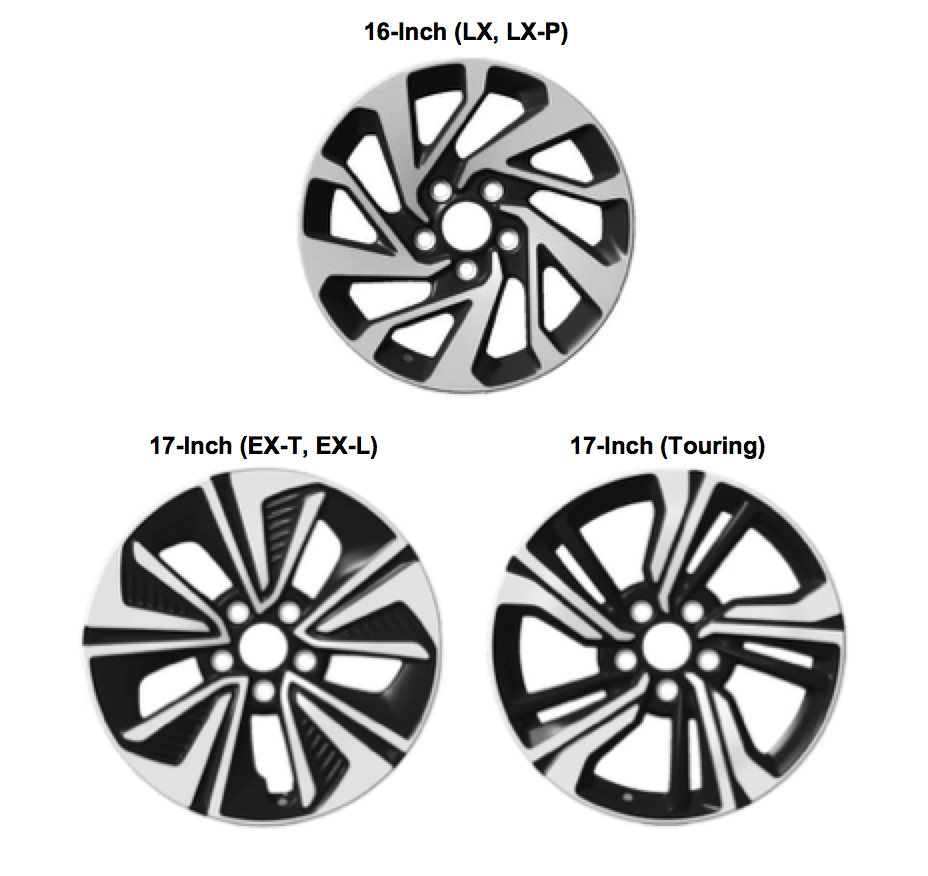
Space-Saving Spare Tire
For all new Civic models, the spare tire is a T125/80D16 space- and weight-saving temporary unit that is mounted under a carpeted floor in the trunk.
Low-Friction Wheel Bearings
For 2016, the wheel hubs in all models feature new low-friction bearings that measurably reduces rolling resistance, which directly contributes to the improved fuel-efficiency for all models.
Exhaust
The Civic LX and LX-P trims use a single exhaust system for light weight and simplicity. Applied to a Civic for the first time, dual exhaust outlets provide the Civic in EX-T and above trims higher power output for the turbocharged engine. Additionally, in another Civic first, all trims incorporate an exhaust flex tube that directly reduces noise and vibration. The silencer is also aerodynamically shaped, another Civic first, to help improve airflow underneath the vehicle, helping to improve fuel efficiency, reduce emissions, and further reduce air turbulence-inducing noise at highway speeds. See the Powertrain section for more information.
Fuel Tank
The 12.4-gallon fuel tank and fuel lines are molded of high-density polyethylene for low weight, freedom from corrosion, impact resistance and fuel vapor losses. The tank and filler pipe are formed as a single unit, reducing weight and complexity, while further improving safety in the event of a collision. Additionally, the tank is positioned ahead of the rear wheels to help guard against collision damage. A high-efficiency fuel pump is housed inside the tank, and the fuel filter is a lifetime design that never needs replacement. An integrated baffle system positioned inside the tank reduces the sound of fuel sloshing.
Tire Pressure Monitoring System (TPMS)
The 2016 Civic uses an indirect Tire Pressure Monitoring System (TPMS)3 that is lighter and simpler than previous systems. Instead of using sensors mounted on each wheel to monitor tire pressures, indirect TMPS uses the existing ABS wheel-speed sensors to continually monitor the rotational speed of each wheel. Because a tire with low pressure rotates more quickly than one with a higher pressure, by comparing these values with a specifically designed computer algorithm, indirect TPMS can determine when a tire is low on pressure. This information is delivered to the driver in the form of a warning symbol on the instrument panel. Special logic included in the TPMS processor is designed to eliminate false warnings.
Chassis Features
| Suspension and Chassis Features | LX | LX-P | EX-T | EX-L | Touring |
| MacPherson Strut Front Suspension | • | • | • | • | • |
| Multi-Link Rear Suspension | • | • | • | • | • |
| Stabilizer Bar (mm, front / rear) | 25.0 x t4.0/16.0 | 25.5 x t4.5/16.0 | 25.5 x t4.5/16.0 | 25.5 x t4.5/16.0 | 25.5 x t4.5/16.0 |
| Front fluid-filled suspension bushings | • | • | • | • | • |
| Rear fluid-filled suspension bushings | • | • | • | ||
| Dual-Pinion, Variable Ratio Electric Power-Assisted Rack-and-Pinion Steering (EPS) | • | • | • | • | • |
| Steering Wheel Turns, Lock-to-Lock | 2.2 | 2.2 | 2.2 | 2.2 | 2.2 |
| Steering Ratio | 10.93:1 | 10.93:1 | 10.93:1 | 10.93:1 | 10.93:1 |
| Turning Diameter, Curb-to-Curb (ft) | 35.7 | 35.7 | 35.7 | 35.7 | 35.7 |
| Power-Assisted Ventilated Front Disc / Solid Rear Disc Brakes (in, front/rear) | 11.1 / 10.2 | 11.1 / 10.2 | 11.1 / 10.2 | 11.1 / 10.2 | 11.1 / 10.2 |
| Wheels | 16" alloy | 16" alloy | 17" alloy | 17" alloy | 17" alloy |
| All-Season Tires | 215/55R16 M+S 93H | 215/55R16 M+S 93H | 215/50R17 M+S 91H | 215/50R17 M+S 91H | 215/50R17 M+S 91H |
| Compact Spare Tire | T125/80D16 97M | T125/80D16 97M | T125/80D16 97M | T125/80D16 97M | T125/80D16 97M |
| Vehicle Stability Assist™ (VSA®)1 with Traction Control | • | • | • | • | • |
| Agile Handling Assist | • | • | • | • | • |
| Straight Driving Assist | • | • | • | • | • |
| Electric Parking Brake (EPB) with Automatic Brake Hold | • | • | • | • | • |
| Hill Start Assist | • | • | • | • | • |
| Tire Pressure Monitoring System (TPMS)3 | • | • | • | • | • |
(See the Specifications and Features section for all data.)
1 VSA is not a substitute for safe driving. It cannot correct the vehicle's course in every situation or compensate for reckless driving. Control of the vehicle always remains with the driver.
2 The ABS does not reduce the time or distance it takes to stop the vehicle. It only helps with steering control during hard braking. Always drive appropriately for the conditions.
3 For optimal tire wear and performance, tire pressure should be checked regularly with a gauge. Do not rely solely on the monitor system. Please see your Honda dealer for details.
2016 Honda Civic Coupe Press Kit - Comfort and Convenience
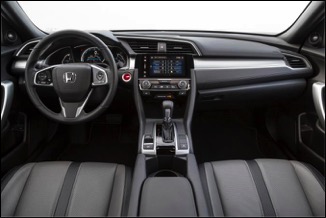
Overview
The new Civic brings an elevated level of comfort and convenience to an affordable, compact-class car, with numerous Civic firsts and standard or optional premium features typically found in more expensive vehicles. From the convenience of available Smart Entry and Pushbutton Start/Stop to the ease of use of the new electric parking brake and Hill Start Assist, the Civic offers useful technologies that make driving easier and more convenient.
Key Comfort and Convenience Features
- Smart Entry and Push Button Start (available)
- Remote Engine Start* (available)
- Hill Start Assist
- Auto-Dimming Rearview Mirror (available)
- Driver Preference Settings* (available)
- Capless Fueling System*
- Electric Parking Brake*
* First for Civic
^ First for Honda
Smart Entry and Push Button Start/Stop
The 2016 Civic offers the upscale convenience of Smart Entry and Push Button Start/Stop.
Remote Entry
Remote entry is standard equipment on all Civic models. The wave key design (LX trim) has an integrated transmitter in the handle with lock, unlock, trunk open and panic buttons.
Smart Entry
Smart Entry also allows the driver to approach, open and use the trunk without using a key or pressing a button on the remote. With the remote in his or her possession, the driver simply presses the release button and opens the trunk. As a safety and convenience feature, the Smart Entry system will not allow the transmitter fob to be locked in the interior of the Civic.
Push Button Start/Stop
On the Civic LX-P and above, once the driver has opened the door and is seated, the driver simply pushes the START/STOP button positioned on the instrument panel while pressing the brake pedal to start the vehicle. Powertrain operation and certain electrical functions are ended when the START/STOP button is pressed again at the conclusion of the drive. For accessory mode, the driver simply presses the START/STOP button without pressing the brake pedal. The new Civic's START/STOP button features a pulsating light to help the driver more easily locate the button.
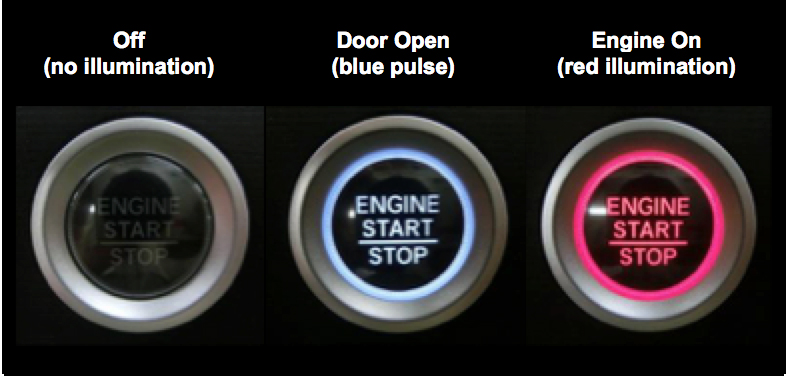
Remote Engine Start
Civic LX-P trims and above feature standard remote engine start. This enables drivers to start their Civic in advance of the drive, thereby activating the climate control system with a target temperature of 72 degrees before they get to the vehicle – particularly helpful in extreme hot- or cold-weather conditions. The system will automatically operate the heater, front and rear defrosters, front heated seats (if equipped), heated side mirror, and air conditioning as needed.
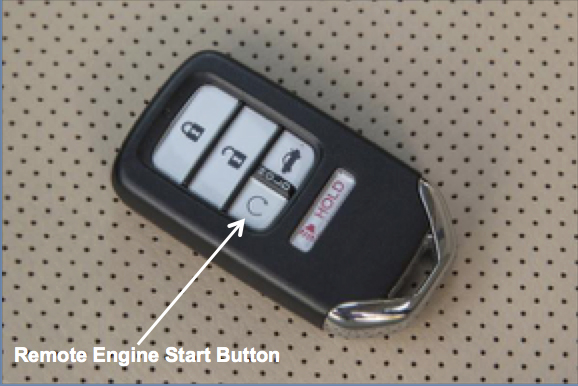
The remote engine start feature is built into the key fob supplied with the vehicle. To start the engine remotely, the owner presses the LOCK button and then holds the ENGINE button for a second. The Civic's hazard lights will flash, indicating that the signal has been received. When the engine is started remotely, the wipers, lighting and audio systems remain off, and the security system remains set. The engine will run for up to 10 minutes after remote starting and can be extended by another 10 minutes using the same procedure, and then shut off automatically if the owner doesn't reach the vehicle within that time. When the owner does get to the Civic within 10 minutes, or extended period if the procedure is initiated a second time, the engine will keep running while the owner unlocks the vehicle, gets in, applies the brake and presses the Civic's START button, which turns on all of the vehicle's systems.
Driver Preferences
The Civic LX-P and above trims come with two keyless remotes with unique identifiers. Each remote can be set with unique profiles to accommodate the individual preferences of two different drivers. Preferences include audio system pre-sets, air conditioning preferences, and navigation system settings. In the event both owners use the car at the same time, the Civic will recognize the keyless remote that approaches the driver's door first.
Locking
After parking, a press of the LOCK button on the remote will simultaneously lock all the doors and trunk. On EX-T and above trims a touch of the soft-touch lock button on either front door handle locks all doors and trunk to secure the Civic. The system will not allow the remote to be locked in the interior of the Civic.
Walk Away Door Lock
Included on EX-T and above trims, the new Walk Away Door Lock feature automatically locks the Civic when the driver leaves the vehicle. This hands-free locking capability adds everyday convenience that's especially useful when the driver has his or her hands full or is distracted. In typical use, when all doors are closed and the driver walks away, the Civic will automatically lock when the key holder's distance from the vehicle exceeds 6.5 feet for two seconds or more and when no other key is detected inside the vehicle. An audible buzzer sounds and the hazard lights flash to confirm that the vehicle has locked. The Walk Away Door Lock feature is programmable, and may be turned on or off as the driver prefers. (See the Exterior section for more information.)
Auto On/Off Headlights
All Civic models feature auto-on/off headlights for greater convenience. The headlights are multi-reflector/projector-beam units on all Civic models except the Touring, which has auto-on/off LED headlights. All Civic models feature dramatic LED Daytime Running Lights (DRL).
Auto-Dimming Rearview Mirror
A Civic first, the EX-L and Touring Coupe models feature an electrochromic interior rearview mirror that automatically dims during nighttime driving to reduce glare from the headlights of following vehicles.
Capless Fueling System
Capless fueling eliminates the fuel cap, meaning that fueling the vehicle simply requires opening the fuel lid, refueling, and then closing the lid. This smart and easy-to-use design eliminates the need to touch a dirty fuel cap, reduces the possibility of damaging the vehicle's paint with the fuel cap or tether, or forgetting the fuel cap at the gas station. It also eliminates the possibility of activating an emissions warning by failing to properly re-install the fuel cap. And finally, the capless fueling system allows the use of a smaller fuel-cap door, which cleans up the lines of the vehicle.
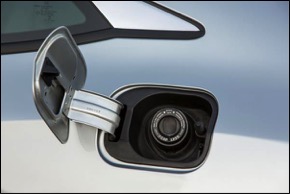
The system consists of two integrated components, an outer shutter mechanism that prevents the intrusion of dirt and dust, and a self-sealing fueling flap that is closed by a torsion spring. Both operate automatically.
At a gas station, the driver simply pushes the fuel lid to release it and then inserts the fuel nozzle. Inserting the nozzle automatically opens the outer shutter and fueling flap. When fueling is complete, removing the fuel nozzle automatically closes both the fueling flap and outer shutter.
Electric Parking Brake (EPB)
The Civic's Electric Parking Brake makes using the parking brake easier and more comfortable and frees up precious center console space for storage and other functions. (See the Chassis section for more information.)
Hill Start Assist
The Hill Start Assist function helps to prevent the vehicle from rolling backwards when the driver switches from the brake pedal to the accelerator pedal while the vehicle is stopped on a hill. (See the Chassis section for more information.)
Comfort and Convenience Features
Feature |
LX
|
LX-P
|
EX-T
|
EX-L
|
Touring
|
|
Automatic Climate Control System with Air Filtration |
•
|
•
|
|
|
|
|
Dual-Zone Automatic Climate Control System with Air Filtration |
|
|
•
|
•
|
•
|
|
Push Button Start |
|
•
|
•
|
•
|
•
|
|
Remote Engine Start |
|
•
|
•
|
•
|
•
|
|
Hill Start Assist |
•
|
•
|
•
|
•
|
•
|
|
Power Windows with Auto-Up/Down Driver's and Front Passenger's Window |
•
|
•
|
•
|
•
|
•
|
|
Power Door and Trunk Locks |
•
|
•
|
•
|
•
|
•
|
|
Cruise Control |
•
|
•
|
•
|
•
|
•
|
|
Tilt and Telescopic Steering Column |
•
|
•
|
•
|
•
|
•
|
|
Sliding Sunvisors |
•
|
•
|
•
|
•
|
•
|
|
12-Volt Power Outlet (front) |
•
|
•
|
•
|
•
|
•
|
|
Rear Window Defroster with Timer |
•
|
•
|
•
|
•
|
•
|
|
Trunk Light |
•
|
•
|
•
|
•
|
•
|
|
Capless Fuel Filler |
•
|
•
|
•
|
•
|
•
|
|
Illuminated Steering Wheel-Mounted Controls |
Cruise / Audio / Phone/ MID
|
Cruise / Audio / Phone/ MID
|
Cruise / Audio / Phone/ DII
|
Cruise / Audio / Phone/ DII
|
Cruise / Audio / Phone/ DII / Navi
|
|
Floor Mats |
•
|
•
|
•
|
•
|
•
|
|
Beverage Holders (Front Row/Rear Row) |
•
|
•
|
•
|
•
|
•
|
|
Driver's and Front Passenger's Vanity Mirrors |
•
|
with illumination
|
with illumination
|
with illumination
|
with illumination
|
|
Automatic-Dimming Rearview Mirror |
|
|
|
•
|
•
|
|
Leather-Wrapped Steering Wheel |
|
|
|
•
|
•
|
|
White Ambient LED Lighting |
•
|
•
|
•
|
•
|
•
|
|
60/40 Split-Folding Rear Bench Seat |
•
|
•
|
•
|
•
|
•
|
|
Head Restraints at all Seating Positions |
•
|
•
|
•
|
•
|
•
|
|
Leather-Trimmed Interior |
|
|
|
•
|
•
|
|
Heated Front Seats |
|
|
•
|
•
|
•
|
|
Rain-Sensing Windshield Wipers |
|
|
|
|
•
|
(See the Specifications and Features section for all data.)
2016 Honda Civic Coupe Press Kit - Exterior
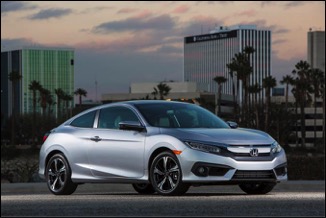
Overview
Differentiating itself from the Civic Sedan, the new Civic Coupe features a lower and more radically sloping roofline, shorter rear overhang, and aggressive rear styling with distinctive full-width light bar and overall more compact and sporty styling. With its athletic new stance, advanced aerodynamic styling and available LED lighting, the new coupe boasts a youthful, premium and sporty new style that advances Civic design into the next era. Its windswept lines are complimented by the most comprehensive aerodynamic packaging of any Honda to date, including complete underbody paneling, improving both fuel efficiency and cabin quietness. A new flush-mounted acoustic glass windshield further isolates the cabin while promoting smooth airflow, while new available features such as Smart Entry, Capless fueling, Remote Engine Start, rain-sensing windshield wipers and Walk Away door locks makes this the most sophisticated and easy-to-use Civic yet.
Key Exterior Features
- Acoustic glass, flush-mounted windshield
- LED daytime running lights (DRL)
- Projector-Beam Halogen Headlights with Auto-On/Off
- Available LED headlights
- Available LED turn signals
- LED taillights
- Available Honda LaneWatch™1
- Available One-Touch Power Moonroof with Tilt Feature
- Available Smart Entry and Push Button Start/Stop
- Available remote engine start
- Smart wipers
- Available Rain-sensing wipers
Exterior Styling
The new Civic Coupe provides an even sportier spin on its 10th generation sedan sibling with a distinctive sporty profile, lower roof line and shorter rear overhang that produces a crouched, dynamic style. Lower, longer, wider and more muscular than the previous generation, its flowing lines, new signature chromed “wing” front fascia and available premium LED lighting, extended wheelbase and short overhangs brand the new Civic as a leader in its class, both technologically and in design.
In front, aggressive aerodynamics, LED daytime running lights and an available in-line LED headlight array lend the new Civic a modern demeanor.
The muscular, high-tension side profile soars upward from the front wheel arches rearward, with a decisive character line rising through the doors and extending to the rear wheel arches. A second, lower character line extends from behind the front wheels up through the doors and meets the rear wheel arches, emphasizing the dynamic and emotional design. The new larger and wider wheel and tires further emphasize Civic’s purposeful stance, while the long wheelbase, short overhangs and sweeping cabin greenhouse further add to the dynamic feel of the exterior.
The windshield is flush-mounted to the cowl, improving aerodynamics and quieting the interior. Panel gaps are minimized and the B-pillars are black-finished, with stainless trim surrounding the side windows to visually emphasize the sweeping cabin shape. The side glass is flush with the pillars to reduce wind noise in the cabin, while also improving the quality feel of the new Coupe. Behind the sweeping roofline and C-pillars, the flush-mounted rear window is sleek and shallow, aiding to the new model’s aerodynamic efficiency.
From the A-pillars rearward, the Coupe features unique exterior styling with a lower and more steeply raked roofline, nearly 1 inch lower than the Sedan, and more compact proportions, with the rear overhang and overall length shortened by 5.5 inches. The new Coupe also features an exclusive rear taillight design that carries the arch of the distinctive C-shaped LED taillights across the full length of the rear deck lid.
LED Lighting
All 2016 Civic trims incorporate a wide range of LED exterior lighting features, including standard LED daytime running lights (DRL), LED one-touch turn signals (Touring), and LED taillights, license-plate light and center high-mounted stop light. Additionally, the Touring trim receives new Honda LED headlights in an in-line configuration and side mirror-mounted LED turn signals.
Civic Touring Coupe
In a first for the Civic, the Coupe in the new Touring trim includes LED low- and high-beam headlights. Arranged in a low, sleek and compact in-line display, the LED high beams provide a longer a wider range of visibility during nighttime driving. The Touring trim also includes LED turn signals integrated into the side mirror housings.
The LED lighting has several advantages beside improved visibility. The LEDs are both mercury free and lead free, benefiting the environment. They require less power to operate than traditional incandescent lighting, which helps the Civic’s fuel efficiency. They have a longer life and are maintenance free. And finally, the LED arrays are versatile, enabling the new Civic Coupe to offer breakthrough design elements not previously possible.
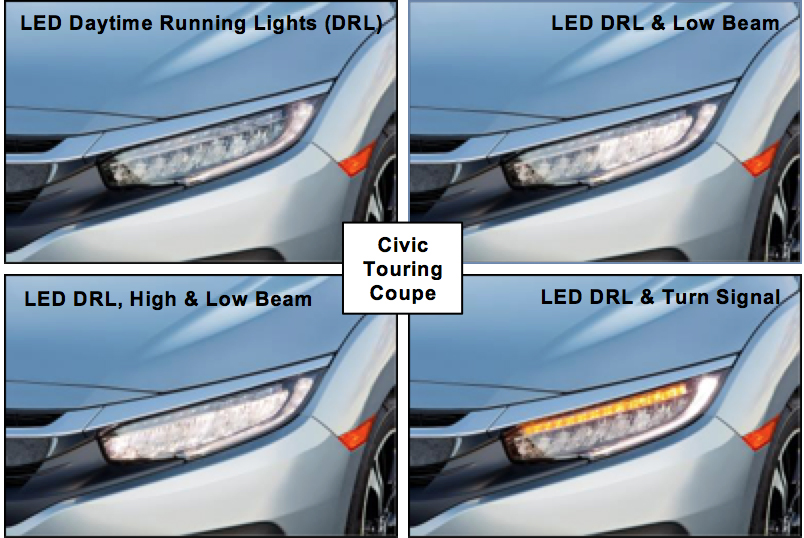
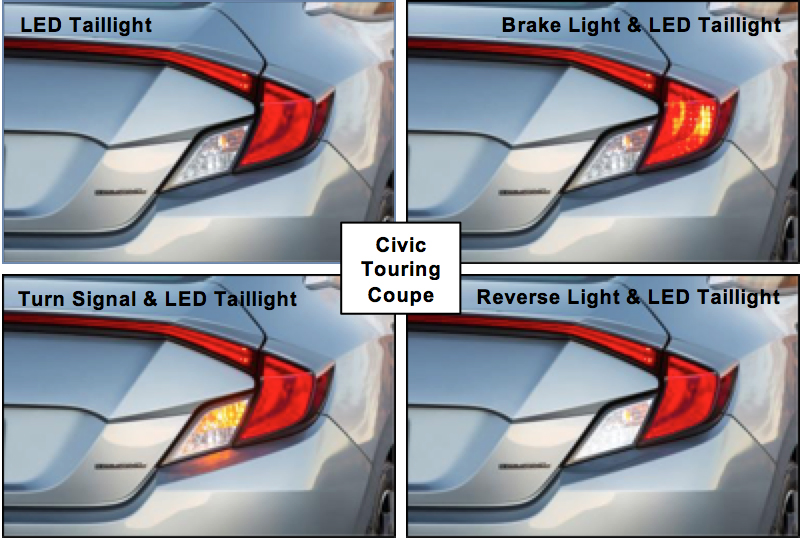
Power Side Mirrors
Newly designed power side mirrors have a complimentary design and are aerodynamically optimized to reduce wind noise and minimize turbulence. For 2016, the side mirror housings on all Civic models are body-colored. The Civic EX-T and above trims add heated side mirrors and the Touring trim further adds integrated front LED turn indicators. The side mirrors can be manually folded for greater convenience in tight parking situations.
Expanded View Driver's Mirror
The Expanded View Driver's Mirror is standard on all Civic Coupe models. (See the Safety and Driver Assistive section for more information.)
Honda LaneWatch™
The Civic EX-T and above trims include Honda's LaneWatch™1 display that uses a camera located at the bottom the passenger-side exterior mirror to display a wide-angle view of the passenger side roadway on the Display Audio screen. The image appears when the right turn signal is activated, or when a button on the end of the turn signal stalk is pressed. (See the Safety and Driver Assistive section for more information.)
One-Touch Power Moonroof with Tilt Feature
The Civic LX-P and above trims have a one-touch power moonroof with tilt feature that will fully open or close with a single touch of the switch. The moonroof mechanism was purposely designed to provide ample headroom. The moonroof has a sliding sunshade that opens with the roof and can be closed to block sunlight. To tilt or slide the moonroof, the driver or front passenger needs only to fully press the ceiling-mounted switch once (instead of pressing and holding it for several seconds). The moonroof fully opens or closes automatically. However, if the operator wishes to only partially open or close the moonroof (such as to achieve partial ventilation), a lighter touch yields fully manual control. The moonroof can also tilt to provide ventilation. An auto-reverse feature is built in, helping to ensure that the moonroof will not forcefully close if someone's hand or arm is detected in the path of the glass. If an obstruction is detected, the moonroof mechanism will reopen the moonroof.
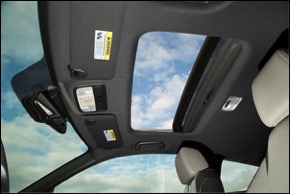
Power Windows and Locks
Power windows are standard equipment on all Civic models and include auto-up and -down operation on the driver and passenger windows. Power locks are standard, and a customizable auto-locking feature can be configured using the Driver Information Interface and steering wheel-mounted controls.
Smart Entry and Push Button Start/Stop
The Civic in LX-P and above trims include the upscale convenience of Smart Entry and Push Button Start/Stop. The system simplifies approaching, entering and operating the Civic. To gain entry, the driver/passenger simply pulls either of front door handles while the remote in his or her possession. (See the Comfort and Convenience section for more information.)
Remote Engine Start
Civic LX-P trims and above feature standard remote engine start. This enables drivers to start their Civic in advance of the drive, thereby activating the climate control system with a target temperature of 72 degrees before they get to the vehicle – particularly helpful in extreme hot- or cold-weather conditions. The system will automatically operate the heater, front and rear defrosters, front heated seats (if equipped), heated side mirror, and air conditioning as needed. (See the Comfort and Convenience section for more information.)
Windshield Wipers
The Civic LX and LX-P trims have 2-speed intermittent windshield wipers, while the EX-T and above trims have variable intermittent windshield wipers. The Touring trim has rain-sensing wipers described below.
Designed to cover the maximum possible windshield area, the left (driver) and right (front passenger) windshield wipers (intermittent on EX-T and above trims) are 25.5 inches and 18 inches long, respectively. For better appearance, the wipers are hidden low on the front cowl when not in operation. The wiper motor uses a built-in ECU, reducing complexity compared to the previous Civic's wiper mechanism. As well, a new wiper motor assembly saves 3.08 pounds compared to the previous generation.
Mounted on the windshield behind the rear view mirror, a Rain Light Sensor combines two functions into one unit to control the Smart Wipers and Rain Sensing Wipers functions listed below.
Smart Wipers
Laws in some states require drivers to turn on the headlights when the wipers are operating in the rain. In all trims, the new Civic helps its driver comply with these laws by automatically illuminating the headlights when the wipers are activated in rainy conditions (with headlight switch in Auto).
Details include:
- The light sensor detects the ambient brightness and determines when to turn on or off the headlights, while also increasing the illumination of the wiper switch and instrumentation for good visibility.
- If rain is intermittent, the lights stay on for a predetermined interval before automatically turning off again.
- Operation is shown via an indicator on the instrument panel.
- The sensitivity can be controlled by a setting in the MID.
Rain Sensing Wipers
In a first for Civic, the Touring trim includes rain-sensing wipers that automatically activate if water is detected on the windshield.
Details include:
- The rain sensor detects precipitation on the windshield and controls the wipers based on quantity of water detected.
- The sensitivity can be controlled by adjusting the intermittent wiper.
Capless Fueling System
A first for Civic, capless fueling eliminates the fuel cap, meaning that fueling the vehicle simply requires opening the fuel lid, refueling, and then closing the lid. This smart and easy-to-use design eliminates the need to touch a dirty fuel cap, reduces the possibility of damaging the vehicle's paint with the fuel cap or tether, or forgetting the fuel cap at the gas station. It also eliminates the possibility of activating an emissions warning by failing to properly re-install the fuel cap. And finally, the capless fueling system allows the use of a smaller fuel-cap door, which cleans up the lines of the vehicle. The fuel door unlocks with a handle remote release inside the vehicle.(See the Comfort and Convenience section for more information.)
Exterior Features
Features |
LX |
LX-P |
EX-T |
EX-L |
Touring |
|
One-Touch Turn Indicators |
• |
• |
• |
• |
• |
|
Acoustic windshield |
• |
• |
• |
• |
• |
|
One-Touch Power Moonroof with Tilt Feature |
|
• |
• |
• |
• |
|
Remote Keyless Entry |
• |
|
|
|
|
|
Smart Start/Entry* |
|
• |
• |
• |
• |
|
Walk Away Door Lock* |
|
• |
• |
• |
• |
|
LED daytime running lights (DRL) |
• |
• |
• |
• |
• |
|
Projector-beam halogen headlights with Auto on/off |
• |
• |
• |
• |
|
|
LED headlights* with Auto on/off |
|
|
|
|
• |
|
LED turn signals |
• |
• |
• |
• |
• |
|
Taillights with LED light bars |
• |
• |
• |
• |
• |
|
LED Center High Mount Brake Light |
• |
• |
• |
• |
• |
|
Fog lights |
|
|
• |
• |
• |
|
2-speed intermittent windshield wipers |
• |
|
|
|
|
|
Variable intermittent windshield wipers |
|
• |
• |
• |
• |
|
Smart wipers* |
• |
• |
• |
• |
• |
|
Rain sensing wipers* |
|
|
|
|
• |
|
Body-colored power side mirrors |
• |
|
|
|
|
|
Body-colored and heated power side mirrors |
|
|
• |
• |
|
|
Body-colored and heated power side mirrors with memory and integrated LED turn indicators |
|
|
|
|
• |
|
Body-colored door handles |
• |
• |
• |
• |
|
|
Chrome door handles |
|
|
|
|
• |
|
Capless fueling system* |
• |
• |
• |
• |
• |
* First for Civic
(See the Specifications and Features section for all data.)
Exterior Colors
All 2016 Civic Coupe trims are available in eight exterior colors including two new metallic colors and one new pearl color. All colors have a strong character, offering expressive contrasts that complement the Civic's body-panel curves and angles, while also exhibiting a smart sporty appearance. The colors are:
- Lunar Silver Metallic (new)
- Aegean Blue Metallic (new)
- Energy Green Pearl (new)
- Taffeta White
- White Orchid Pearl
- Modern Steel Metallic
- Crystal Black Pearl
- Rallye Red
The exterior colors are keyed to the 2016 Civic Coupe's new, two-tone interior colors:
- Black/Grayge
- Black/Ivory
See the following page for a table indicating exterior and interior colors.
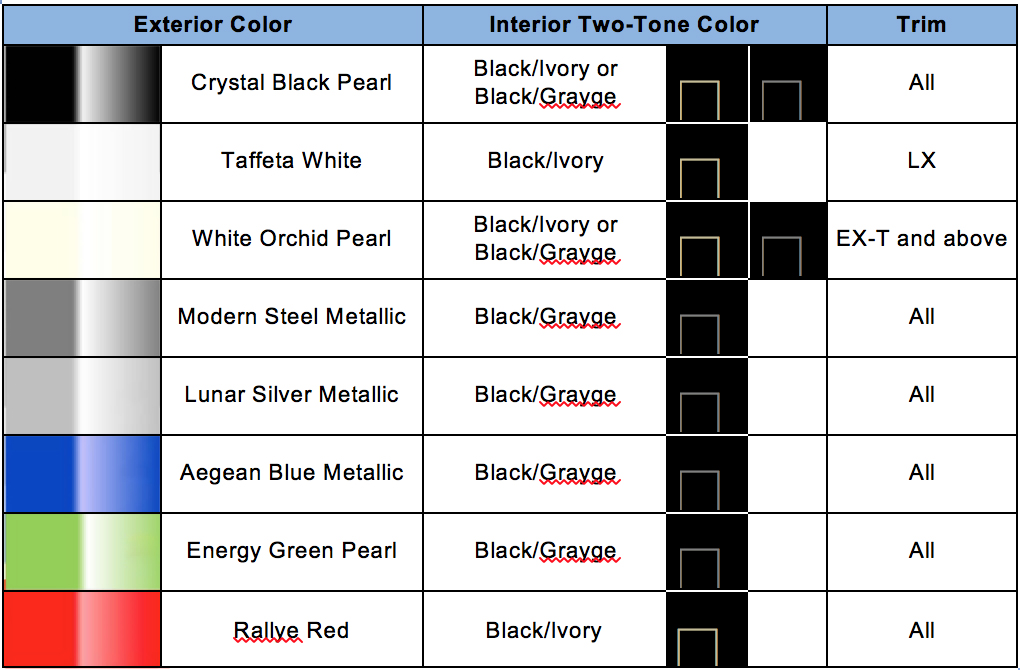
(See the Interior section for more information on interior colors.)
1 Display accuracy will vary based on weather, size of object and speed, and the display may not show all relevant traffic. The display is not a substitute for your own direct visual assessment of traffic conditions before changing lanes.
2016 Honda Civic Coupe Press Kit - Interior
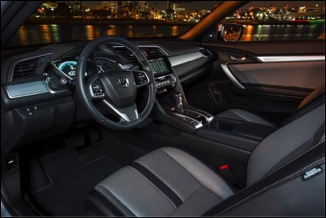
Overview
Benefitting from Honda's vehicle packaging expertise, the Civic interior – its spaciousness, smart design, comfortable fit and intuitive controls – has always been a competitive strength. The new Civic interior takes that concept forward with new levels of quality, refinement and spaciousness for Civic and the compact class.
With 91.0 cubic feet of passenger cabin volume, the Civic tops the compact-class for interior space and comfort, with class-leading headroom, legroom, shoulder clearance and side head clearance. Class-leading forward visibility of 84.31 degrees is aided by new, ultra-thin A-pillars, and rear-seat passengers will appreciate newly shaped front seats with a narrower upper profile (in the shoulder area) and smaller headrests that lend the rear cabin a more open, airy feel. The reworked instrument panel provides greater knee room for the driver, while rear-seat foot space in improved with an increase of 27mm in the space between the front seat rails.
The Civic Coupe has a trunk capacity of 12.1 cubic feet (LX and LX-P) – 0.4 cu-ft. larger than the previous model and among the largest in the competitive class. Spacious enough to easily accommodate four large golf bags, the new trunk area is easier to access and use, with a lower lift-over height and wider opening. The Civic Coupe features a 60/40 split and folding rear seatback. The shape of the trunk pass-through is now more rectangular with a 20-percent increase in area.
Key Interior Features
- 91.0 cubic feet of cabin space
- 12.1-cubic foot trunk (LX) with cargo pass-through
- 60/40 split and folding rear seat
- Ultra-thin A-Pillars for enhanced visibility
- Soft-touch, one-piece instrument panel upper
- 7-inch Display Audio touchscreen with integrated HVAC controls (EX-T and above)
- 7-inch Driver Information Interface (DII)
- Android Auto™1 and Apple CarPlay™ *2 (EX-T and above)
- Premium comfort and convenience features (see the Comfort and Convenience section)
- Smart Entry and Push Button Start (LX-P and above)
- Remote Engine Start* (LX-P and above)
- Hill Start Assist*
- Auto-Dimming Rearview Mirror* (EX-L and above)
- Walk Away Door Locking* (LX-P and above)
- Capless Fueling System*
- Electric Parking Brake*
* First for Civic
2016 Civic vs. 2015 Civic Interior Dimensions
Key Interior Dimensions |
2016 Civic Coupe |
2015 Civic Coupe |
Change |
|
Seating Capacity |
5 |
5 |
— |
|
EPA Passenger Volume (cu. ft.) |
91.0 |
83.2 |
+7.8 |
|
Cargo Volume (cu. ft.) LX |
12.1 |
11.7 |
+0.4 |
|
Head Room (in.) Front/Rear |
38.2 / 34.6 |
38.1 / 34.3 |
+0.1 / +0.3 |
|
Leg Room (in.) Front/Rear |
42.3 / 35.9 |
42.2 / 30.8 |
+0.1 / +5.1 |
|
Shoulder Room (in.) Front/Rear |
56.9 / 52.6 |
55.1 / 52.2 |
+1.8 /+0.4 |
|
Hip Room (in.) Front/Rear |
54.1 / 48.1 |
53.2 / 49.0 |
+0.9 / +0.9 |
(See the Specifications and Features section for all data.)
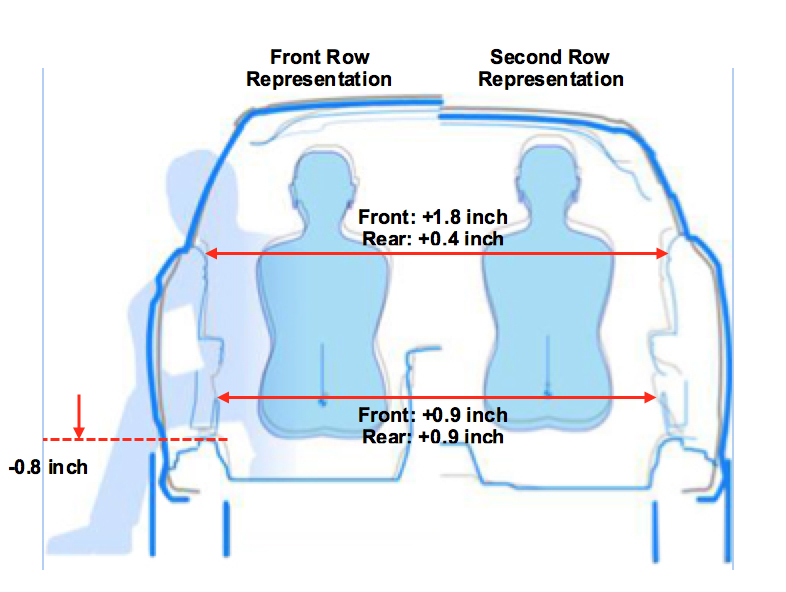
Interior Materials
The new Civic Coupe interior takes the refinement of Honda's most affordable coupe to a new level with high-quality premium touches and upscale materials applied liberally throughout. Highlights include a soft-touch instrument panel upper surface, door pad deck seams and soft door upper panels. Fit, finish and materials have received close attention, and soft leather-trimmed seating is standard on EX-L and Touring trims.

Interior Design
The new Civic interior blends a dynamic and wide layout with smoothly integrated technology features and-high quality materials. All Civic models have handsome new instrumentation, while EX-T and above trims feature a full-color 7-inch Driver Information Interface (DII) display, and 7-inch Display Audio color touchscreen with a clean and sleek appearance. The Civic has always been known for its user-friendly design, and the new generation builds on that reputation. With completely redesigned packaging, the Civic has a more open roomy feel assisted by such design changes as the backs of the front seats having new sleek styling giving rear passengers a spacious feeling. A redesigned instrument panel made possible a more compact climate control system opens up added knee room, and the tandem distance (distance between the front and rear seat hip point) is increased by 4 inches.
All important systems and controls in the Civic are positioned within easy reach of the driver. Controls for the systems used most frequently – audio, cruise control, Bluetooth®3 HandsFreeLink®, available navigation system with voice recognition and intelligent Multi-Information Display – are conveniently positioned on the steering wheel. The main instrumentation is an easy-to-read analog design, supplemented with digital and graphic displays. Typical of Honda interior design, the soft-touch switchgear of the Civic is engineered to deliver a high-quality feel and positive action.
Front Seats
The Civic's all-new front bucket seats are designed to provide welcoming support for a wide range of body types, along with secure lateral support for cornering. New seat frame designs are 17-percent lighter, more comfortable and more adjustable. A relocated seatback recline pivot point improves comfort, and the range of the seat bottom height adjustment has been increased by 10mm (0.4 in). A new available adjustable thigh support for the driver's seat offers 14-degrees of tilt. To help improve the forward view and create a feeling of openness for rear seat passengers, the front seatbacks have a narrower upper profile and smaller headrests. The Civic seats feature fabric seating surfaces in LX, LX-P and EX-T trims, with leather-trimmed seats in the EX-L and Touring trims, using perforated leather on select areas of the front seats.
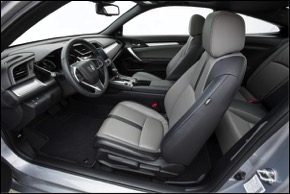
The driver's seat in the Civic Coupe is manually adjustable for fore-and-aft, seatback angle and height adjustment. Heating is now applied on the cloth interior EX-T as well as the leather trimmed seats of the EX-L and Touring with heated seat bottom cushions and front seatbacks. The 3-level front seat heater controls are positioned within easy reach, just below the climate control system controls.
Rear Seats
The Civic's roomy second-row seating is designed for maximum comfort and versatility, with a folding seatback. A 60/40 split and folding design makes it easy to accommodate passengers or long cargo.
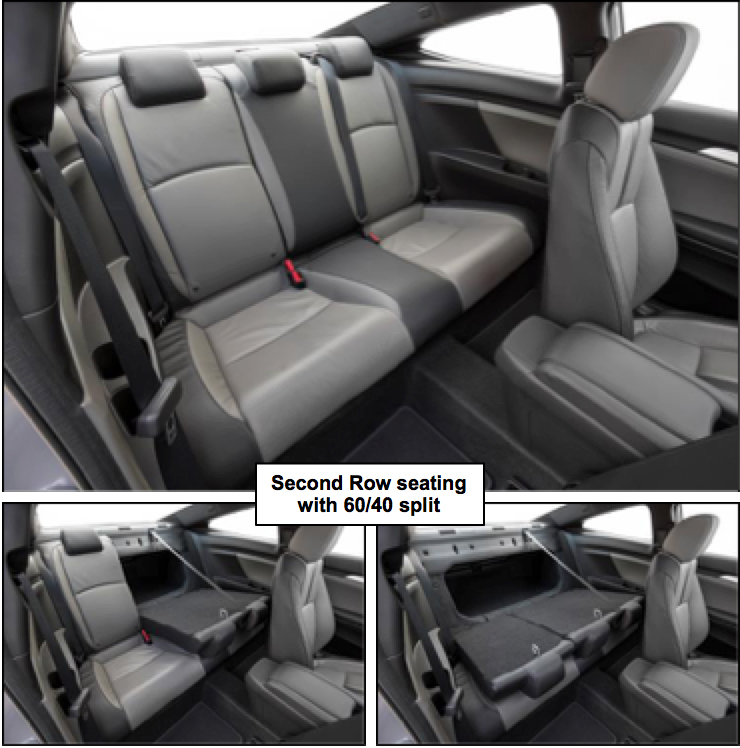
Center Console
The Civic interior offers a range of convenient storage features for the driver and passengers. The center console is specially engineered to offer a sporty appearance coupled with the versatile usability you might expect in an SUV. With the prevalence of smartphones in most people's lives, the console is engineered around a "tech center" theme. Up front, it has a 2-tier smartphone tray with a wire management pass-through for organized connectivity. EX-T and above trims have a rubber mat to help secure a phone and include LED lighting for nighttime visibility. There's also an additional phone storage pocket on the driver's side.
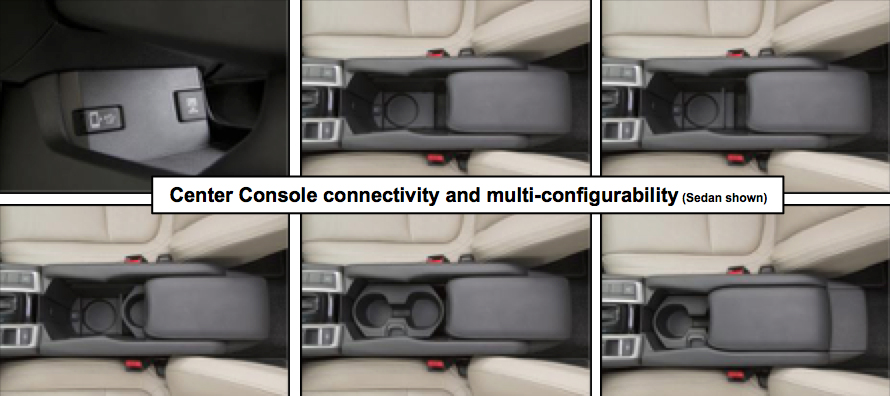
The new electric parking brake replaces the conventional manual parking brake lever, freeing up more console space for a larger armrest and greater storage space. The main storage compartment is topped by a sliding, deeply padded armrest that features an added inch of adjustability, compared to the previous Civic. A pair of cup holders are centrally located, and can accommodate large 42-ounce cups when the padded armrest is placed in the rearmost position. By sliding the adjustable cup holder rearward, there's space to accommodate even a large sports drink bottle. Inside the console, a small item tray slides fore and aft the full length of the console. With the cup holder removed, the console offers a class leading 7.2-liters of storage, enough to accommodate tablets and other large items. Two additional cup holders are located in the side linings of the second row.
Power Windows, Lock and Mirrors
Power windows are standard equipment on all Civic models and include auto-up and -down operation on the driver's and front passenger's windows. Power door locks and power mirrors are standard equipment on all Civic models. Civic EX-T and above include heated exterior mirrors. Smart entry is standard on Civic LX-P and above trims.
One-Touch Power Moonroof with Tilt Feature
The Civic LX-P trim and above have a one-touch power moonroof with tilt feature that will fully open or close with a single touch of the switch. (See the Exterior section for more information.)
Steering Wheel
The steering wheel, leather-wrapped on EX-L and Touring models, incorporates the most commonly used controls, allowing the driver to keep their hands on the wheel and their attention on the road. Bluetooth®3 HandsFreeLink® and audio system controls are located on the left side of the steering wheel, and include a new touchpad control that makes is easy to quickly adjust audio volume and scroll and select items that appear on the audio screen. Cruise control controls are on the right and Driver Information Interface (DII) controls are located on the left side. The Touring trim has LKAS and ACC controls located on the right side of the steering wheel as well. In all trims, the steering wheel offers manual tilt and telescopic adjustment.
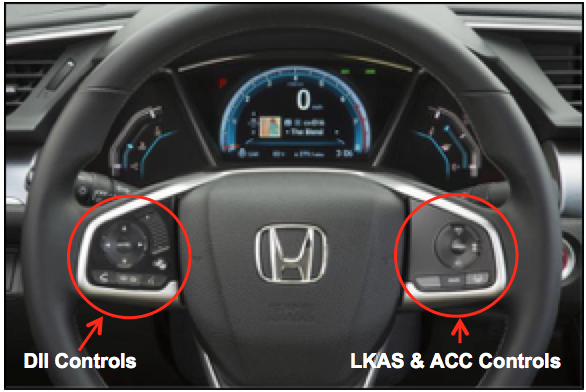
Climate Control Systems
For the first time ever, all Civic models have a standard automatic climate control system. The new system offers a 10-percent improvement in warm-up time compared to the previous system and now features a refrigerant with a much lower GWP (Global Warming Potential). To help conserve energy, the system employs a new Variable Displacement Compressor (VDC). Unlike a conventional compressor which can only operate at 100-percent and must be switched on and off frequently to conserve fuel when the cooling load is relatively low, the VDC can vary its output based on the cooling needs, resulting in greater efficiency, reduced drag on the engine and smoother climate-control performance.
Civic EX-T and above trims include dual-zone operation, for the optimal comfort of both the driver and front-seat passenger; and in addition to physical controls, incorporate climate control functions in the Display Audio touchscreen on EX-T and above trims.
Sliding Sunvisors
To provide more flexible shading from the sun, all Civics now come standard with sliding sunvisors. The driver and front passenger sunvisors can now be moved along their mounting shafts, with 3.9 inch range of motion, to provide perpendicular shade for the eyes even when the front seats are in their rear-most position.
Meters
The Civic LX and LX-P have analog instrumentation with large tachometer, flanked by a coolant-temperature gauge on the left and fuel-level gauge on the right. A digital speedometer is positioned in the center of the tachometer. EX-T models and above have a central Thin-Film Transistor (TFT) Driver Information Interface (DII) color display that depicts an analog tachometer, digital speedometer and additional selectable information.
The gauge package progressively illuminates to give the driver a welcoming feel upon entry. When the door is first opened, the instrument lighting illuminates and then brightens progressively to 100-percent illumination when the ignition is switched on. The illuminated instrument panel then comes alive, indicating that the car is ready to go. At the end of the drive, the instrument lighting dims progressively.
Driver Information Interface (DII)
The Civic instrument panel provides important vehicle information via a Driver Information Interface (DII) positioned centrally in the meter panel. Controls positioned on the right side of the steering wheel allow the driver to cycle the DII display through multiple screens of information. The Maintenance Minder™ system alerts the Civic driver of upcoming maintenance needs via the DII and should a fault occur with the vehicle, specific warning information will appear. The display indicates when to change the oil, air cleaner, transmission fluid, spark plugs or coolant, as well as when to rotate the tires.
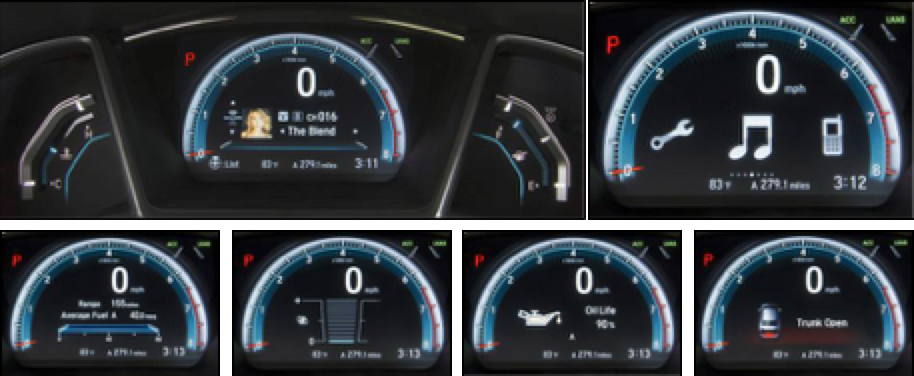
Driver Information Interface (DII) Features
Features |
LX |
LX-P |
EX-T |
EX-L |
Touring |
|
7-Inch Color TFT Screen |
|
|
• |
• |
• |
|
Speedometer |
• |
• |
• |
• |
• |
|
Tachometer |
• |
• |
• |
• |
• |
|
Average Fuel Economy Indicator |
• |
• |
• |
• |
• |
|
Door and Trunk-Open Indicator |
• |
• |
• |
• |
• |
|
Engine Oil-Life Indicator |
• |
• |
• |
• |
• |
|
CVT Position Indicator |
• |
• |
• |
• |
• |
|
Instant Fuel Economy Indicator |
• |
• |
• |
• |
• |
|
Miles-to-Empty Indicator |
• |
• |
• |
• |
• |
|
Odometer and Trip Meters (2) |
• |
• |
• |
• |
• |
|
Starter System Indicator |
• |
• |
• |
• |
• |
|
TPMS*4 |
• |
• |
• |
• |
• |
|
Exterior Temperature Indicator |
• |
• |
• |
• |
• |
|
Turn-By-Turn Directions |
|
|
|
|
• |
|
Customizable Feature Settings |
|
|
• |
• |
• |
(See the Specifications and Features section for all data.)
Instrumentation
Features |
LX |
LX-P |
EX-T |
EX-L |
Touring |
|
12-Volt Battery-Charging System Indicator |
• |
• |
• |
• |
• |
|
ABS Indicator |
• |
• |
• |
• |
• |
|
Airbag System Indicator |
• |
• |
• |
• |
• |
|
Brake System Indicator |
• |
• |
• |
• |
• |
|
Coolant Temperature Indicator |
• |
• |
• |
• |
• |
|
Cruise Control Indicators |
• |
• |
• |
• |
• |
|
Digital Speedometer |
• |
• |
• |
• |
• |
|
ECON Button |
• |
• |
• |
• |
• |
|
ECON Mode Indicator |
• |
• |
• |
• |
• |
|
EPS Indicator |
• |
• |
• |
• |
• |
|
Fuel Level Indicator |
• |
• |
• |
• |
• |
|
Headlights-On Indicator |
• |
• |
• |
• |
• |
|
High-Beam Indicator |
• |
• |
• |
• |
• |
|
Fog Light Indicator |
|
|
• |
• |
• |
|
Immobilizer System Indicator |
• |
• |
• |
• |
• |
|
Low-Fuel Indicator |
• |
• |
• |
• |
• |
|
Low-Oil Pressure Indicator |
• |
• |
• |
• |
• |
|
Malfunction Indicator |
• |
• |
• |
• |
• |
|
Seat-Belt Reminder Indicator |
• |
• |
• |
• |
• |
|
Security System Indicator |
• |
• |
• |
• |
• |
|
System Message Indicator |
• |
• |
• |
• |
• |
|
Tachometer |
• |
• |
• |
• |
• |
|
TPMS Indicator |
• |
• |
• |
• |
• |
|
Turn Signal/Hazard Indicators |
• |
• |
• |
• |
• |
|
VSA System and VSA-Off Indicators |
• |
• |
• |
• |
• |
|
Smart Entry System Indicator |
|
• |
• |
• |
• |
|
ACC On and System Indicators |
|
|
|
|
• |
|
FCW Indicator |
|
|
|
|
• |
|
CMBS Indicator |
|
|
|
|
• |
|
Low Speed Follow Indicator |
|
|
|
|
• |
|
LDW Indicator |
|
|
|
|
• |
|
RDM On and System Indicators |
|
|
|
|
• |
(See the Specifications and Features section for all data.)
Trunk
The Civic Coupe has a trunk capacity of 12.1 cubic feet (LX) – 0.4 cu-ft. larger than the previous models, and among the largest in the competitive class. Spacious enough to easily accommodate four large golf bags, the new trunk area is easier to access and use. The liftover height has been reduced by an inch, and the opening is wider and longer front to rear. Inside, the cargo floor is 2.8 inches longer front to rear, and the vertical height of the cargo compartment has increased by 1.6 inches. All Civic Coupes have a 60/40 split and folding rear seatback. The shape of the trunk pass-through is now more rectangular and with a larger area, from 2.9 sq-ft. to 3.5 sq-ft., loading long items is much easier. The trunk is carpeted and lined, and a temporary spare is located in a well under a removable section of the cargo-area floor.

Engine Immobilizer
Complementing the remote entry system is a standard engine-immobilizer system. A special electronically coded key prevents the car from being started-even if a mechanical duplicate of the key is used. A transponder, built into the key, signals the immobilizer control unit that the key is genuine. If the car is hot-wired, or an unauthorized key is used, the engine will not start.
Continuously Variable Transmission Controls
When equipped with the available Continuously Variable Transmission, the Civic has a conventional straight-gate shifter that is intuitive and easy-to-use and takes up little space in the center console. New LED indicator lights on the console make the current gear setting and selection clear and simple.
Interior Colors
The Civic's interior palette is sophisticated and coordinated and is offered in new black/grayge, or black/ivory colors – fabric in the LX, EX, EX-T, leather in the EX-L and Touring.
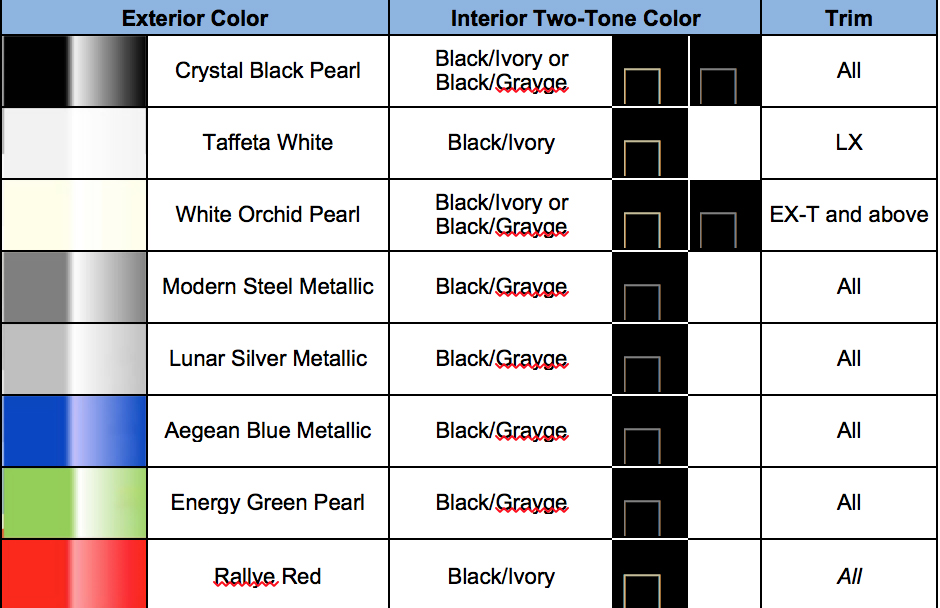
(See the Exterior section for more information about exterior colors.)
1 Android and Android Auto are trademarks of Google Inc.
2 Apple CarPlay is a registered trademark of Apple Inc.
Depending on use, Android Auto or Apple CarPlay™ can share certain user and vehicle information (e.g., vehicle location, speed and other operating conditions) with Google and its service providers or the connected iPhone, respectively. See Google's and Apple's privacy policies for details regarding the use and handling of data uploaded by Android Auto or Apple CarPlay™. Use of Android Auto or Apple CarPlay™ is at user's own risk, and is subject to agreement to the Android Auto or Apple CarPlay™ terms of use, which are, respectively, presented to the user when the Android Auto application is downloaded to the user's Android phone or included as part of the Apple iOS terms of use. Android Auto and Apple CarPlay™ vehicle integration is provided "as is," and Honda cannot guarantee operability or functionality now or in the future due to, among other conditions, changes in the applicable software or operating system, service interruptions, or incompatibility or obsolesce of vehicle-integrated hardware or software. See dealer for details. Only use Android Auto or Apple CarPlay™ when conditions allow you to do so safely.
3 The Bluetooth® word mark and logos are owned by the Bluetooth SIG, Inc., and any use of such marks by Honda Motor Co., Ltd., is under license.
4 For optimal tire wear and performance, tire pressure should be checked regularly with a gauge. Do not rely solely on the monitor system. Please see your Honda dealer for details.
2016 Honda Civic Coupe Press Kit - Powertrain
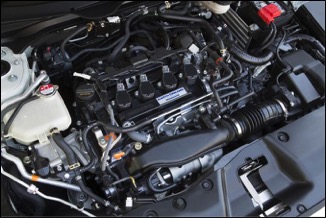
Overview
With two advanced new engines and new and updated manual and Continuously Variable Transmissions, first introduced in the 2016 Civic Sedan, the Civic Coupe offers a range of new powertrain choices that combine fuel efficiency and fun-to-drive performance.
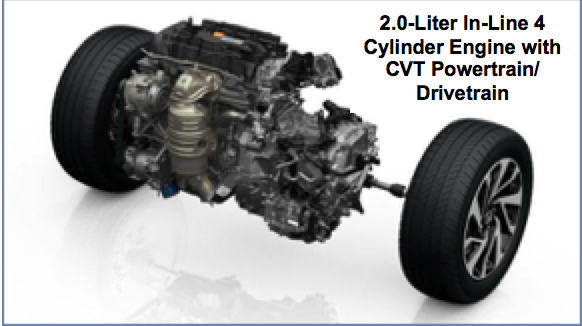
The base engine is a 2.0-liter 16-Valve DOHC i-VTEC®, with its larger displacement (replacing Civic's previous SOHC 1.8-liter engine), offers more horsepower and torque than any previous base Civic engine in the U.S. The new 2.0-liter engine is rated at 158 horsepower at 6500 rpm1 and 138 lb-ft. of torque at 4200 rpm2 (an increase of 15 horsepower and 9 lb-ft. of torque). The 2.0-liter engine is paired with a new 6-speed manual transmission (LX) or a Continuously Variable Transmission (CVT) for efficient automatic operation.
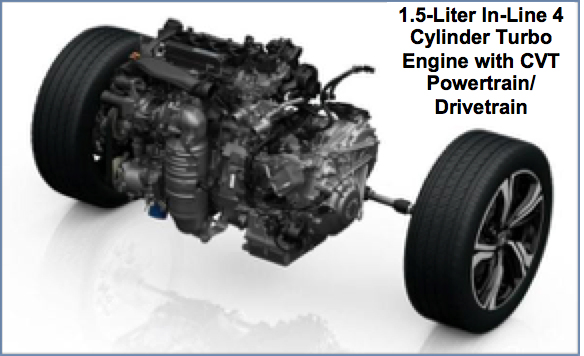
For drivers looking for even greater performance coupled with equally high EPA fuel economy ratings, the Civic is available with a turbocharged engine. The 1.5-liter 16-valve DOHC direct-injected turbocharged powerplant is rated at 174 horsepower at 6,000 rpm3 with torque output an impressive 162 lb-ft. of torque between 1,700 and 5,500 rpm4.
Both engines are designed to be LEV3-ULEV125/LEV3-SULEV 30 emissions compliant5. The more efficient engines and transmissions, along with improved aerodynamics and a major reduction in running resistance, result in substantially enhanced performance and fuel efficiency. Compared to the previous Civic 1.8-liter with either manual transmission or CVT, anticipated EPA highway fuel economy ratings6 are up across the board:
- +4 mpg on 2.0-liter with 6MT to 40
- +2 mpg on 2.0-liter with CVT to 41
- +2 mpg on 1.5-liter Turbo with CVT to 41
Key Powertrain Features
Engines
- 2.0-liter, DOHC 4-cylinder engine
- 158 horsepower at 6500 rpm (SAE net)1
- 138 lb-ft. torque at 4200 rpm (SAE net)2
- i-VTEC® (intelligent Variable Valve Timing and Lift Electronic Control) with dual VTC (Variable Valve Timing Control)
- Programmed Fuel Injection (PGM-FI)
- 10.8:1 compression ratio
- Lightweight, high rigidity steel crankshaft
- Drive-by-Wire throttle system
- Port injection system
- Maintenance Minder™ system optimizes service intervals
- 100,000 +/- miles tune-up interval7
- Turbocharged 1.5-liter, DOHC direct-injected 4-cylinder engine
- 174 horsepower at 6,000 rpm (SAE net)3
- 162 lb-ft. torque at 1,700-5,000 rpm (SAE net)4
- Dual VTC (Variable Valve Timing Control)
- Low inertia mono scroll turbo system
- Computer-controlled Direct Injection (DI) with multi-hole fuel injectors
- 10.6:1 compression ratio
- Lightweight, high rigidity steel crankshaft
- Drive-by-Wire throttle system
- Turbocharged 1.5-liter, DOHC direct-injected 4-cylinder engine (cont.)
- Maintenance Minder™ system optimizes service intervals
- 100,000 +/- miles tune-up interval7
Emissions/Fuel Economy Ratings
- Designed to be LEV3-ULEV125/LEV3-SULEV30 Emissions compliant5
- Improved U.S. EPA fuel-economy ratings (city/highway/combined) (anticipated)
- 26/38/31 mpg6 (2.0-liter with 6MT)
- 30/41/34 mpg6 (2.0-liter with CVT)
- 31/41/35 mpg6 (1.5-liter turbo with CVT)
Transmissions
- 6-speed Manual (2.0-liter)
- Continuously Variable Transmission (2.0-liter)
- Continuously Variable Transmission (1.5-liter turbo)
Engine Architecture and Features
2.0-Liter 4-Cylinder Engine
Related to the European Civic Type-R 2.0 liter turbo charged engine, the Civic's new standard 2.0-liter i-VTEC powerplant produces more horsepower and torque at all operating speeds compared to the 1.8-liter engine it replaces. The new engine also is anticipated to help the Civic receive superior EPA mpg ratings.6 The new 2.0-liter engine is rated at 158 horsepower at 6,500 rpm1 and 138 lb-ft. of torque at 4,200 rpm.2 The anticipated EPA fuel economy rating is 26/38/31 mpg6 city/highway/combined with 6-speed manual transmission, and 30/41/34 mpg6 with CVT.
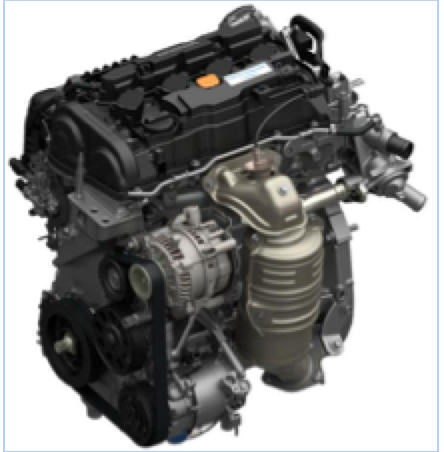
Cylinder Block and Crankshaft
The Civic's new 2.0-liter inline four has a lightweight die-cast aluminum block with a bedplate main-bearing design that creates a rigid assembly to help minimize noise and vibration. Cast-in iron cylinder liners provide long-lasting durability. Thin slits between each adjacent cylinder sleeve help improve engine cooling and knocking.
Each journal on the lightweight heat-forged steel crankshaft is micropolished to reduce internal friction and improve smoothness throughout the rpm range and help lower noise levels.
Pistons/Connecting Rods
Designed with "cavity-shaped" crowns, the 2016 Civic's pistons help maintain stable combustion and contribute to improved efficiency. To reduce weight, minimize vibration and increase operating efficiency, the lightweight pistons have a carefully optimized skirt design. Ion-plated piston rings help reduce friction for greater operating efficiency.
Heavy-duty steel connecting rods with tapered small ends are heat-forged in one piece and then "crack separated" to create lighter and stronger rods with an optimally fitted bearing cap.
Cylinder Head and i-VTEC Valvetrain
The Civic's 2.0-liter 4-cylinder engine has a lightweight DOHC cylinder head that is made of low-pressure casted aluminum alloy. With exhaust-port passages cast directly into the cylinder head, the need for a traditional separate exhaust manifold is eliminated.
A low-friction silent-chain drives dual overhead cams and four valves per cylinder. The cam drive is maintenance free throughout the life of the engine. To help further reduce friction, the finish of the camshaft journals has been improved. To improve cooling and detonation resistance, the cylinder head has a cooling passage placed between each pair of exhaust valves.
To help boost fuel efficiency and power, the combustion chamber shape and valve angles have been optimized. The included valve angle is 35 degrees, to decrease the surface-to-volume ratio of the combustion chambers and help create a flatter, more compact combustion chamber that reduces unburned hydrocarbon emissions. With this new combustion chamber shape, the compression ratio has been increased to 10.8:1 (up from 10.6:1 on the previous 1.8-liter engine), yet the engine still operates on regular unleaded fuel.
The cylinder head features a new high-tumble intake-port design. In combination with the new combustion chamber and piston crown shape, the design's high level of airflow tumble helps create a homogenous fuel mixture for low fuel consumption and high airflow for high power output.
The Civic's 2.0-liter DOHC 16-valve i-VTEC® engine uses an advanced valve control system to combine high power output with high fuel efficiency and low emissions. The system combines dual VTC (Variable Valve Timing Control), which continuously adjusts the intake and exhaust camshaft phase, with Variable Valve Timing and Lift Electronic Control (VTEC), which changes valve lift, timing and duration of the intake valves.
The "intelligent" portion of the system is its ability to continuously vary the timing of the intake and exhaust camshafts using variable valve timing control (VTC). This helps increase power and also provides a smoother idle (allowing idle speed to be reduced). The cam timing is varied based on input from sensors that monitor rpm, timing, throttle opening, cam position and exhaust air-fuel ratio. The result is increased fuel efficiency and lower emissions. Under certain conditions, the VTC can hold the intake valves open longer to allow a reverse airflow of intake air into the intake manifold.
Programmed Fuel Injection (PGM-FI)
The 2.0-liter engine's Programmed Fuel Injection (PGM-FI) continually adjusts fuel delivery to yield the best combination of power, low fuel consumption and low emissions. Multiple sensors constantly monitor critical operating parameters, such as throttle position, intake air temperature, coolant temperature, ambient air pressure, intake airflow volume, intake manifold pressure, exhaust air-fuel ratio and the position of the crankshaft and cams.
Turbocharged 1.5-Liter 4-Cylinder Engine
The Civic's available new DOHC 1.5-liter engine is the first turbocharged engine ever to be offered in a Honda-brand automobile in America. With direct injection, low-inertia mono scroll turbo system with electrical wastegate and dual Variable Valve Timing Control (VTC), the turbocharged Civic powerplant develops the horsepower and torque of a much larger engine, and is anticipated to help the Civic Coupe receive excellent EPA estimated fuel economy ratings.
The turbocharged 1.5-liter engine is rated at 174 horsepower at 6,000 rpm3 with 162 lb.-ft of torque between 1,700 and 5,500 rpm.4 The Civic Turbo is anticipated to be rated by the EPA at 31/41/35 mpg.6
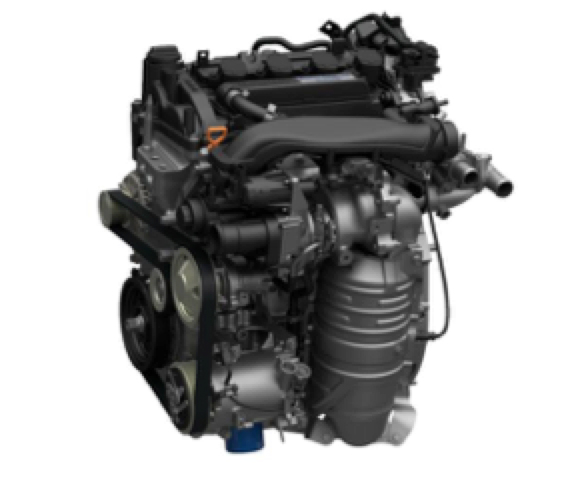

See the 1.5 L Turbo engine animation for a visual representation of prominent engine features and functions
Cylinder Block and Crankshaft
The Civic's 1.5-liter engine has a lightweight die-cast aluminum block with individual reinforced main bearing caps to minimize weight. Cast-in iron cylinder liners provide long-lasting durability. Each journal on the lightweight forged-steel crankshaft is micropolished to reduce internal friction.
Pistons and Connecting Rods
The 1.5-liter engine's pistons help maintain stable combustion and contribute to improved efficiency with "cavity-shaped" crowns. The lightweight pistons have a carefully optimized skirt design to minimize reciprocating weight, which minimizes vibration and increases operating efficiency. The pistons are cooled by twin oil jets directed at the underside of each piston crown. Ion-plated piston rings help reduce friction for greater operating efficiency. Lightweight, high-strength steel connecting rods are heat-forged in one piece and then "crack separated" to create a lighter and stronger rod with an optimally fitted bearing cap.
Cylinder Head and Valvetrain
The direct-injected Civic 4-cylinder turbocharged engine has a lightweight DOHC cylinder head that is made of pressure-cast aluminum alloy. With exhaust port cast directly into the cylinder head, the need for a traditional separate exhaust manifold is eliminated.
A low-friction, silent-chain drives dual overhead cams and four valves per cylinder. The cam drive is maintenance free throughout the life of the engine. To help further reduce weight, new thin-wall hollow camshafts are used.
To benefit fuel efficiency, emissions and power, the turbo engine utilizes sodium filled exhaust valves. A hollow chamber within the valve contains sodium that is cooled by the exhaust port cooling jacket. As the chamber reaches close to the valve head, the sodium helps to cool the entire valve. As the valve is internally cooled it doesn't need the enriched fuel mixture that was generally used in turbo engines to help cool the exhaust valve. The resultant leaner mixture reduces emissions, increases fuel efficiency and helps increase power.
The cylinder head includes smaller M12 sparkplugs, down from the more common M14, to save space and weight. The head also includes direct-injection multi-hole fuel injectors with a small diameter bore. Higher-pressure direct injection optimizes fuel atomization, allowing for more efficient combustion. To provide a high-tumble intake charge that further enhances combustion efficiency, both the intake port and piston crown have special designs.
The Civic Turbo engine features Variable Valve Timing Control (VTC) that can vary the timing of both the intake and exhaust camshafts independently. With the turbo engine's variable cam timing, the cam timing can be optimized to suit the driving conditions. Under light loads, valve overlap can be increased to reduce pumping losses and improve fuel efficiency. When engine speed is low and engine load is large, such as during initial acceleration, the amount of overlap is increased to boost the scavenging effect, which improves torque and responsiveness. When engine speed is high and engine load is also high, such as during full-throttle acceleration, the amount of valve overlap is reduced, improving both intake and scavenging and increase engine output.
Direct Injection System
The direct-injection system enables increased torque across the engine's full operating range along with higher fuel efficiency. The system features a compact, high-pressure, direct-injection pump that allows both high fuel flow and pulsation suppression, while variable pressure control optimizes injector operation. A multi-hole injector delivers fuel directly into each cylinder (not to the intake port, as in conventional port fuel injection designs), allowing for more efficient combustion.
The multi-hole injectors can create the ideal stoichiometric fuel/air mixture in the cylinders for good emissions control. Theoretically, a stoichiometric mixture has just enough air to completely burn the available fuel. Based on the operating conditions, the direct-injection system alters its function for best performance. Upon cold engine startup, fuel is injected into the cylinders on the compression stroke. This creates a weak stratified charge effect that improves engine start-up and reduces exhaust emissions before a normal operating temperature is reached.
Once the engine is fully warmed up, for maximum power and fuel efficiency fuel is injected during the intake stroke. This helps create a more homogeneous fuel/air mix in the cylinder that is aided by the high-tumble intake port design. This improves volumetric efficiency, and the cooling effect of the incoming fuel improves anti-knock performance.
Low Inertia Mono Scroll Turbo System with Electric Wastegate
The turbocharged Civic engine employs a small-diameter turbine for maximum responsiveness. The mono scroll housing design helps the turbo build boost even at relatively small throttle openings and low rpm. The electrically-actuated wastegate allows boost pressure to be precisely controlled.

A large air-to-air low-restriction intercooler is positioned low in the front of the car where it receives unobstructed airflow when the vehicle is in motion. Intake air travels from the air filter, to the turbo compressor, on to the intercooler, then to the engine's intake ports. The intercooler helps reduce the temperature of air entering the engine, making it denser for greater performance. To reduce weight, the turbo system is plumbed with rigid, lightweight resin composite inlet pipes to carry intake air to and from the intercooler.
Common Engine Features
ECON Mode
Every 2016 Civic is equipped with a green ECON button located on the center console near the shift lever. When the button is pushed to activate ECON mode, several operating characteristics of the vehicle are modified for enhanced fuel efficiency. The Drive-by-Wire throttle system provides more gradual response, and to save additional energy, the climate control's fan speeds are lowered incrementally and other climate control system characteristics are altered based on the conditions. Another push of the ECON button reverts all systems to their normal mode.
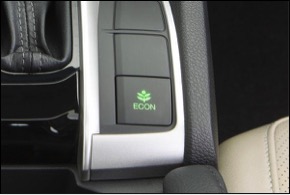
Friction Reducing Technology
Both of Civic's engines make use of new friction-reducing technologies designed to improve engine efficiency. The outer skirts of lightweight aluminum pistons feature a low-friction coating applied in a unique pattern application. The result is reduced overall friction as the pistons move within the cylinder bores. Plateau honing further lowers the friction level between the pistons and the cylinders by creating an ultra-smooth surface. Plateau honing is a 2-stage machining process that uses two grinding processes instead of the more conventional single honing process. This also enhances the long-term wear characteristics of the engine. Low viscosity oil (0W-20) also reduces friction. Other contributors to overall operating efficiency are a special two-stage oil pump relief valve, low-friction oil seals, special low-drag piston ring design, low-friction cam chain and a lightweight crankshaft.
Drive-by-Wire Throttle System
The Civic's Drive-by-Wire throttle system replaces a conventional throttle cable with smart electronics that "connect" the accelerator pedal to a throttle valve inside the throttle body. The result is less under-hood clutter and lower weight, as well as quicker and more accurate throttle actuation. Plus, a specially programmed "gain" rate between the throttle pedal and engine offers improved drivability and optimized engine response to suit specific driving conditions.
Honda's Drive-by-Wire throttle system evaluates the current driving conditions by monitoring throttle pedal position, throttle valve position, engine speed (rpm) and road speed. This information is used to define the throttle control sensitivity that gives the Civic's throttle pedal a predictable and responsive feel that meets driver expectations.
Emissions Control
Both 2016 Civic engines are designed to meet the tough EPA LEV3-ULEV125/LEV3-SULEV30 emissions standards,5 and are certified to this level of emissions performance for 120,000 miles.
100,000+/- Mile Tune-up Intervals
The Civic's powerplant requires no scheduled maintenance for 100,000+/- miles or more8, other than periodic inspections and normal fluid and filter replacements. The first tune-up includes water pump inspection, valve adjustment, and the installation of new spark plugs.
Maintenance Minder™ System
To eliminate unnecessary service stops while ensuring that the vehicle is properly maintained, the Civic has a Maintenance Minder™ system that continually monitors the vehicle's operating condition. When maintenance is required, the driver is alerted via a message on the Multi-Information Display (MID) on the LX and LX-P trims or Driver Information Interface (DII) on EX-T and above trims. (See the Interior Section for more information about the DII).
The Maintenance Minder™ system monitors operating conditions such as oil and coolant temperature along with engine speed to determine the proper service intervals. Depending on operating conditions, oil change intervals can be extended to a maximum of 10,000 miles, potentially sparing the owner considerable expense and inconvenience over the life of the vehicle. The owner-resettable system monitors all normal service parts and systems, including oil and filter, tire rotation, air-cleaner, transmission fluid, spark plugs, coolant, brake pads and more. To reduce the potential for driver distraction, maintenance alerts are presented on the DII only when the ignition is first turned on, not while driving.
Advanced Transmissions
Continuously Variable Transmissions (CVT)
Two different CVTs are offered in the new Civic to best suit the power output and operating characteristics of each available engine. Both Continuously Variable Transmissions (CVT) offer smooth and predictable gear ratio transitions and excellent acceleration matched with efficient low-rpm cruising. A wide ratio spread results in strong acceleration performance coupled with reduced engine rpm at high road speeds.
Each CVT is comprised of an engine driven torque converter that in turn drives two variable-width pulleys connected by a steel belt. With its angled inner faces, the belt can circle the angled pulley faces at varying diameter depending on the pulley width, which alters the effective ratio between the pulleys. Since there are no steps in the pulley faces, the range of possible gear ratios is essentially infinite. This ultra-fine control of the gear ratio is the key to the CVT's greater efficiency over a conventional automatic transmission with a limited number of discrete gear ratios. Instead of approximating the correct ratio for the conditions like a conventional automatic does, the Civic CVTs can precisely select the optimum ratio from moment to moment without steps or slippage. Computer control of the transmission allows the ratio between the pulleys to be altered almost instantly to best suit the driving conditions and accelerator pedal setting.
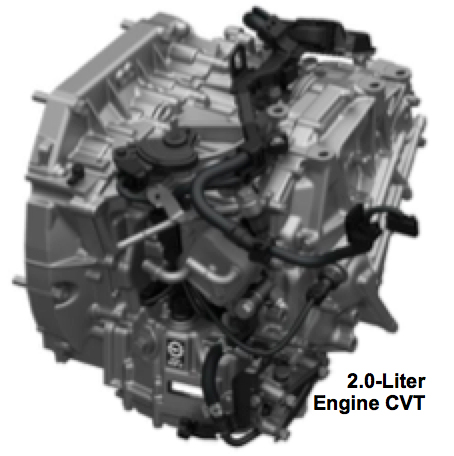
Continuously Variable Transmission for 2.0L i-VTEC
The Civic LX and LX-P which are powered by the 2.0-liter engine offer a CVT (available in the LX and standard in the LX-P) that is a refined version of the CVT that was offered in the previous generation Civic. It features a retuned torque converter, and a new generation of G-Design shift logic.
Continuously Variable Transmission for 1.5L Turbo
Turbo Civic models have a CVT that is an evolution of the CVT transmission offered in Accord 4-cylinder models. In this application, the transmission's final gear ratio is 4.69-percent taller than the Accord CVT on which it's based, to allow for lower engine rpm while cruising. A new generation of G-Design shift logic aids acceleration and has a more familiar driving feel. A new turbine twin-damper design for the torque converter provides tighter control and helps reduce turbocharger lag as the vehicle accelerates.
CVT Common Features
G-Design Shift Feature
Both available Civic CVTs are designed to provide the optimum gear ratio for the driving conditions, and to offer a more natural driving feel than some previous CVT transmissions that may have something of a disconnected "rubber-band" feel compared to a conventional automatic transmission.

The Civic CVTs have a new generation of special G-design shift logic that is designed to offer more immediate acceleration response than either conventional automatics or other CVT designs. When abruptly applying power from a steady-state cruising speed, both Civic CVTs immediately send power to the drive wheels while simultaneously adjusting the gear ratio (seamlessly and progressively downshifting) to smoothly bring the engine to its horsepower peak in a linear way.
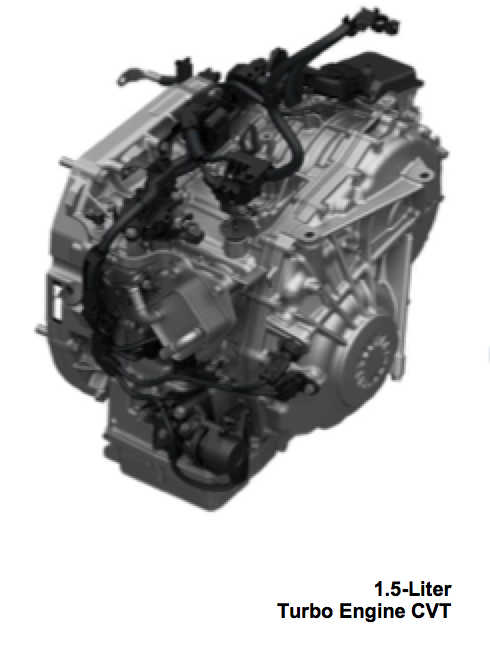
By comparison, a conventional automatic is slower to respond and loses time making multiple downshifts. Since the automatic transmission has a limited number of separate, discrete ratios, even when fully downshifted, it can only approximate the optimum engine rpm as speed increases. This cuts into acceleration.
During full throttle acceleration, the new generation of G-Design shift logic employs stepped ratios as the vehicle speed increases. This helps give the transmission a more "connected" feel as the engine rpm and vehicle speed increase together. This stepped operation also improves acceleration performance incrementally.
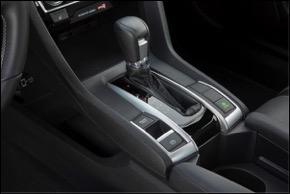
CVT Automatic Modes
The transmission can be operated in three different fully automatic forward modes with the console-mounted straight-gate shifter. The D mode is ideal for most driving situations, and combines fuel efficiency with smooth operation and responsive power when needed. The S mode is for more performance-oriented driving, and features more aggressive transmission mapping to keep engine rpm higher for greater acceleration and response. The L mode is ideal for situations when additional engine braking is desired, such as in mountainous driving.
S-Range Control
To allow the driver to alter the operation of the CVT, the console-mounted gear selector includes an "S" or Sport mode that provides a sport-shift schedule that delays upshifting for more available power, and provides greater engine braking.
6-Speed Manual Transmission
A 6-speed manual transmission (6MT) is standard on the Civic LX. The unit offers smooth and precise shift feel and great efficiency. Compared to the 5-speed manual transmission it replaces in the Civic, the 6-speed transmission has been carefully engineered to deliver state-of-the-art performance and shift action, with reduced internal friction, tighter internal tolerances and improved synchronizers. The transmission also has a more rigid aluminum exterior case, higher-capacity ball bearings, stiffer gear shafts, and greater torque capacity. Refinements to the shift linkage and selector mechanism produce a precise and smooth gear lever shift action. A new constant-mesh helical reverse gear mechanism significantly reduces noise when reverse is selected. A reverse lockout feature prevents the transmission from accidentally being shifted into reverse while the car is moving forward.
Manual Transmission Gear Ratio Comparison
Gear Ratio (X:1) |
2015 Civic 1.8L |
2016 Civic 2.0L |
|
1st |
3.143 |
3.643 |
|
2nd |
1.870 |
2.080 |
|
3rd |
1.235 |
1.361 |
|
4th |
0.949 |
1.024 |
|
5th |
0.727 |
0.830 |
|
6th |
— |
0.686 |
|
Reverse |
3.308 |
3.673 |
|
Final Reduction Ratio |
4.290 |
4.105 |
Continuously Variable Transmission Gear Ratio Comparison
Gear Ratio (X:1) |
2015 Civic 1.8L |
2016 Civic 2.0L |
2016 Civic 1.5L T |
|
Forward |
3.200~0.517 |
2.526~0.408 |
2.645~0.405 |
|
Reverse |
3.428~0.554 |
2.706~1.552 |
1.859~1.265 |
|
Final Reduction Ratio |
3.940 |
4.680 |
4.811 |
Powertrain Feature Comparison
Feature |
2016 Civic 2.0L |
2016 Civic 1.5L T |
|
Engine Type |
L-4 |
L-4 Turbocharged |
|
Displacement (cc) |
1996cc |
1498cc |
|
Horsepower @ rpm |
158 @ 65001 |
174 @ 6,0003 |
|
Torque |
138 @ 42002 |
162 @ 1,700-5,500 (CVT)4 |
|
Feature (cont.) |
2016 Civic 2.0L |
2016 Civic 1.5L T |
|
Bore and Stroke (mm) |
86 x 85.9 |
73 x 89.5 |
|
Compression Ratio |
10.8:1 |
10.6:1 |
|
Fuel Injection |
Port |
Direct |
|
Programmed Fuel Injection (PGM-FI) |
• |
|
|
Valvetrain |
16-Valve DOHC i-VTEC® |
16-Valve DOHC w/VTC |
|
Drive-by-Wire Throttle System |
• |
• |
|
Low-Inertia MONO Turbocharger |
|
• |
|
Variable Intake Valve Lift |
• |
|
|
Intake/Exhaust Variable Cam Timing |
• |
• |
|
Transmission |
6-Speed Manual / CVT |
CVT |
|
Front Wheel Drive |
• |
• |
|
Hill Start Assist |
• |
• |
|
100K +/- Miles No Scheduled Tune-Ups7 |
• |
• |
Fuel Economy and Emissions Ratings
Ratings |
2016 Civic 2.0L |
2016 Civic 1.5L T |
|
EPA Fuel Economy Ratings6 (city / highway/ combined) (anticipated) |
26/38/31 (6MT) |
31/41/35 (CVT) |
|
Recommended fuel |
Regular unleaded 87 octane |
Regular unleaded 87 octane |
|
CARB emissions rating5 |
LEV3-ULEV125/LEV3-SULEV30 |
LEV3-ULEV125/LEV3-SULEV30 |
(See the Specifications and Features section for all data.)
1 158 horsepower @ 6500 rpm (SAE net)
2 138 lb-ft @4200 rpm (SAE net)
3 174 horsepower @ 6000 rpm (SAE net)
4 162 lb-ft @ 1700-5500 rpm (SAE net)
5 CVT models are LEV3-SULEV30-rated in California and states that have adopted California vehicle emission regulations. CVT models in non-CARB states and 6MT models in all 50 states are LEV3-ULEV125-rated.
6 Preliminary mileage ratings determined by Honda. Final 2016 EPA fuel-economy ratings not available at the time of printing. Use for comparison purposes only. Your mileage will vary depending on how you drive and maintain your vehicle, driving conditions and other factors.
7 Does not apply to fluid and filter changes. Will vary with driving conditions. Please see your Honda dealer for details.
2016 Honda Civic Coupe Press Kit - Safety and Driver Assistance
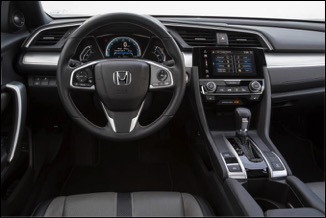
Overview
With advanced, unibody engineering, significant use of high-strength steel, and a wide array of advanced passive-safety features, the 2016 Civic Coupe was designed to achieve a superb level of active and passive safety performance for vehicle occupants – as well as for the occupants of other vehicles and other road users, including motorcycle and bicycle riders and pedestrians.
The Civic Touring Coupe is equipped with Honda Sensing™, among the most comprehensive suites of safety and driver-assistive technologies in the competitive class, which includes Adaptive Cruise Control with Low-Speed Follow.
Standard passive-safety features such as a new driver's Spiral Airbag and a new front passenger's safety vent airbag, SmartVent® front side airbags, and side curtain airbags with rollover sensor help protect occupants in a collision. In addition, the greater use of high-strength steel and advanced crash engineering features, including its Advanced Compatibility Engineering™ (ACE™) body structure, new crash stroke front frame rails, and tailor-tempered B-pillars and rear frame structures, helps better protect occupants in a collision while minimizing weight for superior fuel efficiency.
Key Safety and Driver Assistive Features
- Next-generation Advanced Compatibility Engineering™ (ACE™) body structure with new crash stroke design
- Hot-stamped ultra-high-strength steel A-pillar and outer sill
- Multi-Angle Rearview Camera1
- Expanded View Driver's Mirror
- Seatbelts with Crash Locking Tongue*
- Indirect Tire Pressure Monitoring System (TPMS)2 *
- Honda LaneWatch™3
- Civic Touring Coupe Honda Sensing™ package:
- Collision Mitigation Braking System (CMBS)4 *
- Forward Collision Warning (FCW)5 * – Integrated into CMBS
- Lane Departure Warning (LDW)6 * – Integrated into RDM
- Road Departure Mitigation (RDM)7 *
- Lane Keeping Assist System (LKAS)8 *
- Adaptive Cruise Control (ACC)9 * with Low Speed Follow (LSF) *^
* First for Civic
^ First for Honda
Top Safety Ratings
The Civic was engineered to earn top-class collision safety ratings. In particular, these include a 5-Star Overall Vehicle Score from the National Highway Traffic Safety Administration (NHTSA) in its New Car Assessment Program (NCAP), along with a TOP SAFETY PICK (LX through EX-L trims) and TOP SAFETY PICK+ (Touring trim) rating from the Insurance Institute for Highway Safety (IIHS). A significant area of improvement is the goal of achieving a Good rating in the latest IIHS small overlap frontal crash test.
Crash Safety Ratings (Predicted)
Rating |
2016 Civic (Internal test results) |
|
NHTSA Overall Vehicle Score |
5-Stars |
|
NHTSA Overall Frontal Crash |
5-Stars |
|
NHTSA Overall Side Crash |
5-Stars |
|
NHTSA Rollover |
5-Stars |
|
IIHS safety award |
TOP SAFETY PICK (LX thru EX-L) |
|
IIHS Small overlap front |
Good |
|
IIHS Moderate overlap front |
Good |
|
IIHS Side |
Good |
|
IIHS Roof strength |
Good |
|
IIHS Head restraints & seats |
Good |
|
IIHS Front crash prevention |
Superior |
Pedestrian Injury Mitigation Design
Structures in the front of the 2016 Civic are designed to help absorb energy in the event of a collision with a pedestrian. Research by Honda shows that the following features can dramatically improve a pedestrian's chance of survival if struck by a moving vehicle.

Specific pedestrian head injury mitigation features include:
- Hood is designed to deform if contact is made with either an adult or a child pedestrian
- Sufficient clearance exists between the hood and hard engine parts, allowing the hood to deform if impacted by a pedestrian
- Windshield base has a unique section structure for efficient impact energy absorption
- Energy-absorbing fender mounts and supports
- Breakaway windshield wiper pivots
- Deformable hood hinges
Vehicle Stability Assist™ (VSA®) with Traction Control
Vehicle Stability Assist™ (VSA®)10 is an Electronic Stability Control system that works in conjunction with the Drive-by-Wire™ throttle and its 4-channel ABS systems to enhance control capability while the vehicle is accelerating, braking, cornering or when the driver makes a sudden maneuver. VSA functions by applying brake force to one or more wheels independently while also managing the throttle, ignition and fuel systems to help the vehicle maintain the driver's intended path of travel.
The VSA system constantly analyzes data from sensors that monitor wheel speed, steering input, lateral and longitudinal G forces and yaw rate. It compares the driver's control inputs with the vehicle's actual response. Whenever the actual response falls outside of a predetermined acceptable range, VSA intervenes with a corrective action. For instance, if VSA detects an oversteer condition, the system may apply braking force to the outside front and rear wheels to counteract the unintended yawing effect. In the event of understeer, VSA may apply braking to the inside rear wheel while reducing engine power to help return the vehicle to its intended course.
VSA also provides a limited-slip differential effect for the front wheels by applying braking force to a slipping wheel, thereby redirecting driving force to the wheel with more traction. VSA is calibrated to function in a near-transparent manner, and in many cases a driver will not even be aware of its operation. However, anytime the system is enhancing vehicle stability, an indicator light flashes in the instrument cluster. While the driver can reduce the traction control effectiveness allowing more wheel slip during stuck condition by pressing the VSA button, ABS remains fully operational at all times.
Motion-Adaptive Electric Power Steering (EPS)
Motion-Adaptive Electric Power Steering (EPS) is standard on all 2016 Civic models. The system incorporates driving stability technology that initiates steering inputs that prompt the driver to steer in the correct direction during cornering and in slippery road conditions. Using vehicle speed and steering angle data, Motion-Adaptive EPS works with Honda's Vehicle Stability Assist (VSA®)10 and Electric Power Steering to detect instability in slippery road conditions both during cornering and under braking and automatically initiates steering inputs aimed at prompting the driver to steer in the correct direction. This advanced technology supports the driver's action in operating the vehicle more safely and comfortably.
Two examples of how Motion-Adaptive Electric Power Steering (EPS) functions in conjunction with VSA are:
Stabilizes Vehicle under Braking
This function helps to correct the driver's steering input to reduce vehicle instability when the driver is braking hard on road surfaces with different friction coefficients (such as pavement that is partially covered with dirt or snow).
Mitigates Understeer and Oversteer
To mitigate potential understeer or oversteer situations, the system helps correct the steering inputs to help the driver trace the curve.
(See the Chassis section for more information.)
Brake Assist
A function of the VSA® system10, the Brake Assist feature recognizes heavy braking situations and almost instantly applies added braking force. This Brake Assist feature is controlled by a special logic in the system that evaluates the pedal application rate and force to recognize a panic stop situation. At that point, the VSA modulator pump increases braking pressure while the pedal is still being pressed to ensure maximum stopping force, an action that can help shorten braking distance.
Advanced 4-Channel ABS with Electronic Brake Distribution
For the first time, all Civic trims are fitted with 4-wheel disc brakes with four-channel anti-lock braking (ABS). The ABS system also incorporates Electronic Brake Distribution (EBD) circuitry that automatically proportions front-to-rear brake force based on the vehicle's dynamic load on each wheel. Larger front brake disc dimensions and a larger master cylinder improve stopping performance and pedal feel. (See the Chassis section for more information.)
Seatbelts
The front seatbelts are equipped with pyrotechnic pretensioners and load limiting retractors to help minimize injury potential in a frontal collision. When an impact occurs, the automatic tensioner tightens the seatbelt (shoulder and lap) to help hold the seat occupant firmly in position. Each front seatbelt retractor incorporates a load limiter that works in conjunction with the automatic tensioner. The load limiter functions by permitting a small amount of controlled seatbelt slack shortly after the automatic tensioner is activated to limit the peak restraining forces and thereby reducing the potential of serious injury. The front seatbelts also feature adjustable-height shoulder anchors. To help increase seat-belt usage, a reminder for the driver and front passenger has been incorporated into the instrument cluster. After starting the vehicle, a weight sensor detects whether the front passenger seat is occupied. If the driver or front passenger has not already fastened the seat belt, an icon in the cluster illuminates and a chime sounds as a reminder to do so.
Crash Locking Tongue
The Civic's front seatbelts use a "crash locking tongue" latch plate design that locks the webbing in place during a collision, helping to better restrain the occupant. During normal driving conditions the seatbelt webbing moves freely through the latch plate in the normal manner. However in the event of a collision, forces exerted on the lap and shoulder sections of the seatbelt push the webbing against a "reaction surface" inside the latch plate, locking the webbing in place.
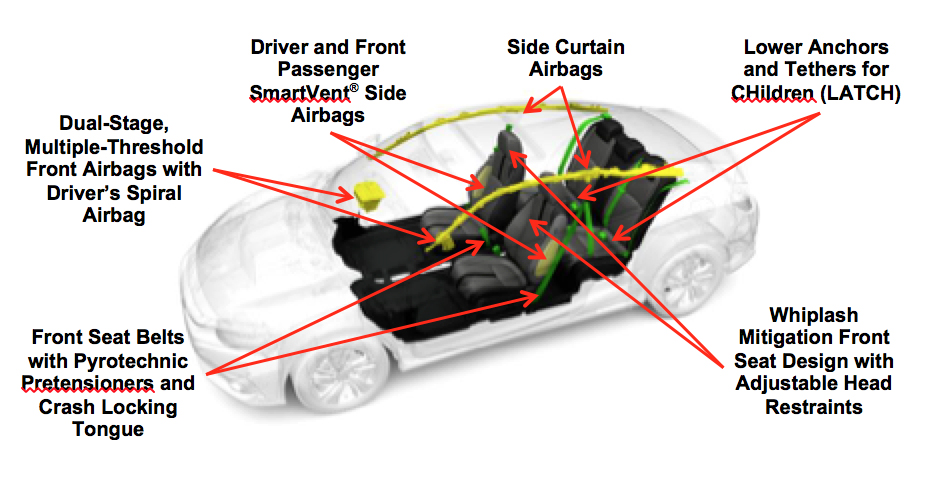
Dual-stage, Multiple-Threshold Front Airbags
Both the driver and front passenger are protected by advanced front airbags (SRS) that incorporate dual-stage and multiple-threshold activation technology. If deployed, these airbags are capable of being inflated at different rates depending on crash severity, seatbelt usage and other factors. Like other Honda vehicles, the driver's front airbag is located in the steering wheel while the passenger airbag is located on the top of the dash. When deployed, the passenger airbag inflates upward and then rearward to maximize its protective potential while reducing the likelihood of injuries caused by airbag deployment.
Driver's Spiral Airbag
In a first for the North American market, the 2016 Civic incorporates spiral stitching into the driver's front airbag. The spiral nature of the airbag promotes early restraint and maintains a constant pressure by reducing volume early and maximizing volume later in deployment.
Front Passenger's Safety Vent Airbag
A Honda first, the passenger's front airbag in the 2016 Civic features a new safety vent system that increases safety for the front passenger in a frontal collision involving an airbag deployment. If the passenger is sitting "out of position" – such as leaning forward in the pathway of the airbag deployment – the auxiliary vents remain open, directing a significant amount of gas out and away from the occupant. As a result, the potential for injury from the airbag striking an out-of-position passenger is reduced. However if the passenger is correctly seated, the airbag has an internal tether that will close the auxiliary vents at the necessary time to provide optimal occupant restraint.
Driver and Front Passenger SmartVent® Side Airbags
Side airbags mounted in the outboard area of each front seatback are designed to help provide pelvic and thorax protection for the driver and front passenger in the event of a severe side impact. In the 2016 Civic, a revised side airbag design allows the side airbags to deploy in a manner that helps mitigate the risk of injury to a smaller seat occupant.
Side Curtain Airbags
All outboard seating positions are protected by side curtain airbags with a rollover sensor system. In the event of a severe side impact, the side curtain airbags deploy from modules in the roof, providing a significant level of head protection in the window area. In the unlikely event of a rollover, a roll-rate sensor, along with multiple G sensors determine the rate of roll and deploy the side curtain airbags accordingly. The side curtain airbags will also deploy and provide head protection in frontal impacts as necessary. For example, small overlap impacts, where the front corner of the vehicle collides with a solid object.
Like the other airbag systems in the vehicle, the side curtain system utilizes sensors to determine the most appropriate timing of airbag deployment. To provide the optimal level of protection for occupants, testing was performed to determine the most appropriate timing and rate of deployment in the unlikely event of a rollover. The system uses algorithms to continually evaluate the situation and determines whether a rollover is imminent. The roll-rate sensor and multiple G sensors (accelerometers) determine the "scenario" and calculate the angle of roll and the speed of the vehicle in order to deploy the airbags at the correct point for optimum protection.
In the case of a rollover, the side curtain airbags on both sides of the vehicle will deploy. However, in the event of a sufficient side impact that does not result in a rollover, only the airbags on the impacted side of the vehicle will deploy. The airbag maintains full inflation for approximately six seconds after inflation to allow for the increased duration of a rollover accident.
Whiplash Mitigation Front Seat Design
Both of the front seats are designed to help mitigate the severity of neck injuries in the event of a rear impact. In the event of a rear crash, the seat efficiently disperses rear impact forces against the occupant as the seatback cushion compresses relative to the occupant's head. The seatback springs are optimized so that in a rear crash, when the seatback is pushed forward into the occupant, the seat will absorb the occupant's mass in manner that can help minimize the severity of a whiplash injury.
Adjustable Head Restraints
The front seats feature individually adjustable head restraints. The front head restraints are 0.8 inches narrower than in the previous Civic Coupe, substantially improving visibility for the rear-seat passengers.
Lower Anchors and Tethers for CHildren (LATCH)
In a first for Civic, all models are equipped with a child seat-mounting system called LATCH (Lower Anchors and Tethers for CHildren). Both of the second-row outboard seating positions are fitted with dedicated LATCH lower anchor attachment points. Tether anchors are provided the remaining middle seating position.
The LATCH system provides two lower anchors and an upper tether anchor. When used with a compatible child seat, the LATCH system provides attachment points between the child seat and the vehicle seat without having to use the vehicle's seat belts.
Additionally, all seat belts except the driver's are equipped with a locking retractor that can be used to help secure any child seat. Both rear side doors are also equipped with childproof door locks for added protection.
Indirect Tire Pressure Monitoring System
New for Civic, indirect Tire Pressure Monitoring System (TPMS)2 uses wheel-speed data collected by the 4-channel ABS system to determine when the air pressure in one tire drops below the recommended minimum. When this occurs, a symbol illuminates on the instrument panel to warn the driver. Indirect TPMS is simpler and lighter than traditional wheel-sensor TPMS, resulting in lower overall vehicle weight, which in turn helps improve handling and fuel efficiency. (See the Chassis section for more information.)
Expanded View Driver's Mirror
All Civic models are equipped with an Expanded View Driver's Mirror that increases the driver's field of vision to provide a better view of objects to the back and side of the vehicle. The Expanded View Driver's Mirror uses a flat reflective plane on the inner portion of the mirror closest to the door, while the outer portion of the mirror uses a convex element to provide a broader field of view.
Multi-Angle Rearview Camera
All 2015 and newer Honda models incorporate a multi-angle rearview camera1. Viewable on the Coupe LX and LX-P's 5-inch color LCD screen and the Coupe EX-T and above trims' 7-inch Display Audio touchscreen, the camera can show a top view, normal or wide view when the transmission is in Reverse. The LX trim features static guidelines that help the driver better judge distances, while EX-T and above trims have dynamic guidelines that project the vehicle's future path based on the driver's steering inputs. See the following page for an image of the Display Audio screen views. (See the Interior section for more information.)

Honda LaneWatch™
Civic EX-T Coupe and above trims include the Honda LaneWatch™3 display. Honda LaneWatch uses a camera located at the bottom the passenger-side exterior mirror to display a wide-angle view of the passenger side roadway on the new 7-inch Display Audio touchscreen. The image appears when the right turn signal is activated or when a button on the end of the turn signal stalk is pressed. (See the Interior section for more information.)
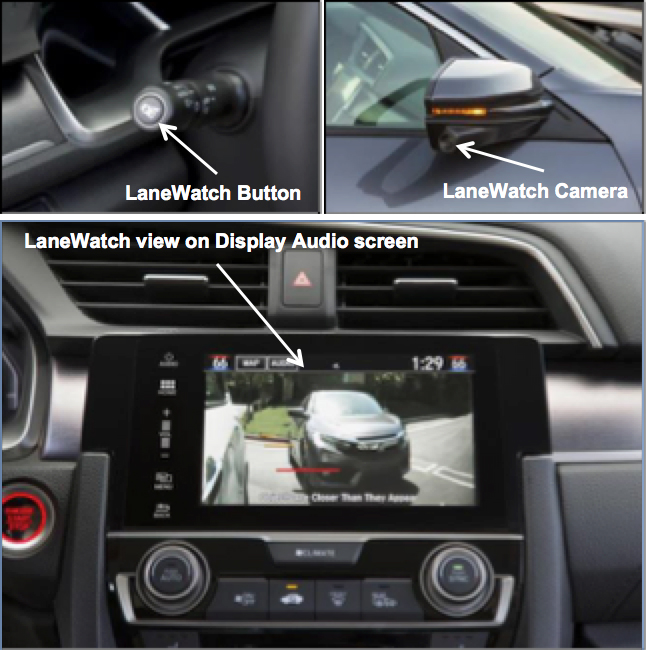
The typical field of view for a passenger-side mirror is approximately 18 to 22 degrees, but the LaneWatch™ display field-of-view is about four times greater, or approximately 80 degrees. The system helps the driver to see traffic, pedestrians or objects not always seen using the mirror alone. To help make judging distance easier, three reference lines are shown. Drivers should visually confirm roadway conditions prior to changing lanes.
LaneWatch™ can be customized to suit the driver's preferences. Turn-signal activation of the LaneWatch™ system can be switched on or off, as can the three on-screen reference lines. Screen brightness, contrast and black level are also adjustable.
Honda Sensing™
Comprised of a suite of safety and driver assistive features, Honda Sensing™ helps provide greater awareness of driving conditions around the vehicle. Honda Sensing™ is included as standard equipment on the Touring trim.
Honda Sensing™ features include the following:
- Collision Mitigation Braking System (CMBS)*4
- Forward Collision Warning (FCW)*5 – Integrated with CMBS
- Lane Keeping Assist System (LKAS)*8
- Road Departure Mitigation (RDM)*7
- Lane Departure Warning (LDW)*6 – Integrated with RDM
- Adaptive Cruise Control (ACC)* with Low Speed Follow (LSF)*^
* First for Civic
^ First for Honda
Collision Mitigation Braking System™ (CMBS™)
In a first for Civic Coupe, Touring Coupe offers the Collision Mitigation Braking System™ (CMBS™)4, one of the most sophisticated driver-assistive technologies available. A millimeter wave radar unit, located behind the front grille, and monocular camera, located between the rearview mirror and windshield, scans traffic conditions ahead of the Civic.
When the system determines a collision is possible with a detected vehicle, the integrated Forward Collision Warning (FCW)5 system's visual and audible alerts prompt the driver to take corrective actions. The visual alert appears on the Multi-Information Display (MID). If the situation is not resolved, CMBS can apply different levels of autonomous braking action to help reduce vehicle speed and eventual collision forces, and therefore to help reduce the severity of a collision if the driver doesn't take corrective action on their own. The radar unit and camera work simultaneously and cooperatively to control the VSA10 modulator, which initiates any required braking.
Due to the effectiveness of its monocular camera, CMBS can recognize shapes and differentiate between a vehicle and a pedestrian, warning the driver in each case. See the 2016 Civic CMBS animation for an active representation of system operation.
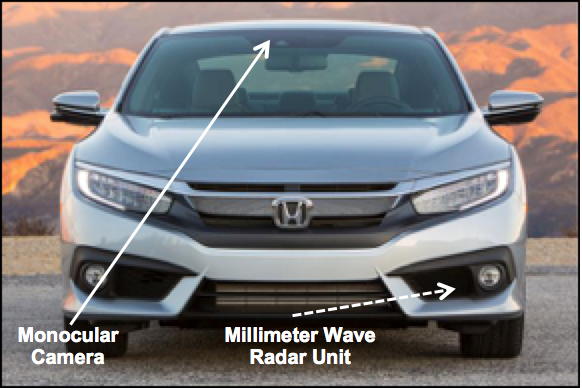
It is important to note that CMBS cannot detect all objects ahead, nor is it intended to replace the driver's assessment of traffic conditions and control of the vehicle. The driver must intervene in certain situations, and must always be attentive when using the system. Although in many cases CMBS will stop the vehicle, it is not intended to apply enough braking force to prevent all collisions. Based on the conditions, the system also may not perform all visual- and audible-alert stages, and may instead automatically engage the brakes if the system deems it necessary. CMBS may be turned off by pressing the CMBS button on the left side of the dash.
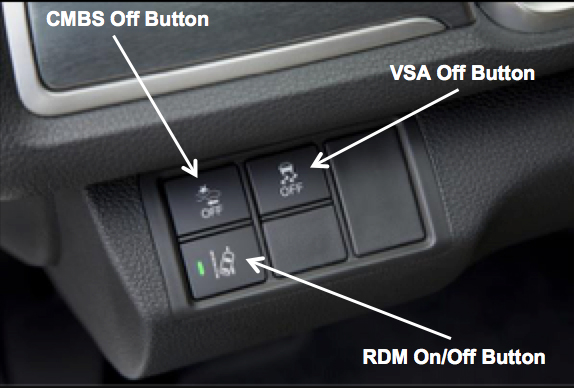
Forward Collision Warning (FCW) – Integrated with CMBS
In another Civic first, Forward Collision Warning (FCW)5 is included in Civic Touring Coupe. Integrated with CMBS, Forward Collision Warning (FCW) uses the monocular camera to detect vehicles ahead and to determine whether a collision is likely. This reduces the stress of driving in traffic, while also contributing to an increased level of passive safety.
If the FCW system detects a vehicle in front of the Civic and then determines that a collision may occur (due to a speed differential between the two vehicles), it will trigger visual and audible alerts for the driver. These include a "BRAKE" message on the Multi-Information Display (MID), and a series of beeps to alert the driver to apply the brake pedal. The FCW system will not automatically brake, and the driver remains responsible for safely operating the vehicle and avoiding collisions. If the driver doesn't respond to the FCW warnings, however, the CMBS is triggered into operation.
Drivers may adjust the distance at which FCW alerts occur by pressing the "SETTINGS" button, selecting "Vehicle Settings," and then choosing "Driver Assist System Setup" and the "Forward Collision Warning Distance" option. At this point they may choose between "Long," "Normal" or "Short." And if they choose to, drivers may also select "Off" to disable the FCW system entirely.
Note that the FCW system cannot detect all objects ahead and may not detect a given object; accuracy will vary based on weather, speed and other factors.
Lane Keeping Assist System (LKAS)
The Lane Keeping Assist System (LKAS)8 provides a less stressful driving experience by reducing the need for steering correction movements and driving effort on the highway. LKAS uses a camera to read lane markings and uses the Electric Power Steering to assist the driver in maintaining their position within the lane.

Designed for the U.S. road structure, the system uses a monocular camera mounted on the upper portion of the windshield to identify painted lanes, Botts' Dots and Cat Eye markers at speeds between 45 mph and 90 mph. When LKAS senses that the driver is drifting from the middle of a detected lane, the system generates corrective steering torque to assist the driver in maintaining lane position.
LKAS may be activated and deactivated using a switch located on the lower right part of the steering wheel. The system will suspend operation after several seconds if the driver takes his or her hands off the wheel, accompanied by a visual warning in the MID, resuming when the driver makes a steering input. See the 2016 Civic LKAS Animation for an active representation of system operation.
Road Departure Mitigation (RDM)
Integrating LDW6 (see below), Road Departure Mitigation (RDM)7 uses a monocular camera (mounted on the upper portion of the windshield) to identify solid or dashed painted lane lines, Botts' dots and Catseye markers. RDM uses steering force, via EPS to help the Civic stay in its lane and, if the vehicle is detected leaving a lane marked by solid lines, braking force, via VSA10, to keep the vehicle from departing the lane or roadway altogether.
The monocular camera recognizes lane features and identifies the lane. If the RDM system determines that the Civic is about to leave a detected lane, it will provide steering assist (primary) and in rare occasions when steering assist is not sufficient to avoid leaving a lane marked by a solid line, braking assist, to help the driver stay on the road. RDM is integrated with the Vehicle Stability Assist (VSA) system to provide moderate braking, and with the Electric Power Steering (EPS) system to provide steering input.
Multiple visual and audible warnings alert the driver when the RDM system is taking corrective action. These include a lane departure warning on the driver's Driver Information Interface (DII) along with an audible warning.
RDM also has a customizable initial warning of either a steering wheel shake/vibration, or an audible alert. This can be customized in the vehicle settings. RDM can be turned off by using the RDM Off button on the left of the dash. See the 2016 Civic RDM Animation for an active representation of system operation.
Lane Departure Warning (LDW) – Integrated with RDM
Lane Departure Warning (LDW)6 is designed to alert the driver if the vehicle is leaving a detected lane without the turn signal being activated. The system functions at speeds from 45 to 90 mph on straight or slightly curved roads, alerting the driver of deviations from a detected lane. The LDW system utilizes the same upper front windshield camera used for CMBS® and LKAS8 and provides the visual and auditory alerts prior to the other systems actively engaging.
If the vehicle begins to move out of a detected lane without the turn signal activated, LDW illuminates a Lane Departure message on the Multi-Information Display (MID) and sounds an audible warning, advising the driver to take appropriate action. The system can be activated and deactivated by pressing the LDW button located on the instrument panel, to the left of the steering column.
There are certain conditions under which the system may not engage or operate, including inclement weather (e.g., snow, ice or heavy rain) and extreme cabin heat (due to operability of the camera). The system will automatically suspend operation when the brakes are applied or the turn signals are used. LDW may not detect all lane markings or lane departures; accuracy will vary based on weather, speed and road condition. The driver remains responsible for safely operating the vehicle.
Adaptive Cruise Control (ACC) with Low-Speed Follow (LSF)
Adaptive Cruise Control (ACC)9 allows the driver to set a desired speed and following interval from a vehicle detected ahead, allowing the use of cruise control in light traffic conditions. This significantly reduces the driver stress of driving in traffic. The system uses the millimeter wave radar and monocular camera to continually track the distance to the vehicle detected ahead, and then adjusts the Civic's speed to maintain the set following interval. A short, medium, long, or extra-long interval can be selected When required, the Civic autonomously brakes using the Vehicle Stability Assist™ (VSA®)10 modulator.
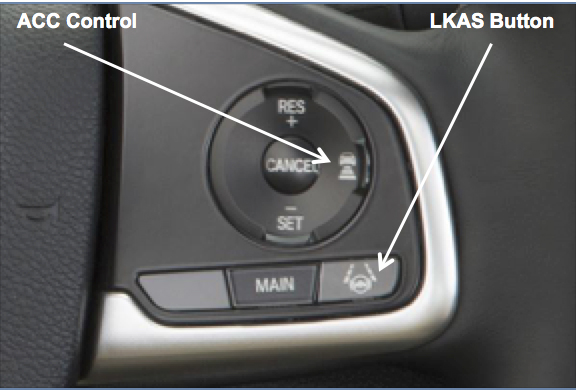
Integrated Low-Speed Follow (LSF) extends the automatic following capability to stop-and-go traffic situations (down to 0 mph).
ACC operates in the following ways in the listed circumstances:
- A preceding vehicle is detected in the lane ahead – Decelerates automatically, if required, and then controls the following distance.
- The preceding vehicle slows to a stop – Stops automatically and remains stationary.
- The preceding vehicle accelerates from a stop – Resumes following when the SET or RES switch or accelerator pedal is operated.
- Another vehicle merges in between the Civic and the preceding vehicle – Automatically switches "targets" to the nearest detected preceding vehicle.
- The preceding vehicle exits the lane – ACC system continues at cruise-control speed previously selected by driver (25 to 90 mph).
A Driver Information Interface (DII) message and audible warning alert the driver when the ACC function is activated. See the 2016 Civic ACC Animation for an active representation of system operation.
Safety and Driver Assistive Features
| Active Safety Features |
LX |
LX-P |
EX-T |
EX-L |
Touring |
|
Collision Mitigation Braking System™ (CMBS™)4 |
|
|
|
|
• |
|
Forward Collision Warning (FCW)5 |
|
|
|
|
• |
|
Road Departure Mitigation (RDM)7 |
|
|
|
|
• |
|
Lane Departure Warning (LDW)6 |
|
|
|
|
• |
|
Vehicle Stability Assist™ (VSA®)10 with Traction Control |
• |
• |
• |
• |
• |
|
Advanced 4-Channel ABS |
• |
• |
• |
• |
• |
|
Electronic Brake Distribution (EDB) |
• |
• |
• |
• |
• |
|
Brake Assist |
• |
• |
• |
• |
• |
|
Multi-angle rearview camera with guidelines1 |
• |
• |
|
|
|
|
Multi-angle rearview camera with dynamic guidelines1 |
|
|
• |
• |
• |
|
Indirect Tire Pressure Monitoring System (TPMS)2 |
• |
• |
• |
• |
• |
|
Daytime Running Lights (DRL) |
LED |
LED |
LED |
LED |
LED |
|
Passive Safety Features |
LX |
LX-P |
EX-T |
EX-L |
Touring |
|
Advanced Compatibility Engineering™ (ACE™) body structure |
• |
• |
• |
• |
• |
|
Dual-Stage, Multiple-Threshold Front Airbags (SRS) |
• |
• |
• |
• |
• |
|
Driver Airbag with Spiral Technology |
• |
• |
• |
• |
• |
|
Safety vent passenger front airbag |
• |
• |
• |
• |
• |
|
Driver and Front Passenger SmartVent® Side Airbags |
• |
• |
• |
• |
• |
|
Side Curtain Airbags with Rollover Sensor |
• |
• |
• |
• |
• |
|
Passive Safety Features (cont.) |
LX |
LX-P |
EX-T |
EX-L |
Touring |
|
3-Point Seat Belts at all Seating Positions |
• |
• |
• |
• |
• |
|
Front 3-Point Seat Belts with Automatic Tensioning System |
• |
• |
• |
• |
• |
|
Lower Anchors and Tethers for Children (LATCH): 2nd-Row outer |
• |
• |
• |
• |
• |
|
Driver's and Front Passenger's Seat-Belt Reminder |
• |
• |
• |
• |
• |
|
Driver Assistive Features |
LX |
LX-P |
EX-T |
EX-L |
Touring |
|
Lane Keeping Assist System (LKAS)8 |
|
|
|
|
• |
|
Adaptive Cruise Control (ACC)9 with Low Speed Follow (LSF) |
|
|
|
|
• |
|
Honda LaneWatch™3 |
|
|
• |
• |
• |
|
Expanded View Driver's Mirror |
• |
• |
• |
• |
• |
(See the Specifications and Features section for all data.)
1 Always visually confirm that it is safe to drive before backing up; the rearview camera display does not provide complete information about all conditions and objects at the rear of your vehicle.
2 For optimal tire wear and performance, tire pressure should be checked regularly with a gauge. Do not rely solely on the monitor system. Please see your Honda dealer for details.
3 Display accuracy will vary based on weather, size of object and speed, and the display may not show all relevant traffic. The display is not a substitute for your own direct visual assessment of traffic conditions before changing lanes.
4 CMBS cannot detect all objects ahead and may not detect a given object; accuracy will vary based on weather, speed and other factors. System operation affected by extreme interior heat. System designed to mitigate crash forces. Driver remains responsible for safely operating vehicle and avoiding collisions.
5 FCW cannot detect all objects ahead and may not detect a given object; accuracy will vary based on weather, speed and other factors. System operation affected by extreme interior heat. FCW does not include a braking function. Driver remains responsible for safely operating vehicle and avoiding collisions.
6 LDW only alerts drivers when lane drift is detected without a turn signal in use. LDW may not detect all lane markings or lane departures; accuracy will vary based on weather, speed and road condition. System operation affected by extreme interior heat. Driver remains responsible for safely operating vehicle and avoiding collisions.
7 Road Departure Mitigation only alerts drivers when lane drift is detected without a turn signal in use and can apply mild steering torque to assist driver in maintaining proper lane position and/or brake pressure to slow the vehicle's departure from a detected lane. Road Departure Mitigation may not detect all lane markings or lane departures; accuracy will vary based on weather, speed and road condition. System operation affected by extreme interior heat. Driver remains responsible for safely operating vehicle and avoiding collisions.
8 LKAS only assists the driver in maintaining proper lane position when lane markings are identified without a turn signal in use and can only apply mild steering torque to assist. LKAS may not detect all lane markings or lane departures; accuracy will vary based on weather, speed and road condition. System operation affected by extreme interior heat. Driver remains responsible for safely operating vehicle and avoiding collisions.
9 ACC cannot detect all objects ahead and may not detect a given object; accuracy will vary based on weather, speed and other factors. ACC should not be used in heavy traffic, poor weather or on winding roads. The driver remains responsible to slow or stop the vehicle to avoid a collision.
10 VSA is not a substitute for safe driving. It cannot correct the vehicle's course in every situation or compensate for reckless driving. Control of the vehicle always remains with the driver.
The Most In-Depth Honda Vehicle Shopper's Research - Anywhere!



